Perception of Consumers towards Afterpay Payment Service in Australia
VerifiedAdded on 2022/12/23
|44
|8737
|79
AI Summary
This report evaluates the perception of consumers in Australia towards Afterpay as a payment service tool. It analyzes the impact on purchasing behavior and satisfaction. The study finds that a majority of millennials prefer Afterpay over other online payment methods, but cash on delivery is still widely used. The report also discusses the growth of electronic payment methods and the competition among payment service providers in Australia.
Contribute Materials
Your contribution can guide someone’s learning journey. Share your
documents today.

Running head: MANAGEMENT
Management
Name of the Student
Name of the University
Author Note
Management
Name of the Student
Name of the University
Author Note
Secure Best Marks with AI Grader
Need help grading? Try our AI Grader for instant feedback on your assignments.
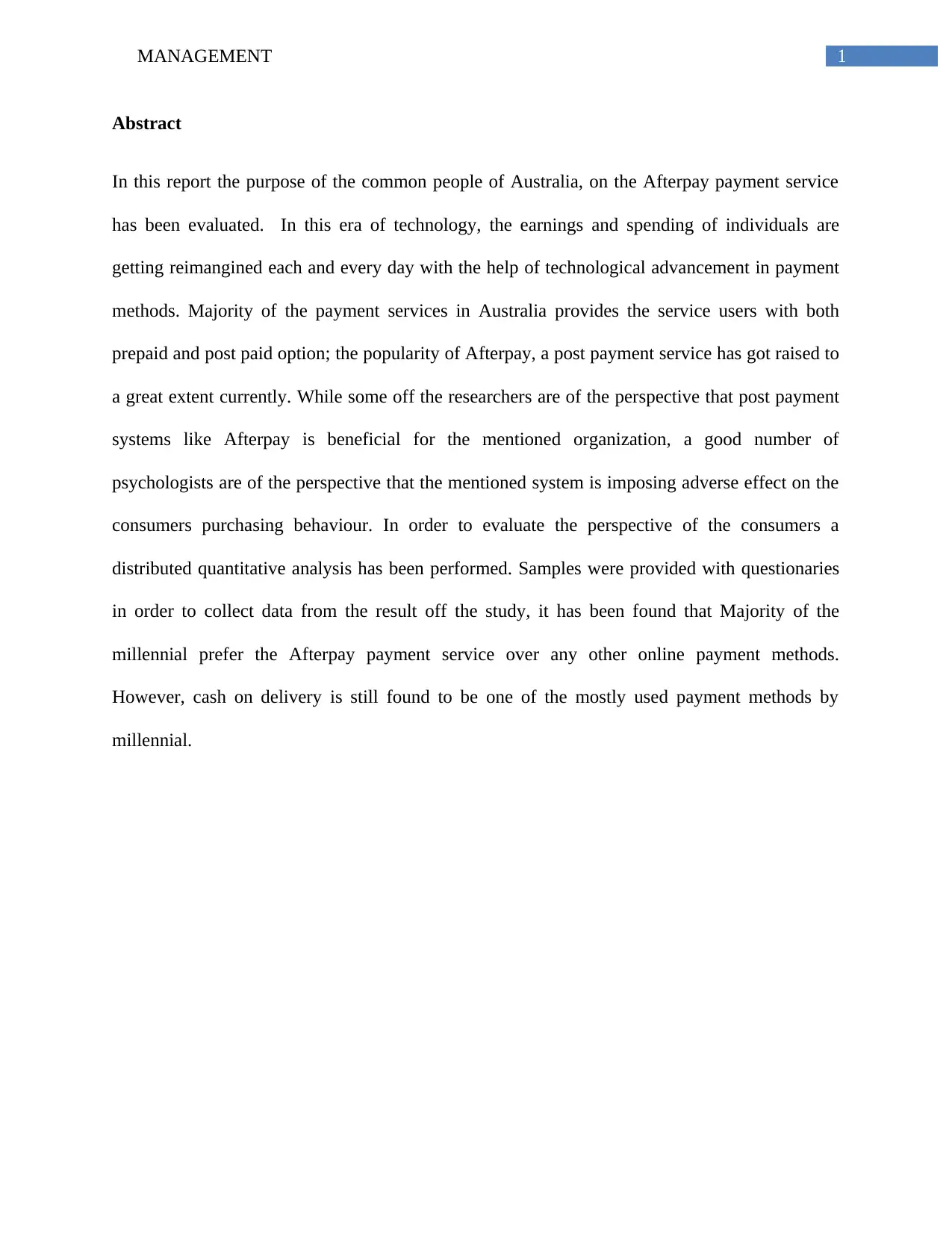
1MANAGEMENT
Abstract
In this report the purpose of the common people of Australia, on the Afterpay payment service
has been evaluated. In this era of technology, the earnings and spending of individuals are
getting reimangined each and every day with the help of technological advancement in payment
methods. Majority of the payment services in Australia provides the service users with both
prepaid and post paid option; the popularity of Afterpay, a post payment service has got raised to
a great extent currently. While some off the researchers are of the perspective that post payment
systems like Afterpay is beneficial for the mentioned organization, a good number of
psychologists are of the perspective that the mentioned system is imposing adverse effect on the
consumers purchasing behaviour. In order to evaluate the perspective of the consumers a
distributed quantitative analysis has been performed. Samples were provided with questionaries
in order to collect data from the result off the study, it has been found that Majority of the
millennial prefer the Afterpay payment service over any other online payment methods.
However, cash on delivery is still found to be one of the mostly used payment methods by
millennial.
Abstract
In this report the purpose of the common people of Australia, on the Afterpay payment service
has been evaluated. In this era of technology, the earnings and spending of individuals are
getting reimangined each and every day with the help of technological advancement in payment
methods. Majority of the payment services in Australia provides the service users with both
prepaid and post paid option; the popularity of Afterpay, a post payment service has got raised to
a great extent currently. While some off the researchers are of the perspective that post payment
systems like Afterpay is beneficial for the mentioned organization, a good number of
psychologists are of the perspective that the mentioned system is imposing adverse effect on the
consumers purchasing behaviour. In order to evaluate the perspective of the consumers a
distributed quantitative analysis has been performed. Samples were provided with questionaries
in order to collect data from the result off the study, it has been found that Majority of the
millennial prefer the Afterpay payment service over any other online payment methods.
However, cash on delivery is still found to be one of the mostly used payment methods by
millennial.
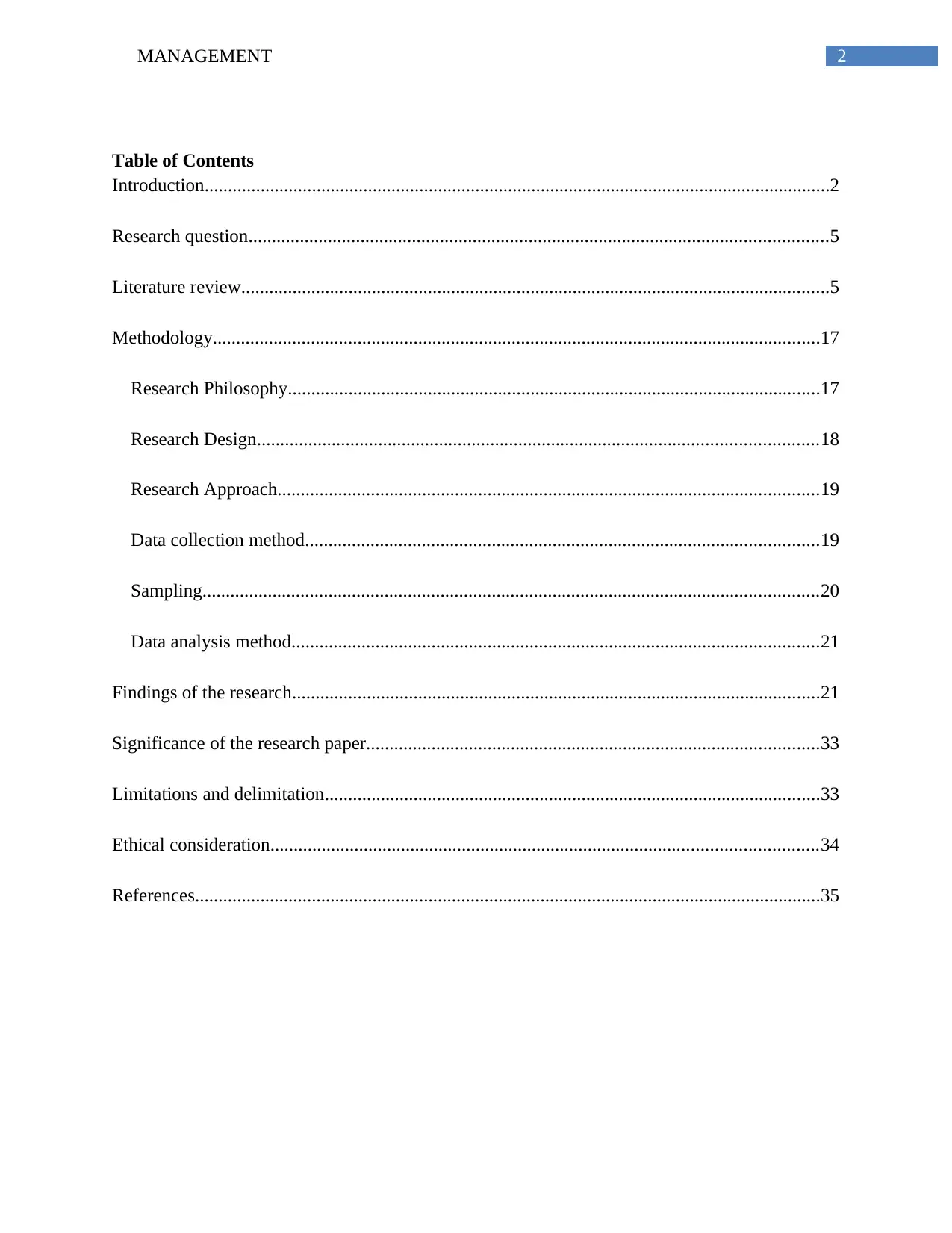
2MANAGEMENT
Table of Contents
Introduction......................................................................................................................................2
Research question............................................................................................................................5
Literature review..............................................................................................................................5
Methodology..................................................................................................................................17
Research Philosophy..................................................................................................................17
Research Design........................................................................................................................18
Research Approach....................................................................................................................19
Data collection method..............................................................................................................19
Sampling....................................................................................................................................20
Data analysis method.................................................................................................................21
Findings of the research.................................................................................................................21
Significance of the research paper.................................................................................................33
Limitations and delimitation..........................................................................................................33
Ethical consideration.....................................................................................................................34
References......................................................................................................................................35
Table of Contents
Introduction......................................................................................................................................2
Research question............................................................................................................................5
Literature review..............................................................................................................................5
Methodology..................................................................................................................................17
Research Philosophy..................................................................................................................17
Research Design........................................................................................................................18
Research Approach....................................................................................................................19
Data collection method..............................................................................................................19
Sampling....................................................................................................................................20
Data analysis method.................................................................................................................21
Findings of the research.................................................................................................................21
Significance of the research paper.................................................................................................33
Limitations and delimitation..........................................................................................................33
Ethical consideration.....................................................................................................................34
References......................................................................................................................................35
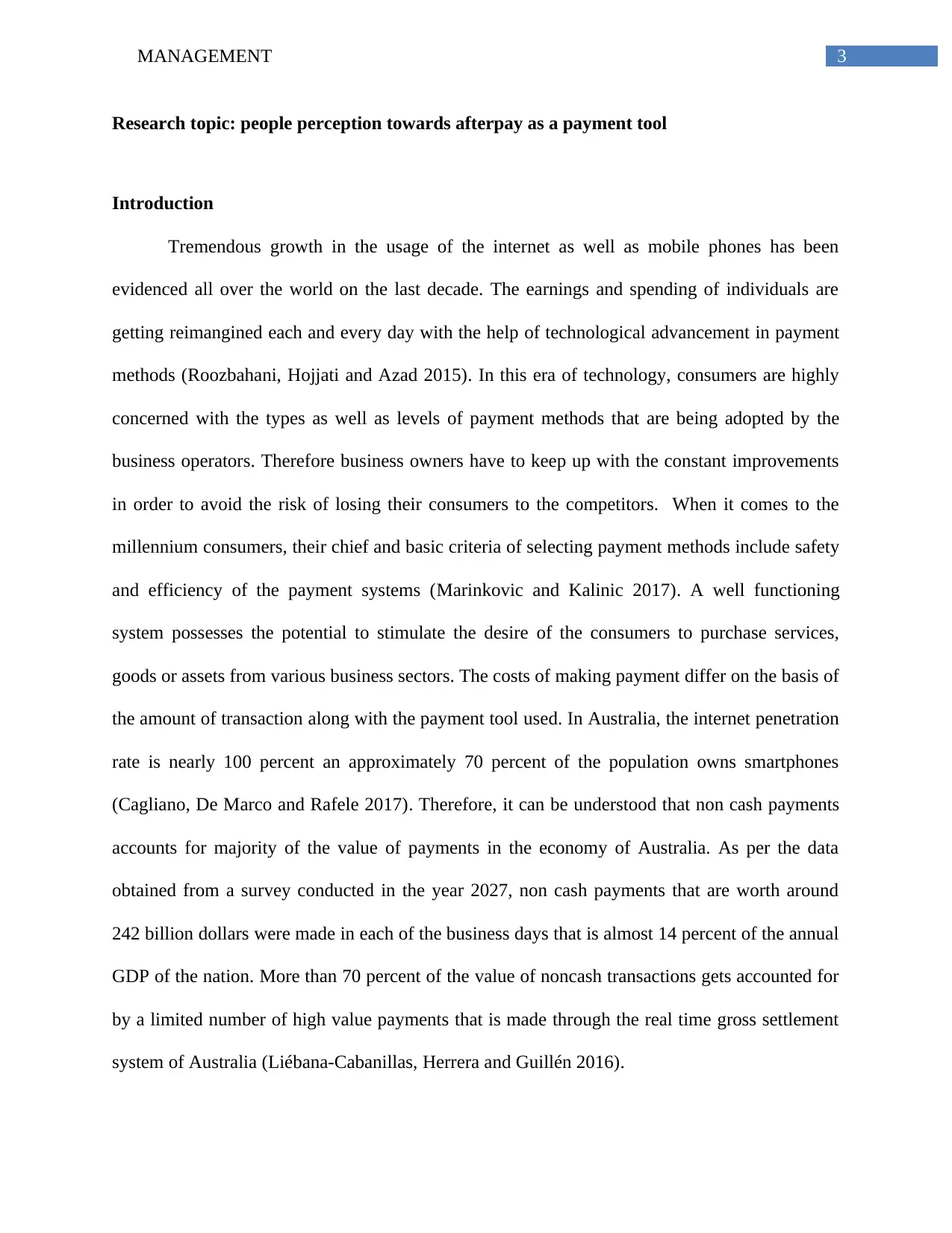
3MANAGEMENT
Research topic: people perception towards afterpay as a payment tool
Introduction
Tremendous growth in the usage of the internet as well as mobile phones has been
evidenced all over the world on the last decade. The earnings and spending of individuals are
getting reimangined each and every day with the help of technological advancement in payment
methods (Roozbahani, Hojjati and Azad 2015). In this era of technology, consumers are highly
concerned with the types as well as levels of payment methods that are being adopted by the
business operators. Therefore business owners have to keep up with the constant improvements
in order to avoid the risk of losing their consumers to the competitors. When it comes to the
millennium consumers, their chief and basic criteria of selecting payment methods include safety
and efficiency of the payment systems (Marinkovic and Kalinic 2017). A well functioning
system possesses the potential to stimulate the desire of the consumers to purchase services,
goods or assets from various business sectors. The costs of making payment differ on the basis of
the amount of transaction along with the payment tool used. In Australia, the internet penetration
rate is nearly 100 percent an approximately 70 percent of the population owns smartphones
(Cagliano, De Marco and Rafele 2017). Therefore, it can be understood that non cash payments
accounts for majority of the value of payments in the economy of Australia. As per the data
obtained from a survey conducted in the year 2027, non cash payments that are worth around
242 billion dollars were made in each of the business days that is almost 14 percent of the annual
GDP of the nation. More than 70 percent of the value of noncash transactions gets accounted for
by a limited number of high value payments that is made through the real time gross settlement
system of Australia (Liébana-Cabanillas, Herrera and Guillén 2016).
Research topic: people perception towards afterpay as a payment tool
Introduction
Tremendous growth in the usage of the internet as well as mobile phones has been
evidenced all over the world on the last decade. The earnings and spending of individuals are
getting reimangined each and every day with the help of technological advancement in payment
methods (Roozbahani, Hojjati and Azad 2015). In this era of technology, consumers are highly
concerned with the types as well as levels of payment methods that are being adopted by the
business operators. Therefore business owners have to keep up with the constant improvements
in order to avoid the risk of losing their consumers to the competitors. When it comes to the
millennium consumers, their chief and basic criteria of selecting payment methods include safety
and efficiency of the payment systems (Marinkovic and Kalinic 2017). A well functioning
system possesses the potential to stimulate the desire of the consumers to purchase services,
goods or assets from various business sectors. The costs of making payment differ on the basis of
the amount of transaction along with the payment tool used. In Australia, the internet penetration
rate is nearly 100 percent an approximately 70 percent of the population owns smartphones
(Cagliano, De Marco and Rafele 2017). Therefore, it can be understood that non cash payments
accounts for majority of the value of payments in the economy of Australia. As per the data
obtained from a survey conducted in the year 2027, non cash payments that are worth around
242 billion dollars were made in each of the business days that is almost 14 percent of the annual
GDP of the nation. More than 70 percent of the value of noncash transactions gets accounted for
by a limited number of high value payments that is made through the real time gross settlement
system of Australia (Liébana-Cabanillas, Herrera and Guillén 2016).
Secure Best Marks with AI Grader
Need help grading? Try our AI Grader for instant feedback on your assignments.
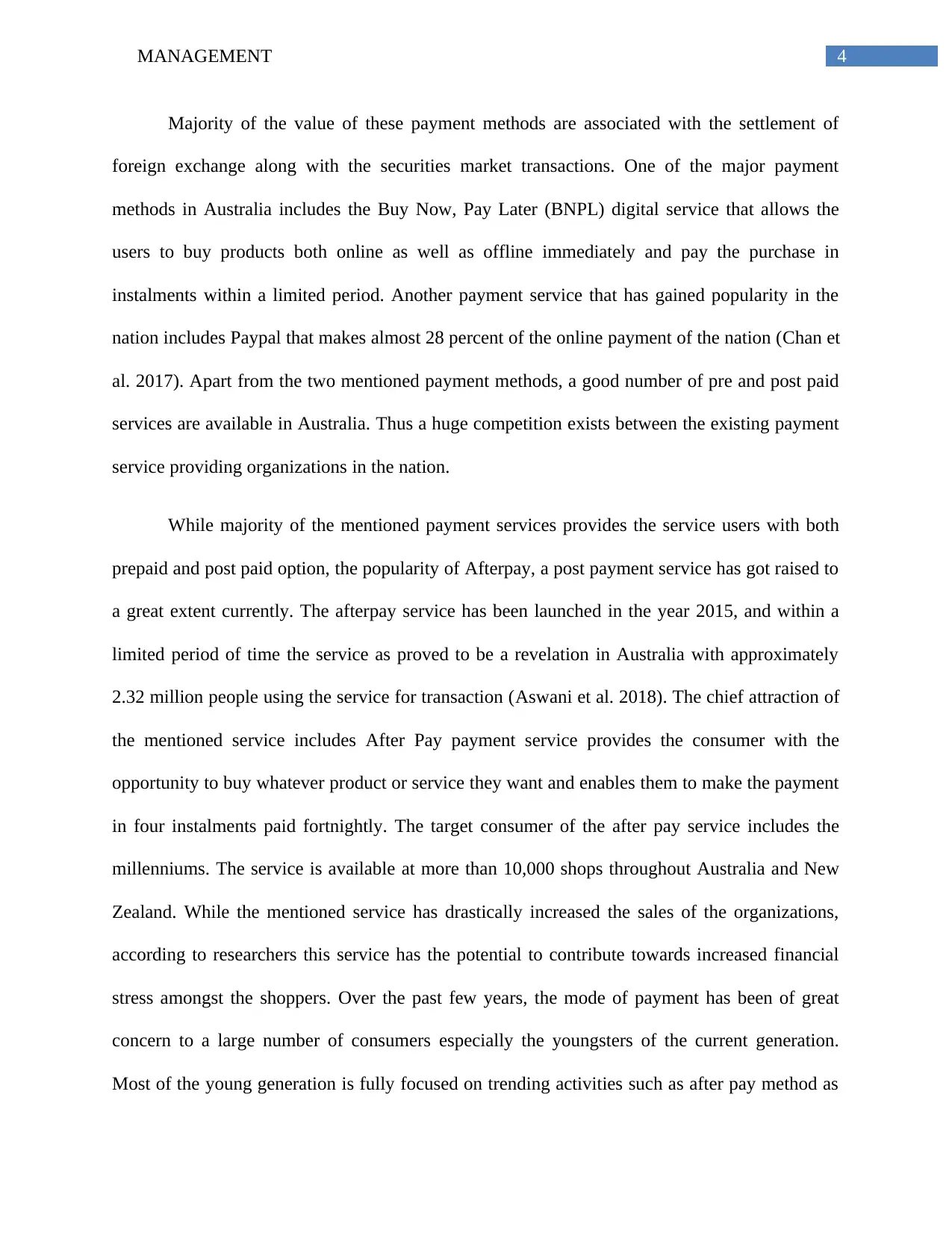
4MANAGEMENT
Majority of the value of these payment methods are associated with the settlement of
foreign exchange along with the securities market transactions. One of the major payment
methods in Australia includes the Buy Now, Pay Later (BNPL) digital service that allows the
users to buy products both online as well as offline immediately and pay the purchase in
instalments within a limited period. Another payment service that has gained popularity in the
nation includes Paypal that makes almost 28 percent of the online payment of the nation (Chan et
al. 2017). Apart from the two mentioned payment methods, a good number of pre and post paid
services are available in Australia. Thus a huge competition exists between the existing payment
service providing organizations in the nation.
While majority of the mentioned payment services provides the service users with both
prepaid and post paid option, the popularity of Afterpay, a post payment service has got raised to
a great extent currently. The afterpay service has been launched in the year 2015, and within a
limited period of time the service as proved to be a revelation in Australia with approximately
2.32 million people using the service for transaction (Aswani et al. 2018). The chief attraction of
the mentioned service includes After Pay payment service provides the consumer with the
opportunity to buy whatever product or service they want and enables them to make the payment
in four instalments paid fortnightly. The target consumer of the after pay service includes the
millenniums. The service is available at more than 10,000 shops throughout Australia and New
Zealand. While the mentioned service has drastically increased the sales of the organizations,
according to researchers this service has the potential to contribute towards increased financial
stress amongst the shoppers. Over the past few years, the mode of payment has been of great
concern to a large number of consumers especially the youngsters of the current generation.
Most of the young generation is fully focused on trending activities such as after pay method as
Majority of the value of these payment methods are associated with the settlement of
foreign exchange along with the securities market transactions. One of the major payment
methods in Australia includes the Buy Now, Pay Later (BNPL) digital service that allows the
users to buy products both online as well as offline immediately and pay the purchase in
instalments within a limited period. Another payment service that has gained popularity in the
nation includes Paypal that makes almost 28 percent of the online payment of the nation (Chan et
al. 2017). Apart from the two mentioned payment methods, a good number of pre and post paid
services are available in Australia. Thus a huge competition exists between the existing payment
service providing organizations in the nation.
While majority of the mentioned payment services provides the service users with both
prepaid and post paid option, the popularity of Afterpay, a post payment service has got raised to
a great extent currently. The afterpay service has been launched in the year 2015, and within a
limited period of time the service as proved to be a revelation in Australia with approximately
2.32 million people using the service for transaction (Aswani et al. 2018). The chief attraction of
the mentioned service includes After Pay payment service provides the consumer with the
opportunity to buy whatever product or service they want and enables them to make the payment
in four instalments paid fortnightly. The target consumer of the after pay service includes the
millenniums. The service is available at more than 10,000 shops throughout Australia and New
Zealand. While the mentioned service has drastically increased the sales of the organizations,
according to researchers this service has the potential to contribute towards increased financial
stress amongst the shoppers. Over the past few years, the mode of payment has been of great
concern to a large number of consumers especially the youngsters of the current generation.
Most of the young generation is fully focused on trending activities such as after pay method as
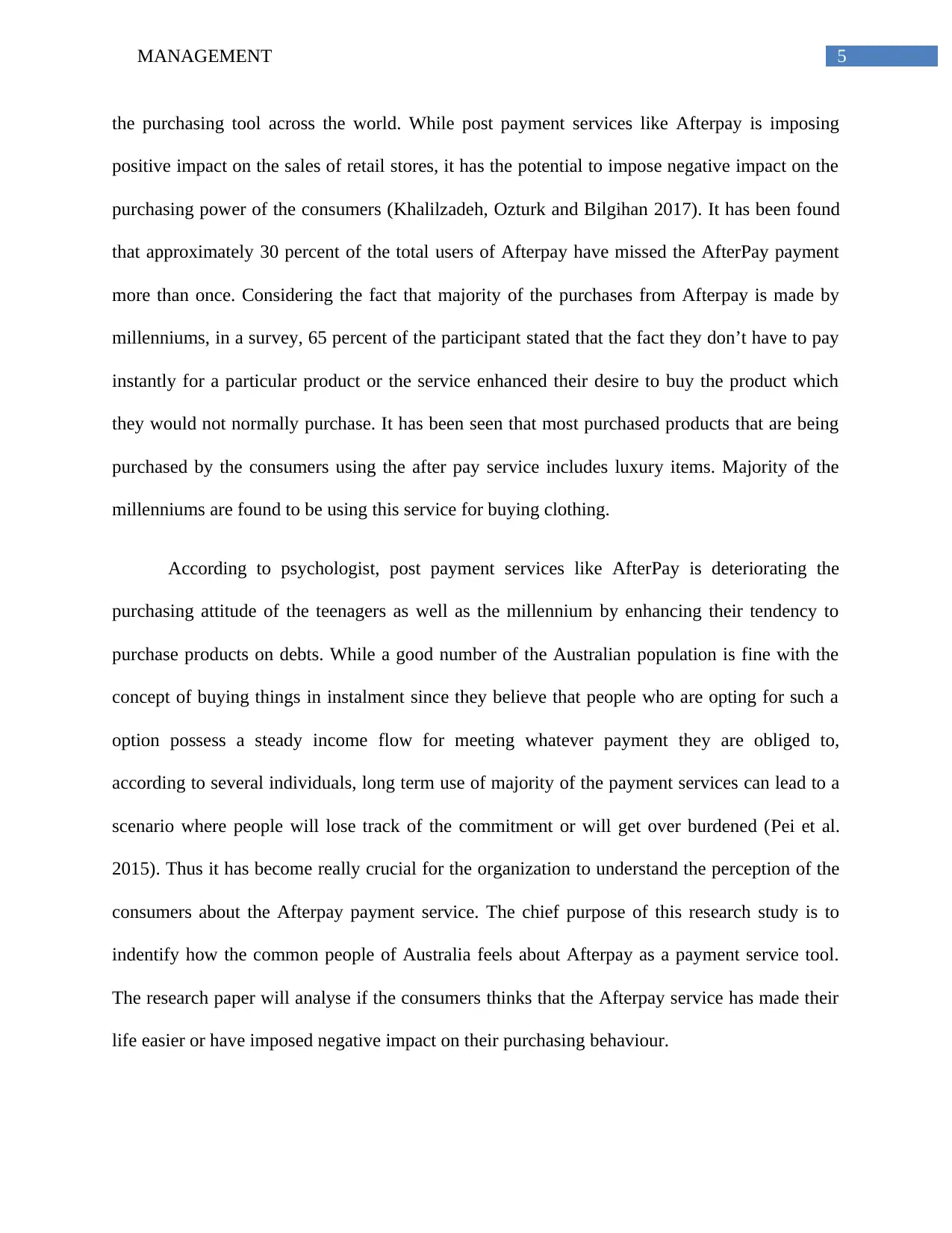
5MANAGEMENT
the purchasing tool across the world. While post payment services like Afterpay is imposing
positive impact on the sales of retail stores, it has the potential to impose negative impact on the
purchasing power of the consumers (Khalilzadeh, Ozturk and Bilgihan 2017). It has been found
that approximately 30 percent of the total users of Afterpay have missed the AfterPay payment
more than once. Considering the fact that majority of the purchases from Afterpay is made by
millenniums, in a survey, 65 percent of the participant stated that the fact they don’t have to pay
instantly for a particular product or the service enhanced their desire to buy the product which
they would not normally purchase. It has been seen that most purchased products that are being
purchased by the consumers using the after pay service includes luxury items. Majority of the
millenniums are found to be using this service for buying clothing.
According to psychologist, post payment services like AfterPay is deteriorating the
purchasing attitude of the teenagers as well as the millennium by enhancing their tendency to
purchase products on debts. While a good number of the Australian population is fine with the
concept of buying things in instalment since they believe that people who are opting for such a
option possess a steady income flow for meeting whatever payment they are obliged to,
according to several individuals, long term use of majority of the payment services can lead to a
scenario where people will lose track of the commitment or will get over burdened (Pei et al.
2015). Thus it has become really crucial for the organization to understand the perception of the
consumers about the Afterpay payment service. The chief purpose of this research study is to
indentify how the common people of Australia feels about Afterpay as a payment service tool.
The research paper will analyse if the consumers thinks that the Afterpay service has made their
life easier or have imposed negative impact on their purchasing behaviour.
the purchasing tool across the world. While post payment services like Afterpay is imposing
positive impact on the sales of retail stores, it has the potential to impose negative impact on the
purchasing power of the consumers (Khalilzadeh, Ozturk and Bilgihan 2017). It has been found
that approximately 30 percent of the total users of Afterpay have missed the AfterPay payment
more than once. Considering the fact that majority of the purchases from Afterpay is made by
millenniums, in a survey, 65 percent of the participant stated that the fact they don’t have to pay
instantly for a particular product or the service enhanced their desire to buy the product which
they would not normally purchase. It has been seen that most purchased products that are being
purchased by the consumers using the after pay service includes luxury items. Majority of the
millenniums are found to be using this service for buying clothing.
According to psychologist, post payment services like AfterPay is deteriorating the
purchasing attitude of the teenagers as well as the millennium by enhancing their tendency to
purchase products on debts. While a good number of the Australian population is fine with the
concept of buying things in instalment since they believe that people who are opting for such a
option possess a steady income flow for meeting whatever payment they are obliged to,
according to several individuals, long term use of majority of the payment services can lead to a
scenario where people will lose track of the commitment or will get over burdened (Pei et al.
2015). Thus it has become really crucial for the organization to understand the perception of the
consumers about the Afterpay payment service. The chief purpose of this research study is to
indentify how the common people of Australia feels about Afterpay as a payment service tool.
The research paper will analyse if the consumers thinks that the Afterpay service has made their
life easier or have imposed negative impact on their purchasing behaviour.
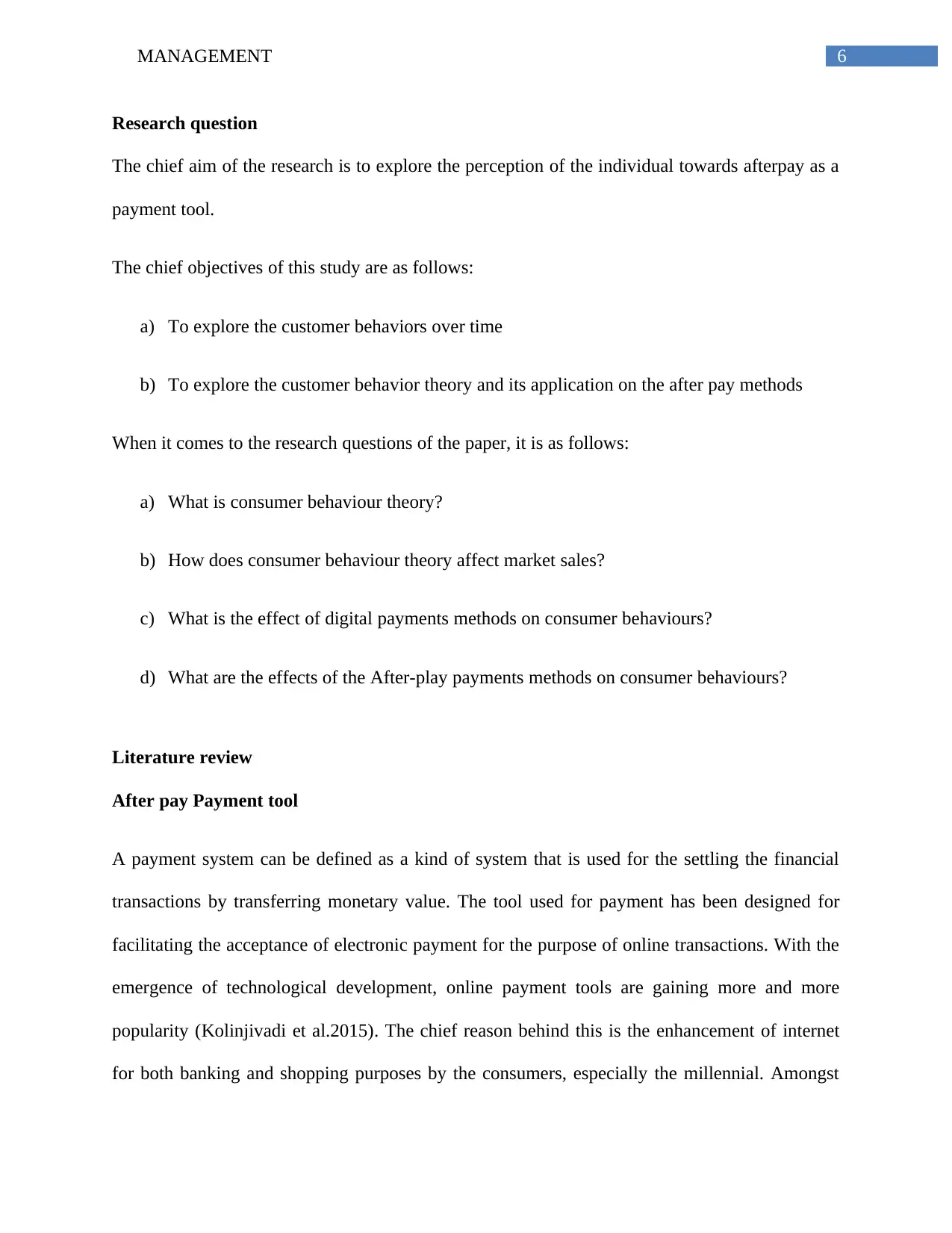
6MANAGEMENT
Research question
The chief aim of the research is to explore the perception of the individual towards afterpay as a
payment tool.
The chief objectives of this study are as follows:
a) To explore the customer behaviors over time
b) To explore the customer behavior theory and its application on the after pay methods
When it comes to the research questions of the paper, it is as follows:
a) What is consumer behaviour theory?
b) How does consumer behaviour theory affect market sales?
c) What is the effect of digital payments methods on consumer behaviours?
d) What are the effects of the After-play payments methods on consumer behaviours?
Literature review
After pay Payment tool
A payment system can be defined as a kind of system that is used for the settling the financial
transactions by transferring monetary value. The tool used for payment has been designed for
facilitating the acceptance of electronic payment for the purpose of online transactions. With the
emergence of technological development, online payment tools are gaining more and more
popularity (Kolinjivadi et al.2015). The chief reason behind this is the enhancement of internet
for both banking and shopping purposes by the consumers, especially the millennial. Amongst
Research question
The chief aim of the research is to explore the perception of the individual towards afterpay as a
payment tool.
The chief objectives of this study are as follows:
a) To explore the customer behaviors over time
b) To explore the customer behavior theory and its application on the after pay methods
When it comes to the research questions of the paper, it is as follows:
a) What is consumer behaviour theory?
b) How does consumer behaviour theory affect market sales?
c) What is the effect of digital payments methods on consumer behaviours?
d) What are the effects of the After-play payments methods on consumer behaviours?
Literature review
After pay Payment tool
A payment system can be defined as a kind of system that is used for the settling the financial
transactions by transferring monetary value. The tool used for payment has been designed for
facilitating the acceptance of electronic payment for the purpose of online transactions. With the
emergence of technological development, online payment tools are gaining more and more
popularity (Kolinjivadi et al.2015). The chief reason behind this is the enhancement of internet
for both banking and shopping purposes by the consumers, especially the millennial. Amongst
Paraphrase This Document
Need a fresh take? Get an instant paraphrase of this document with our AI Paraphraser
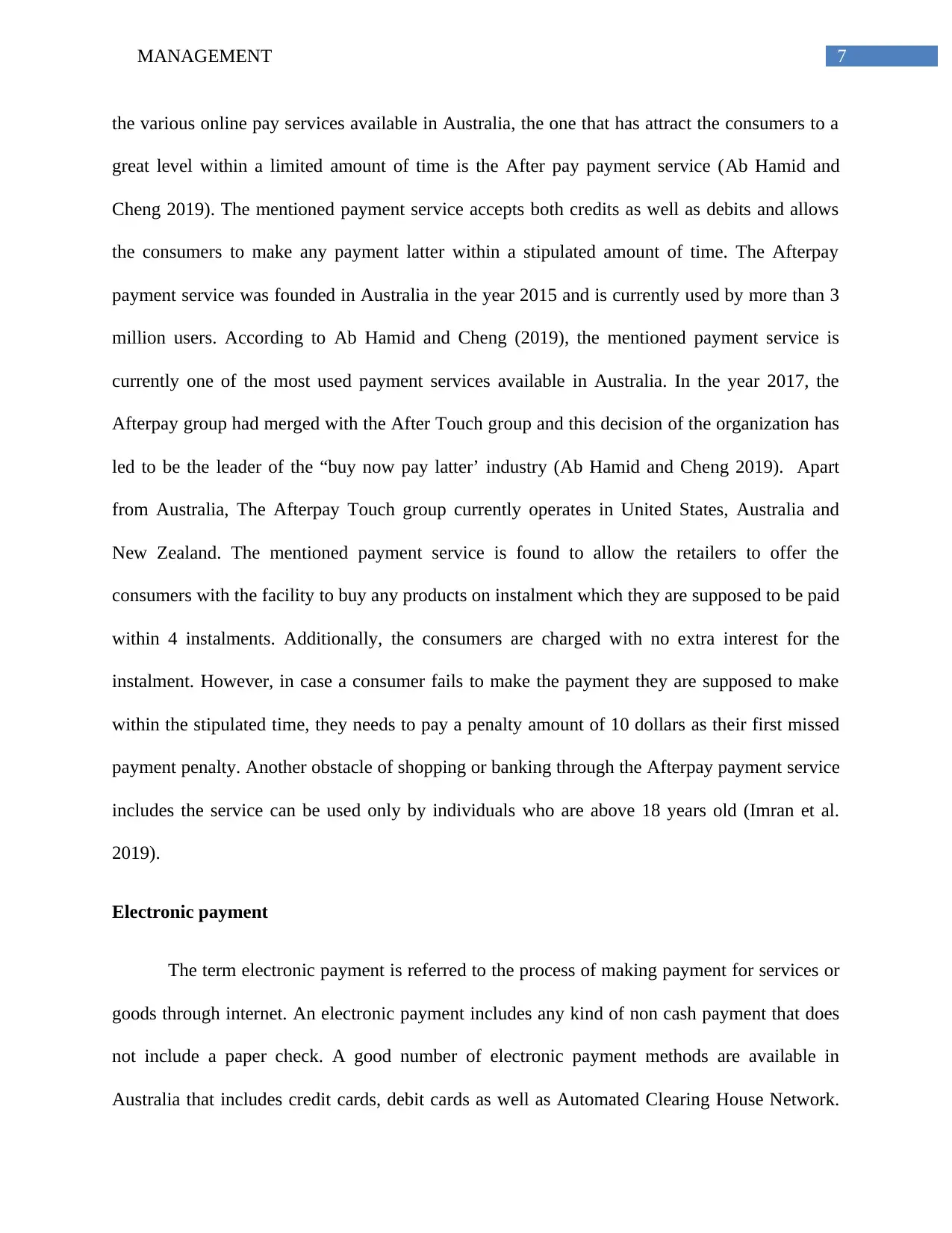
7MANAGEMENT
the various online pay services available in Australia, the one that has attract the consumers to a
great level within a limited amount of time is the After pay payment service (Ab Hamid and
Cheng 2019). The mentioned payment service accepts both credits as well as debits and allows
the consumers to make any payment latter within a stipulated amount of time. The Afterpay
payment service was founded in Australia in the year 2015 and is currently used by more than 3
million users. According to Ab Hamid and Cheng (2019), the mentioned payment service is
currently one of the most used payment services available in Australia. In the year 2017, the
Afterpay group had merged with the After Touch group and this decision of the organization has
led to be the leader of the “buy now pay latter’ industry (Ab Hamid and Cheng 2019). Apart
from Australia, The Afterpay Touch group currently operates in United States, Australia and
New Zealand. The mentioned payment service is found to allow the retailers to offer the
consumers with the facility to buy any products on instalment which they are supposed to be paid
within 4 instalments. Additionally, the consumers are charged with no extra interest for the
instalment. However, in case a consumer fails to make the payment they are supposed to make
within the stipulated time, they needs to pay a penalty amount of 10 dollars as their first missed
payment penalty. Another obstacle of shopping or banking through the Afterpay payment service
includes the service can be used only by individuals who are above 18 years old (Imran et al.
2019).
Electronic payment
The term electronic payment is referred to the process of making payment for services or
goods through internet. An electronic payment includes any kind of non cash payment that does
not include a paper check. A good number of electronic payment methods are available in
Australia that includes credit cards, debit cards as well as Automated Clearing House Network.
the various online pay services available in Australia, the one that has attract the consumers to a
great level within a limited amount of time is the After pay payment service (Ab Hamid and
Cheng 2019). The mentioned payment service accepts both credits as well as debits and allows
the consumers to make any payment latter within a stipulated amount of time. The Afterpay
payment service was founded in Australia in the year 2015 and is currently used by more than 3
million users. According to Ab Hamid and Cheng (2019), the mentioned payment service is
currently one of the most used payment services available in Australia. In the year 2017, the
Afterpay group had merged with the After Touch group and this decision of the organization has
led to be the leader of the “buy now pay latter’ industry (Ab Hamid and Cheng 2019). Apart
from Australia, The Afterpay Touch group currently operates in United States, Australia and
New Zealand. The mentioned payment service is found to allow the retailers to offer the
consumers with the facility to buy any products on instalment which they are supposed to be paid
within 4 instalments. Additionally, the consumers are charged with no extra interest for the
instalment. However, in case a consumer fails to make the payment they are supposed to make
within the stipulated time, they needs to pay a penalty amount of 10 dollars as their first missed
payment penalty. Another obstacle of shopping or banking through the Afterpay payment service
includes the service can be used only by individuals who are above 18 years old (Imran et al.
2019).
Electronic payment
The term electronic payment is referred to the process of making payment for services or
goods through internet. An electronic payment includes any kind of non cash payment that does
not include a paper check. A good number of electronic payment methods are available in
Australia that includes credit cards, debit cards as well as Automated Clearing House Network.
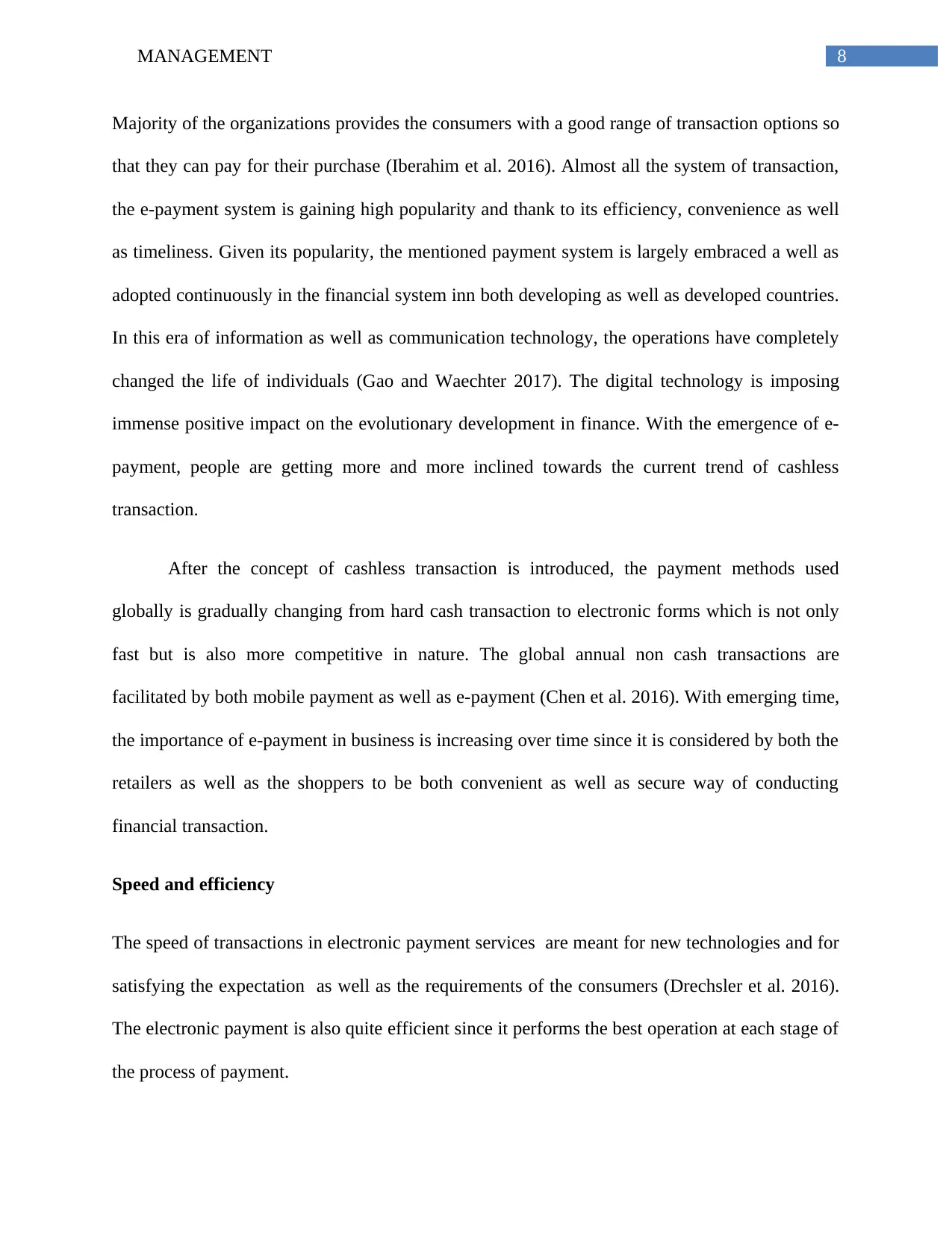
8MANAGEMENT
Majority of the organizations provides the consumers with a good range of transaction options so
that they can pay for their purchase (Iberahim et al. 2016). Almost all the system of transaction,
the e-payment system is gaining high popularity and thank to its efficiency, convenience as well
as timeliness. Given its popularity, the mentioned payment system is largely embraced a well as
adopted continuously in the financial system inn both developing as well as developed countries.
In this era of information as well as communication technology, the operations have completely
changed the life of individuals (Gao and Waechter 2017). The digital technology is imposing
immense positive impact on the evolutionary development in finance. With the emergence of e-
payment, people are getting more and more inclined towards the current trend of cashless
transaction.
After the concept of cashless transaction is introduced, the payment methods used
globally is gradually changing from hard cash transaction to electronic forms which is not only
fast but is also more competitive in nature. The global annual non cash transactions are
facilitated by both mobile payment as well as e-payment (Chen et al. 2016). With emerging time,
the importance of e-payment in business is increasing over time since it is considered by both the
retailers as well as the shoppers to be both convenient as well as secure way of conducting
financial transaction.
Speed and efficiency
The speed of transactions in electronic payment services are meant for new technologies and for
satisfying the expectation as well as the requirements of the consumers (Drechsler et al. 2016).
The electronic payment is also quite efficient since it performs the best operation at each stage of
the process of payment.
Majority of the organizations provides the consumers with a good range of transaction options so
that they can pay for their purchase (Iberahim et al. 2016). Almost all the system of transaction,
the e-payment system is gaining high popularity and thank to its efficiency, convenience as well
as timeliness. Given its popularity, the mentioned payment system is largely embraced a well as
adopted continuously in the financial system inn both developing as well as developed countries.
In this era of information as well as communication technology, the operations have completely
changed the life of individuals (Gao and Waechter 2017). The digital technology is imposing
immense positive impact on the evolutionary development in finance. With the emergence of e-
payment, people are getting more and more inclined towards the current trend of cashless
transaction.
After the concept of cashless transaction is introduced, the payment methods used
globally is gradually changing from hard cash transaction to electronic forms which is not only
fast but is also more competitive in nature. The global annual non cash transactions are
facilitated by both mobile payment as well as e-payment (Chen et al. 2016). With emerging time,
the importance of e-payment in business is increasing over time since it is considered by both the
retailers as well as the shoppers to be both convenient as well as secure way of conducting
financial transaction.
Speed and efficiency
The speed of transactions in electronic payment services are meant for new technologies and for
satisfying the expectation as well as the requirements of the consumers (Drechsler et al. 2016).
The electronic payment is also quite efficient since it performs the best operation at each stage of
the process of payment.
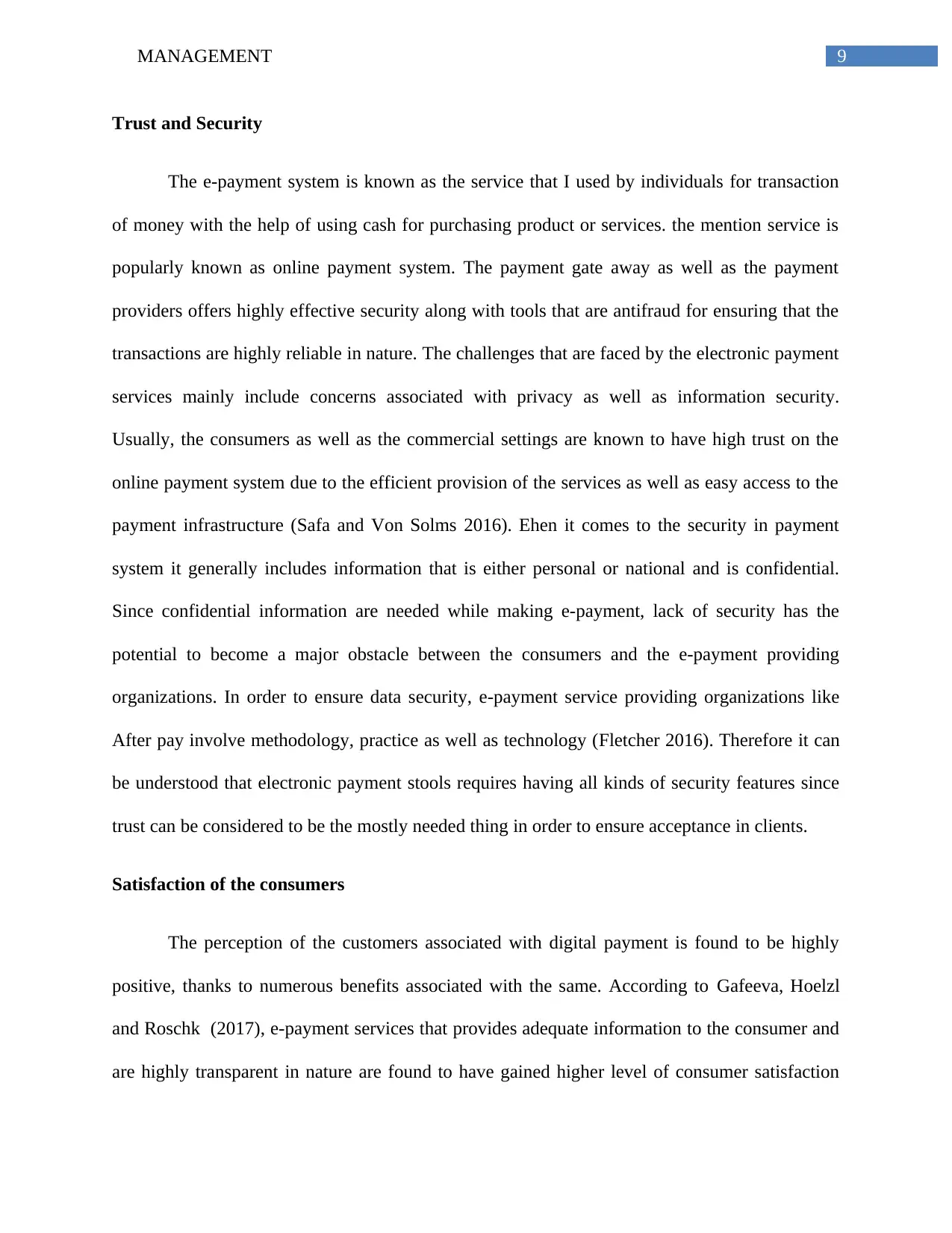
9MANAGEMENT
Trust and Security
The e-payment system is known as the service that I used by individuals for transaction
of money with the help of using cash for purchasing product or services. the mention service is
popularly known as online payment system. The payment gate away as well as the payment
providers offers highly effective security along with tools that are antifraud for ensuring that the
transactions are highly reliable in nature. The challenges that are faced by the electronic payment
services mainly include concerns associated with privacy as well as information security.
Usually, the consumers as well as the commercial settings are known to have high trust on the
online payment system due to the efficient provision of the services as well as easy access to the
payment infrastructure (Safa and Von Solms 2016). Ehen it comes to the security in payment
system it generally includes information that is either personal or national and is confidential.
Since confidential information are needed while making e-payment, lack of security has the
potential to become a major obstacle between the consumers and the e-payment providing
organizations. In order to ensure data security, e-payment service providing organizations like
After pay involve methodology, practice as well as technology (Fletcher 2016). Therefore it can
be understood that electronic payment stools requires having all kinds of security features since
trust can be considered to be the mostly needed thing in order to ensure acceptance in clients.
Satisfaction of the consumers
The perception of the customers associated with digital payment is found to be highly
positive, thanks to numerous benefits associated with the same. According to Gafeeva, Hoelzl
and Roschk (2017), e-payment services that provides adequate information to the consumer and
are highly transparent in nature are found to have gained higher level of consumer satisfaction
Trust and Security
The e-payment system is known as the service that I used by individuals for transaction
of money with the help of using cash for purchasing product or services. the mention service is
popularly known as online payment system. The payment gate away as well as the payment
providers offers highly effective security along with tools that are antifraud for ensuring that the
transactions are highly reliable in nature. The challenges that are faced by the electronic payment
services mainly include concerns associated with privacy as well as information security.
Usually, the consumers as well as the commercial settings are known to have high trust on the
online payment system due to the efficient provision of the services as well as easy access to the
payment infrastructure (Safa and Von Solms 2016). Ehen it comes to the security in payment
system it generally includes information that is either personal or national and is confidential.
Since confidential information are needed while making e-payment, lack of security has the
potential to become a major obstacle between the consumers and the e-payment providing
organizations. In order to ensure data security, e-payment service providing organizations like
After pay involve methodology, practice as well as technology (Fletcher 2016). Therefore it can
be understood that electronic payment stools requires having all kinds of security features since
trust can be considered to be the mostly needed thing in order to ensure acceptance in clients.
Satisfaction of the consumers
The perception of the customers associated with digital payment is found to be highly
positive, thanks to numerous benefits associated with the same. According to Gafeeva, Hoelzl
and Roschk (2017), e-payment services that provides adequate information to the consumer and
are highly transparent in nature are found to have gained higher level of consumer satisfaction
Secure Best Marks with AI Grader
Need help grading? Try our AI Grader for instant feedback on your assignments.
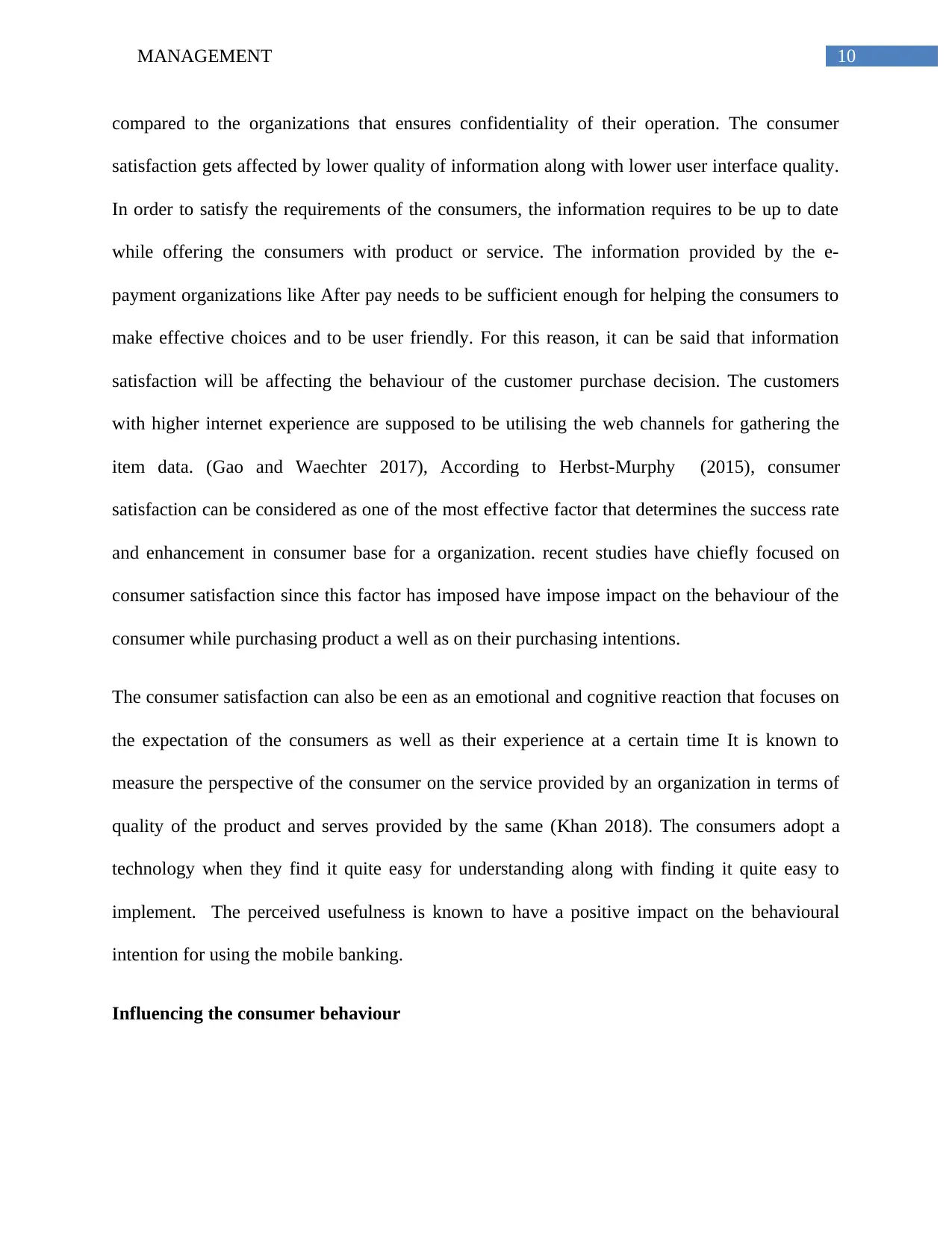
10MANAGEMENT
compared to the organizations that ensures confidentiality of their operation. The consumer
satisfaction gets affected by lower quality of information along with lower user interface quality.
In order to satisfy the requirements of the consumers, the information requires to be up to date
while offering the consumers with product or service. The information provided by the e-
payment organizations like After pay needs to be sufficient enough for helping the consumers to
make effective choices and to be user friendly. For this reason, it can be said that information
satisfaction will be affecting the behaviour of the customer purchase decision. The customers
with higher internet experience are supposed to be utilising the web channels for gathering the
item data. (Gao and Waechter 2017), According to Herbst-Murphy (2015), consumer
satisfaction can be considered as one of the most effective factor that determines the success rate
and enhancement in consumer base for a organization. recent studies have chiefly focused on
consumer satisfaction since this factor has imposed have impose impact on the behaviour of the
consumer while purchasing product a well as on their purchasing intentions.
The consumer satisfaction can also be een as an emotional and cognitive reaction that focuses on
the expectation of the consumers as well as their experience at a certain time It is known to
measure the perspective of the consumer on the service provided by an organization in terms of
quality of the product and serves provided by the same (Khan 2018). The consumers adopt a
technology when they find it quite easy for understanding along with finding it quite easy to
implement. The perceived usefulness is known to have a positive impact on the behavioural
intention for using the mobile banking.
Influencing the consumer behaviour
compared to the organizations that ensures confidentiality of their operation. The consumer
satisfaction gets affected by lower quality of information along with lower user interface quality.
In order to satisfy the requirements of the consumers, the information requires to be up to date
while offering the consumers with product or service. The information provided by the e-
payment organizations like After pay needs to be sufficient enough for helping the consumers to
make effective choices and to be user friendly. For this reason, it can be said that information
satisfaction will be affecting the behaviour of the customer purchase decision. The customers
with higher internet experience are supposed to be utilising the web channels for gathering the
item data. (Gao and Waechter 2017), According to Herbst-Murphy (2015), consumer
satisfaction can be considered as one of the most effective factor that determines the success rate
and enhancement in consumer base for a organization. recent studies have chiefly focused on
consumer satisfaction since this factor has imposed have impose impact on the behaviour of the
consumer while purchasing product a well as on their purchasing intentions.
The consumer satisfaction can also be een as an emotional and cognitive reaction that focuses on
the expectation of the consumers as well as their experience at a certain time It is known to
measure the perspective of the consumer on the service provided by an organization in terms of
quality of the product and serves provided by the same (Khan 2018). The consumers adopt a
technology when they find it quite easy for understanding along with finding it quite easy to
implement. The perceived usefulness is known to have a positive impact on the behavioural
intention for using the mobile banking.
Influencing the consumer behaviour
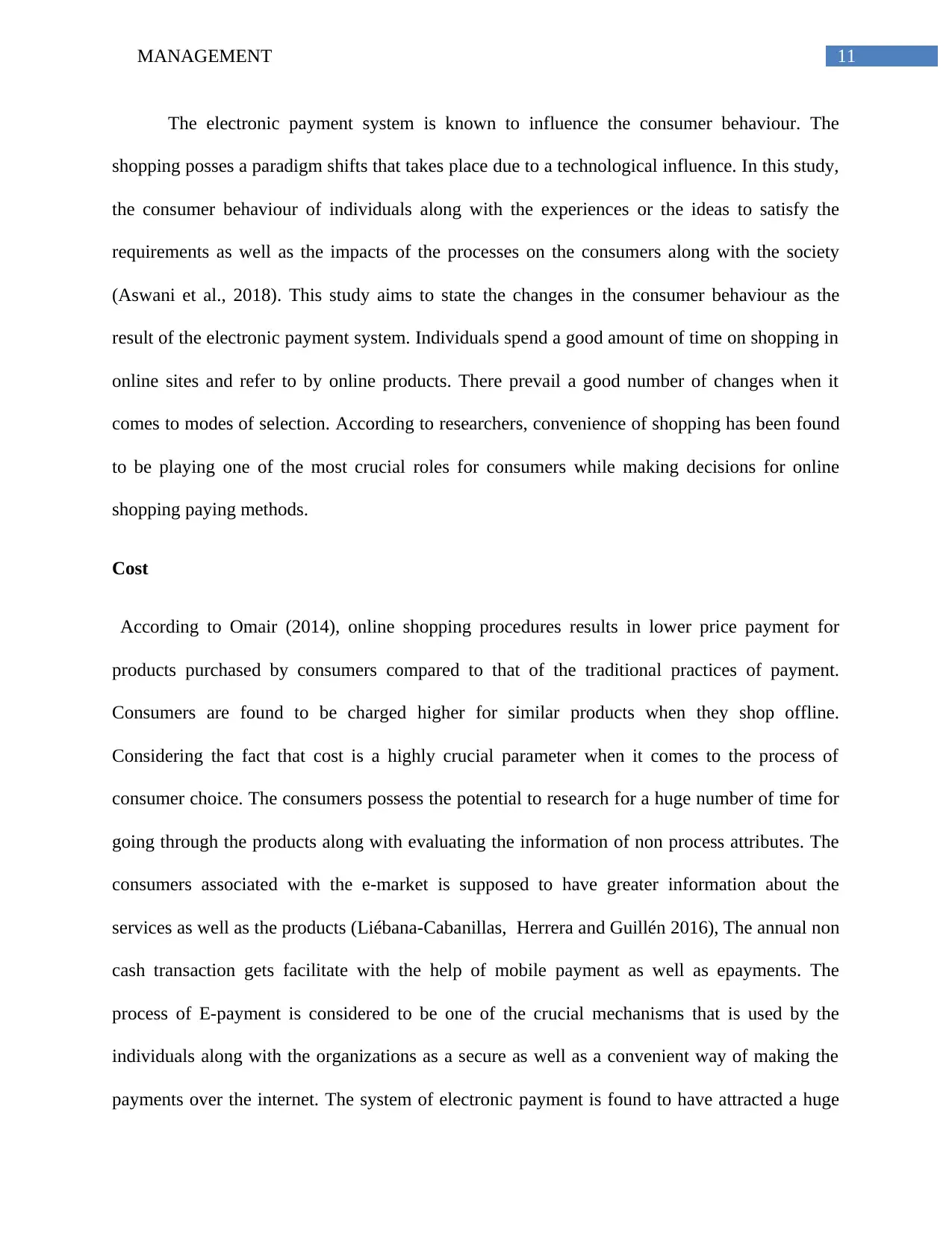
11MANAGEMENT
The electronic payment system is known to influence the consumer behaviour. The
shopping posses a paradigm shifts that takes place due to a technological influence. In this study,
the consumer behaviour of individuals along with the experiences or the ideas to satisfy the
requirements as well as the impacts of the processes on the consumers along with the society
(Aswani et al., 2018). This study aims to state the changes in the consumer behaviour as the
result of the electronic payment system. Individuals spend a good amount of time on shopping in
online sites and refer to by online products. There prevail a good number of changes when it
comes to modes of selection. According to researchers, convenience of shopping has been found
to be playing one of the most crucial roles for consumers while making decisions for online
shopping paying methods.
Cost
According to Omair (2014), online shopping procedures results in lower price payment for
products purchased by consumers compared to that of the traditional practices of payment.
Consumers are found to be charged higher for similar products when they shop offline.
Considering the fact that cost is a highly crucial parameter when it comes to the process of
consumer choice. The consumers possess the potential to research for a huge number of time for
going through the products along with evaluating the information of non process attributes. The
consumers associated with the e-market is supposed to have greater information about the
services as well as the products (Liébana-Cabanillas, Herrera and Guillén 2016), The annual non
cash transaction gets facilitate with the help of mobile payment as well as epayments. The
process of E-payment is considered to be one of the crucial mechanisms that is used by the
individuals along with the organizations as a secure as well as a convenient way of making the
payments over the internet. The system of electronic payment is found to have attracted a huge
The electronic payment system is known to influence the consumer behaviour. The
shopping posses a paradigm shifts that takes place due to a technological influence. In this study,
the consumer behaviour of individuals along with the experiences or the ideas to satisfy the
requirements as well as the impacts of the processes on the consumers along with the society
(Aswani et al., 2018). This study aims to state the changes in the consumer behaviour as the
result of the electronic payment system. Individuals spend a good amount of time on shopping in
online sites and refer to by online products. There prevail a good number of changes when it
comes to modes of selection. According to researchers, convenience of shopping has been found
to be playing one of the most crucial roles for consumers while making decisions for online
shopping paying methods.
Cost
According to Omair (2014), online shopping procedures results in lower price payment for
products purchased by consumers compared to that of the traditional practices of payment.
Consumers are found to be charged higher for similar products when they shop offline.
Considering the fact that cost is a highly crucial parameter when it comes to the process of
consumer choice. The consumers possess the potential to research for a huge number of time for
going through the products along with evaluating the information of non process attributes. The
consumers associated with the e-market is supposed to have greater information about the
services as well as the products (Liébana-Cabanillas, Herrera and Guillén 2016), The annual non
cash transaction gets facilitate with the help of mobile payment as well as epayments. The
process of E-payment is considered to be one of the crucial mechanisms that is used by the
individuals along with the organizations as a secure as well as a convenient way of making the
payments over the internet. The system of electronic payment is found to have attracted a huge
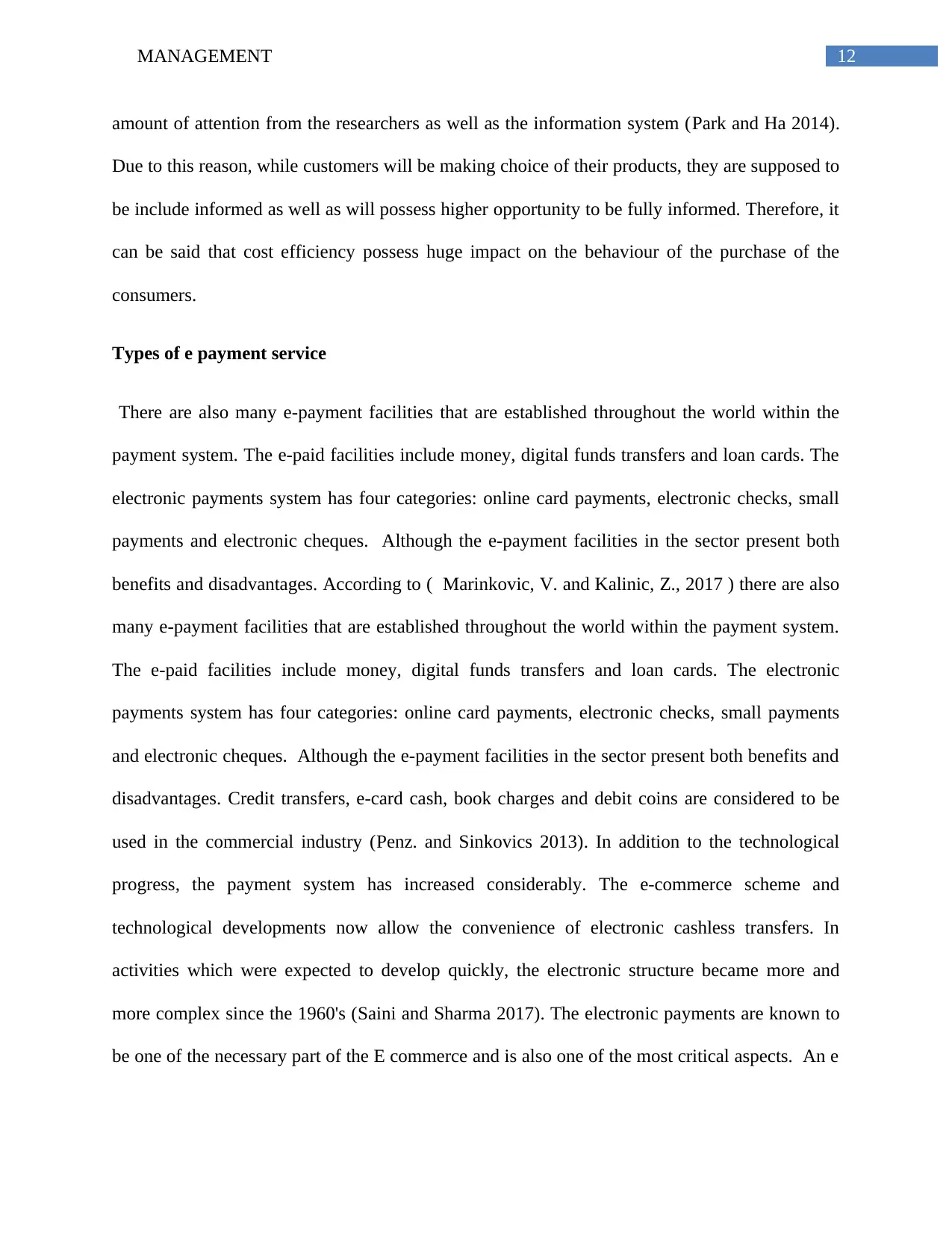
12MANAGEMENT
amount of attention from the researchers as well as the information system (Park and Ha 2014).
Due to this reason, while customers will be making choice of their products, they are supposed to
be include informed as well as will possess higher opportunity to be fully informed. Therefore, it
can be said that cost efficiency possess huge impact on the behaviour of the purchase of the
consumers.
Types of e payment service
There are also many e-payment facilities that are established throughout the world within the
payment system. The e-paid facilities include money, digital funds transfers and loan cards. The
electronic payments system has four categories: online card payments, electronic checks, small
payments and electronic cheques. Although the e-payment facilities in the sector present both
benefits and disadvantages. According to ( Marinkovic, V. and Kalinic, Z., 2017 ) there are also
many e-payment facilities that are established throughout the world within the payment system.
The e-paid facilities include money, digital funds transfers and loan cards. The electronic
payments system has four categories: online card payments, electronic checks, small payments
and electronic cheques. Although the e-payment facilities in the sector present both benefits and
disadvantages. Credit transfers, e-card cash, book charges and debit coins are considered to be
used in the commercial industry (Penz. and Sinkovics 2013). In addition to the technological
progress, the payment system has increased considerably. The e-commerce scheme and
technological developments now allow the convenience of electronic cashless transfers. In
activities which were expected to develop quickly, the electronic structure became more and
more complex since the 1960's (Saini and Sharma 2017). The electronic payments are known to
be one of the necessary part of the E commerce and is also one of the most critical aspects. An e
amount of attention from the researchers as well as the information system (Park and Ha 2014).
Due to this reason, while customers will be making choice of their products, they are supposed to
be include informed as well as will possess higher opportunity to be fully informed. Therefore, it
can be said that cost efficiency possess huge impact on the behaviour of the purchase of the
consumers.
Types of e payment service
There are also many e-payment facilities that are established throughout the world within the
payment system. The e-paid facilities include money, digital funds transfers and loan cards. The
electronic payments system has four categories: online card payments, electronic checks, small
payments and electronic cheques. Although the e-payment facilities in the sector present both
benefits and disadvantages. According to ( Marinkovic, V. and Kalinic, Z., 2017 ) there are also
many e-payment facilities that are established throughout the world within the payment system.
The e-paid facilities include money, digital funds transfers and loan cards. The electronic
payments system has four categories: online card payments, electronic checks, small payments
and electronic cheques. Although the e-payment facilities in the sector present both benefits and
disadvantages. Credit transfers, e-card cash, book charges and debit coins are considered to be
used in the commercial industry (Penz. and Sinkovics 2013). In addition to the technological
progress, the payment system has increased considerably. The e-commerce scheme and
technological developments now allow the convenience of electronic cashless transfers. In
activities which were expected to develop quickly, the electronic structure became more and
more complex since the 1960's (Saini and Sharma 2017). The electronic payments are known to
be one of the necessary part of the E commerce and is also one of the most critical aspects. An e
Paraphrase This Document
Need a fresh take? Get an instant paraphrase of this document with our AI Paraphraser
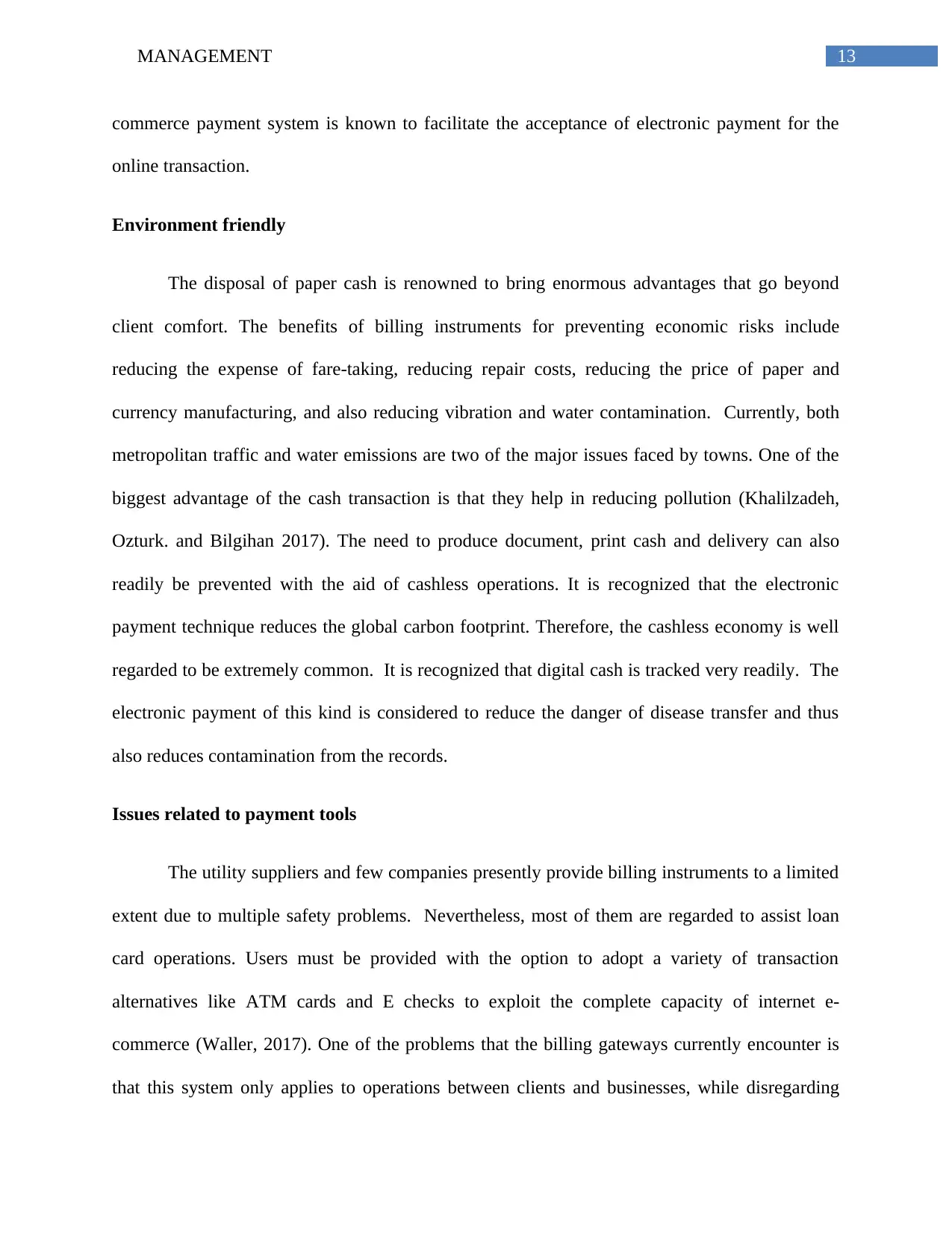
13MANAGEMENT
commerce payment system is known to facilitate the acceptance of electronic payment for the
online transaction.
Environment friendly
The disposal of paper cash is renowned to bring enormous advantages that go beyond
client comfort. The benefits of billing instruments for preventing economic risks include
reducing the expense of fare-taking, reducing repair costs, reducing the price of paper and
currency manufacturing, and also reducing vibration and water contamination. Currently, both
metropolitan traffic and water emissions are two of the major issues faced by towns. One of the
biggest advantage of the cash transaction is that they help in reducing pollution (Khalilzadeh,
Ozturk. and Bilgihan 2017). The need to produce document, print cash and delivery can also
readily be prevented with the aid of cashless operations. It is recognized that the electronic
payment technique reduces the global carbon footprint. Therefore, the cashless economy is well
regarded to be extremely common. It is recognized that digital cash is tracked very readily. The
electronic payment of this kind is considered to reduce the danger of disease transfer and thus
also reduces contamination from the records.
Issues related to payment tools
The utility suppliers and few companies presently provide billing instruments to a limited
extent due to multiple safety problems. Nevertheless, most of them are regarded to assist loan
card operations. Users must be provided with the option to adopt a variety of transaction
alternatives like ATM cards and E checks to exploit the complete capacity of internet e-
commerce (Waller, 2017). One of the problems that the billing gateways currently encounter is
that this system only applies to operations between clients and businesses, while disregarding
commerce payment system is known to facilitate the acceptance of electronic payment for the
online transaction.
Environment friendly
The disposal of paper cash is renowned to bring enormous advantages that go beyond
client comfort. The benefits of billing instruments for preventing economic risks include
reducing the expense of fare-taking, reducing repair costs, reducing the price of paper and
currency manufacturing, and also reducing vibration and water contamination. Currently, both
metropolitan traffic and water emissions are two of the major issues faced by towns. One of the
biggest advantage of the cash transaction is that they help in reducing pollution (Khalilzadeh,
Ozturk. and Bilgihan 2017). The need to produce document, print cash and delivery can also
readily be prevented with the aid of cashless operations. It is recognized that the electronic
payment technique reduces the global carbon footprint. Therefore, the cashless economy is well
regarded to be extremely common. It is recognized that digital cash is tracked very readily. The
electronic payment of this kind is considered to reduce the danger of disease transfer and thus
also reduces contamination from the records.
Issues related to payment tools
The utility suppliers and few companies presently provide billing instruments to a limited
extent due to multiple safety problems. Nevertheless, most of them are regarded to assist loan
card operations. Users must be provided with the option to adopt a variety of transaction
alternatives like ATM cards and E checks to exploit the complete capacity of internet e-
commerce (Waller, 2017). One of the problems that the billing gateways currently encounter is
that this system only applies to operations between clients and businesses, while disregarding
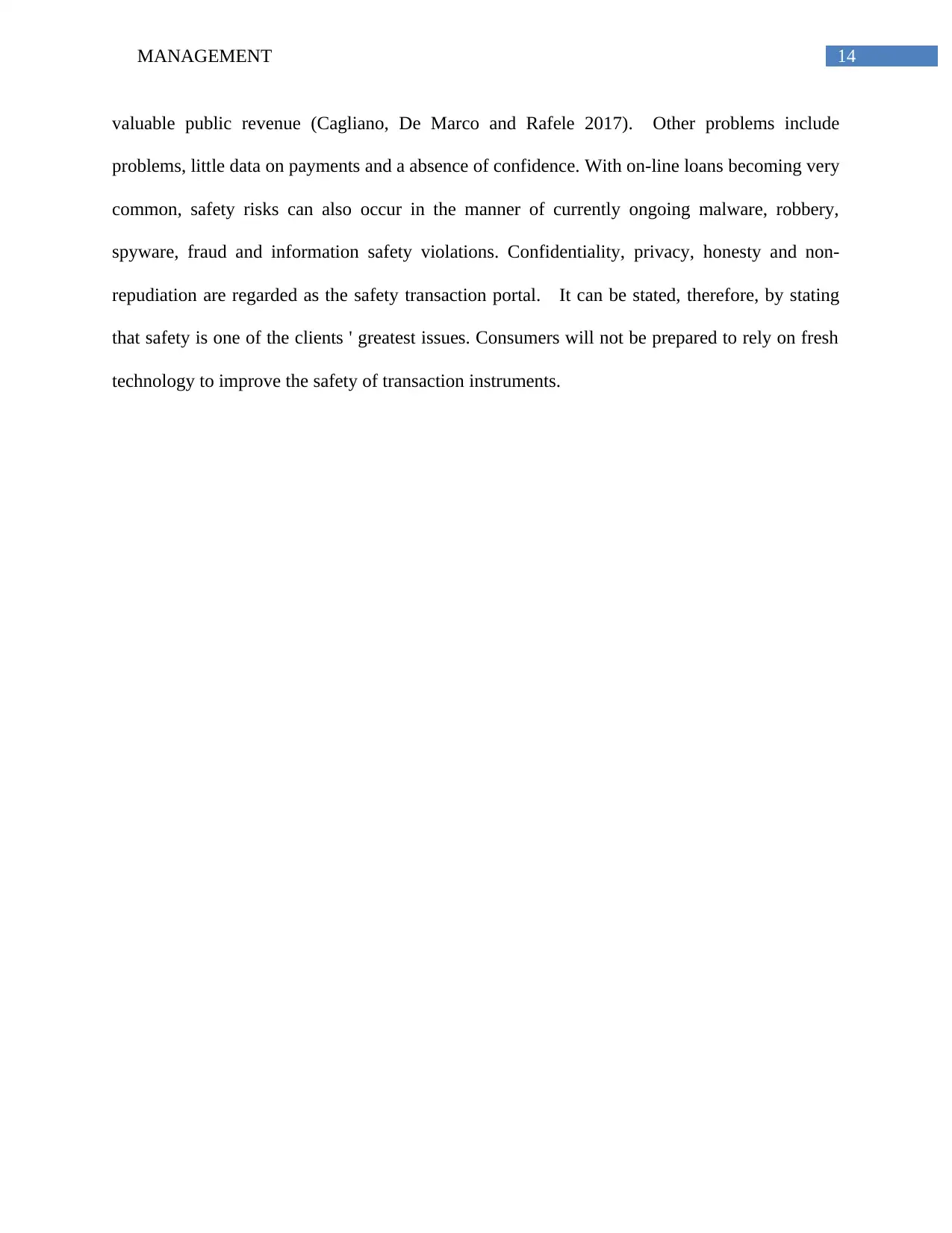
14MANAGEMENT
valuable public revenue (Cagliano, De Marco and Rafele 2017). Other problems include
problems, little data on payments and a absence of confidence. With on-line loans becoming very
common, safety risks can also occur in the manner of currently ongoing malware, robbery,
spyware, fraud and information safety violations. Confidentiality, privacy, honesty and non-
repudiation are regarded as the safety transaction portal. It can be stated, therefore, by stating
that safety is one of the clients ' greatest issues. Consumers will not be prepared to rely on fresh
technology to improve the safety of transaction instruments.
valuable public revenue (Cagliano, De Marco and Rafele 2017). Other problems include
problems, little data on payments and a absence of confidence. With on-line loans becoming very
common, safety risks can also occur in the manner of currently ongoing malware, robbery,
spyware, fraud and information safety violations. Confidentiality, privacy, honesty and non-
repudiation are regarded as the safety transaction portal. It can be stated, therefore, by stating
that safety is one of the clients ' greatest issues. Consumers will not be prepared to rely on fresh
technology to improve the safety of transaction instruments.
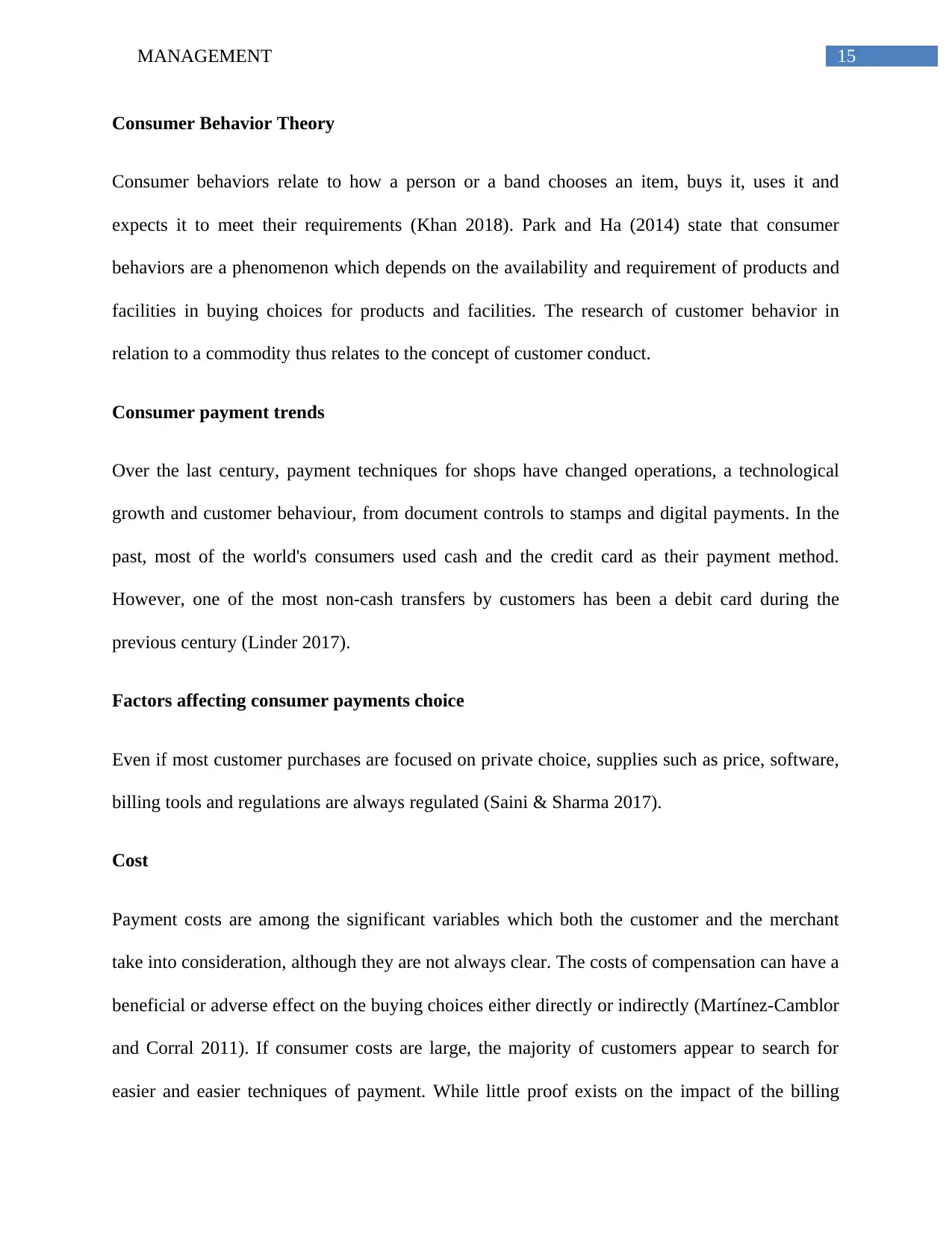
15MANAGEMENT
Consumer Behavior Theory
Consumer behaviors relate to how a person or a band chooses an item, buys it, uses it and
expects it to meet their requirements (Khan 2018). Park and Ha (2014) state that consumer
behaviors are a phenomenon which depends on the availability and requirement of products and
facilities in buying choices for products and facilities. The research of customer behavior in
relation to a commodity thus relates to the concept of customer conduct.
Consumer payment trends
Over the last century, payment techniques for shops have changed operations, a technological
growth and customer behaviour, from document controls to stamps and digital payments. In the
past, most of the world's consumers used cash and the credit card as their payment method.
However, one of the most non-cash transfers by customers has been a debit card during the
previous century (Linder 2017).
Factors affecting consumer payments choice
Even if most customer purchases are focused on private choice, supplies such as price, software,
billing tools and regulations are always regulated (Saini & Sharma 2017).
Cost
Payment costs are among the significant variables which both the customer and the merchant
take into consideration, although they are not always clear. The costs of compensation can have a
beneficial or adverse effect on the buying choices either directly or indirectly (Martínez-Camblor
and Corral 2011). If consumer costs are large, the majority of customers appear to search for
easier and easier techniques of payment. While little proof exists on the impact of the billing
Consumer Behavior Theory
Consumer behaviors relate to how a person or a band chooses an item, buys it, uses it and
expects it to meet their requirements (Khan 2018). Park and Ha (2014) state that consumer
behaviors are a phenomenon which depends on the availability and requirement of products and
facilities in buying choices for products and facilities. The research of customer behavior in
relation to a commodity thus relates to the concept of customer conduct.
Consumer payment trends
Over the last century, payment techniques for shops have changed operations, a technological
growth and customer behaviour, from document controls to stamps and digital payments. In the
past, most of the world's consumers used cash and the credit card as their payment method.
However, one of the most non-cash transfers by customers has been a debit card during the
previous century (Linder 2017).
Factors affecting consumer payments choice
Even if most customer purchases are focused on private choice, supplies such as price, software,
billing tools and regulations are always regulated (Saini & Sharma 2017).
Cost
Payment costs are among the significant variables which both the customer and the merchant
take into consideration, although they are not always clear. The costs of compensation can have a
beneficial or adverse effect on the buying choices either directly or indirectly (Martínez-Camblor
and Corral 2011). If consumer costs are large, the majority of customers appear to search for
easier and easier techniques of payment. While little proof exists on the impact of the billing
Secure Best Marks with AI Grader
Need help grading? Try our AI Grader for instant feedback on your assignments.
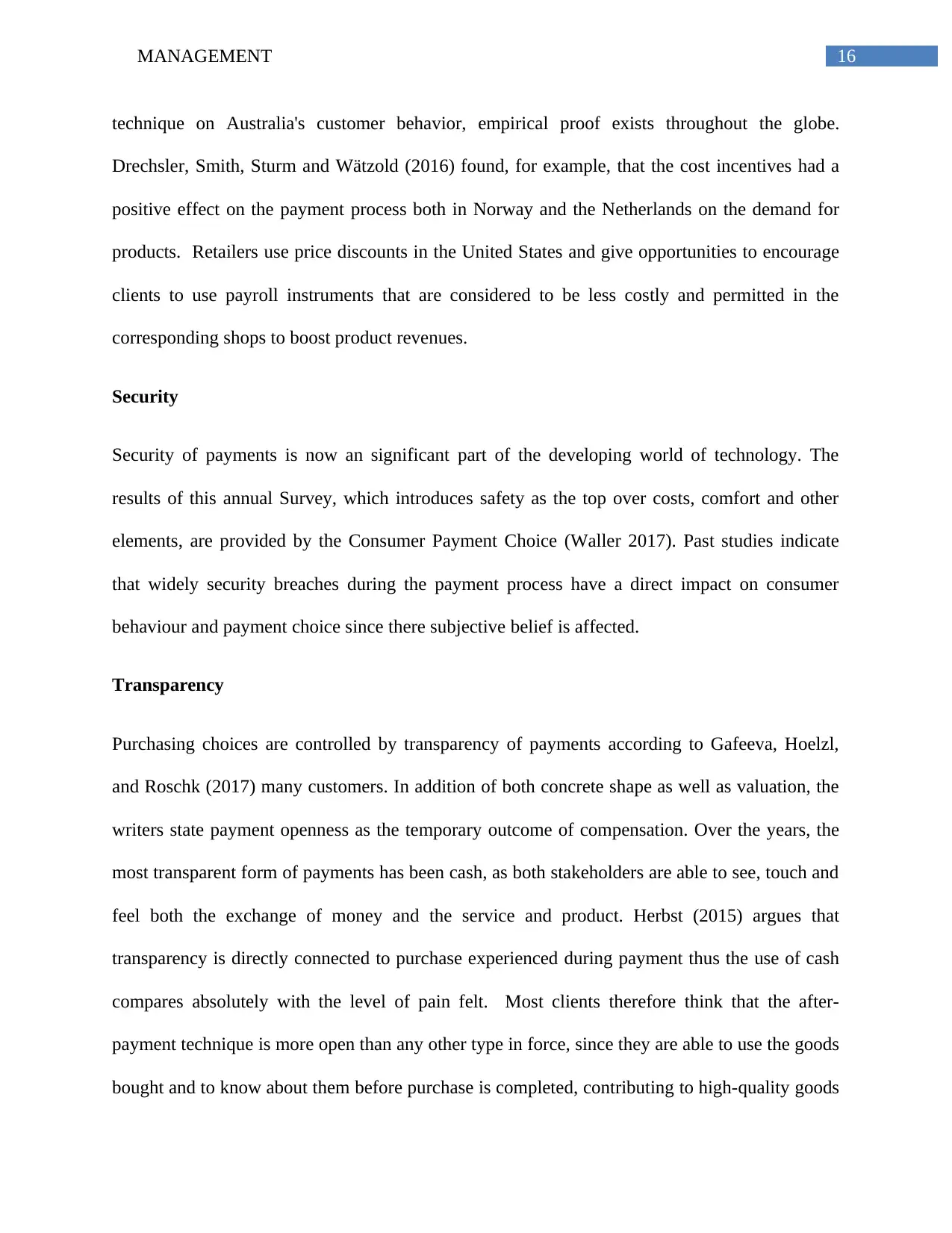
16MANAGEMENT
technique on Australia's customer behavior, empirical proof exists throughout the globe.
Drechsler, Smith, Sturm and Wätzold (2016) found, for example, that the cost incentives had a
positive effect on the payment process both in Norway and the Netherlands on the demand for
products. Retailers use price discounts in the United States and give opportunities to encourage
clients to use payroll instruments that are considered to be less costly and permitted in the
corresponding shops to boost product revenues.
Security
Security of payments is now an significant part of the developing world of technology. The
results of this annual Survey, which introduces safety as the top over costs, comfort and other
elements, are provided by the Consumer Payment Choice (Waller 2017). Past studies indicate
that widely security breaches during the payment process have a direct impact on consumer
behaviour and payment choice since there subjective belief is affected.
Transparency
Purchasing choices are controlled by transparency of payments according to Gafeeva, Hoelzl,
and Roschk (2017) many customers. In addition of both concrete shape as well as valuation, the
writers state payment openness as the temporary outcome of compensation. Over the years, the
most transparent form of payments has been cash, as both stakeholders are able to see, touch and
feel both the exchange of money and the service and product. Herbst (2015) argues that
transparency is directly connected to purchase experienced during payment thus the use of cash
compares absolutely with the level of pain felt. Most clients therefore think that the after-
payment technique is more open than any other type in force, since they are able to use the goods
bought and to know about them before purchase is completed, contributing to high-quality goods
technique on Australia's customer behavior, empirical proof exists throughout the globe.
Drechsler, Smith, Sturm and Wätzold (2016) found, for example, that the cost incentives had a
positive effect on the payment process both in Norway and the Netherlands on the demand for
products. Retailers use price discounts in the United States and give opportunities to encourage
clients to use payroll instruments that are considered to be less costly and permitted in the
corresponding shops to boost product revenues.
Security
Security of payments is now an significant part of the developing world of technology. The
results of this annual Survey, which introduces safety as the top over costs, comfort and other
elements, are provided by the Consumer Payment Choice (Waller 2017). Past studies indicate
that widely security breaches during the payment process have a direct impact on consumer
behaviour and payment choice since there subjective belief is affected.
Transparency
Purchasing choices are controlled by transparency of payments according to Gafeeva, Hoelzl,
and Roschk (2017) many customers. In addition of both concrete shape as well as valuation, the
writers state payment openness as the temporary outcome of compensation. Over the years, the
most transparent form of payments has been cash, as both stakeholders are able to see, touch and
feel both the exchange of money and the service and product. Herbst (2015) argues that
transparency is directly connected to purchase experienced during payment thus the use of cash
compares absolutely with the level of pain felt. Most clients therefore think that the after-
payment technique is more open than any other type in force, since they are able to use the goods
bought and to know about them before purchase is completed, contributing to high-quality goods
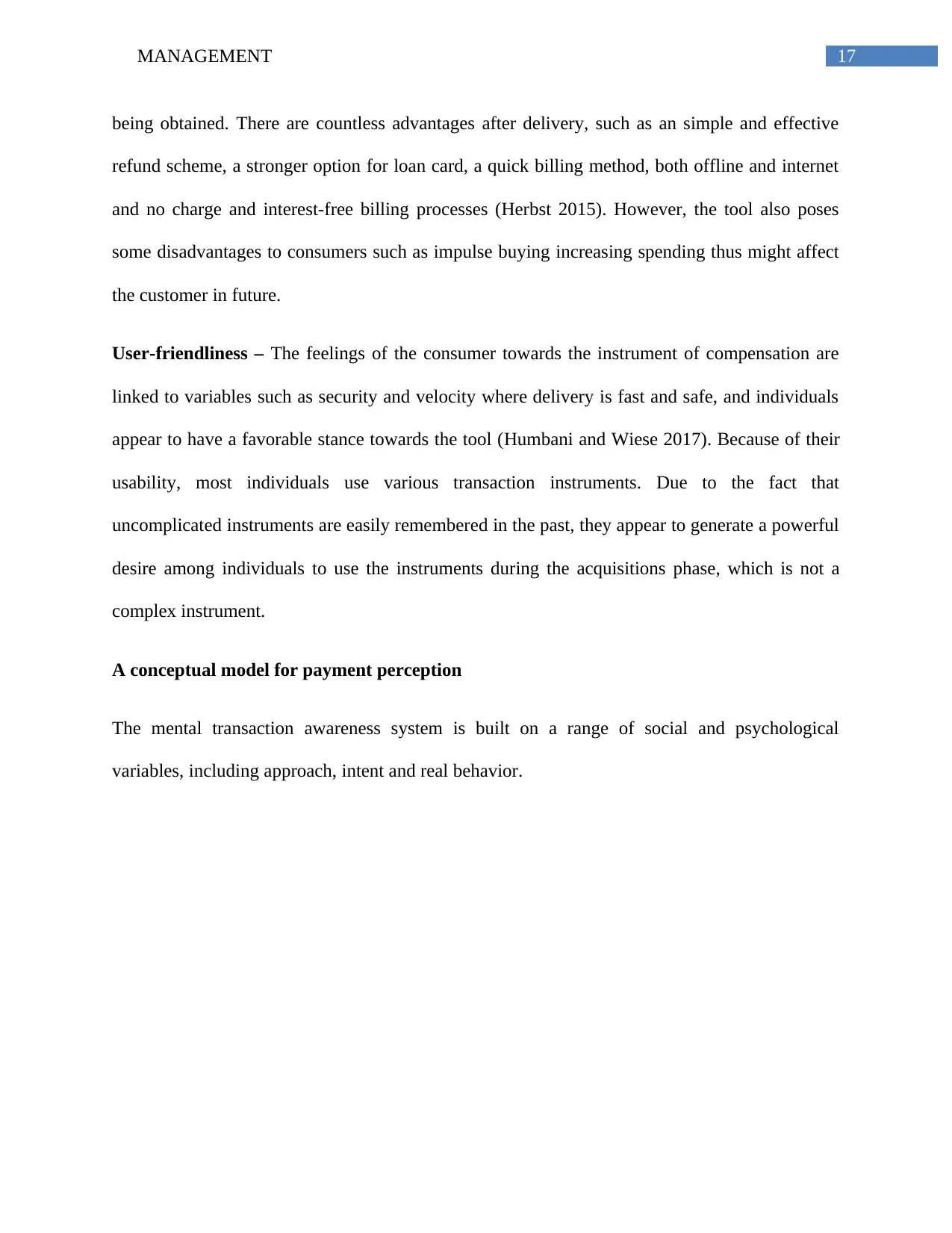
17MANAGEMENT
being obtained. There are countless advantages after delivery, such as an simple and effective
refund scheme, a stronger option for loan card, a quick billing method, both offline and internet
and no charge and interest-free billing processes (Herbst 2015). However, the tool also poses
some disadvantages to consumers such as impulse buying increasing spending thus might affect
the customer in future.
User-friendliness – The feelings of the consumer towards the instrument of compensation are
linked to variables such as security and velocity where delivery is fast and safe, and individuals
appear to have a favorable stance towards the tool (Humbani and Wiese 2017). Because of their
usability, most individuals use various transaction instruments. Due to the fact that
uncomplicated instruments are easily remembered in the past, they appear to generate a powerful
desire among individuals to use the instruments during the acquisitions phase, which is not a
complex instrument.
A conceptual model for payment perception
The mental transaction awareness system is built on a range of social and psychological
variables, including approach, intent and real behavior.
being obtained. There are countless advantages after delivery, such as an simple and effective
refund scheme, a stronger option for loan card, a quick billing method, both offline and internet
and no charge and interest-free billing processes (Herbst 2015). However, the tool also poses
some disadvantages to consumers such as impulse buying increasing spending thus might affect
the customer in future.
User-friendliness – The feelings of the consumer towards the instrument of compensation are
linked to variables such as security and velocity where delivery is fast and safe, and individuals
appear to have a favorable stance towards the tool (Humbani and Wiese 2017). Because of their
usability, most individuals use various transaction instruments. Due to the fact that
uncomplicated instruments are easily remembered in the past, they appear to generate a powerful
desire among individuals to use the instruments during the acquisitions phase, which is not a
complex instrument.
A conceptual model for payment perception
The mental transaction awareness system is built on a range of social and psychological
variables, including approach, intent and real behavior.
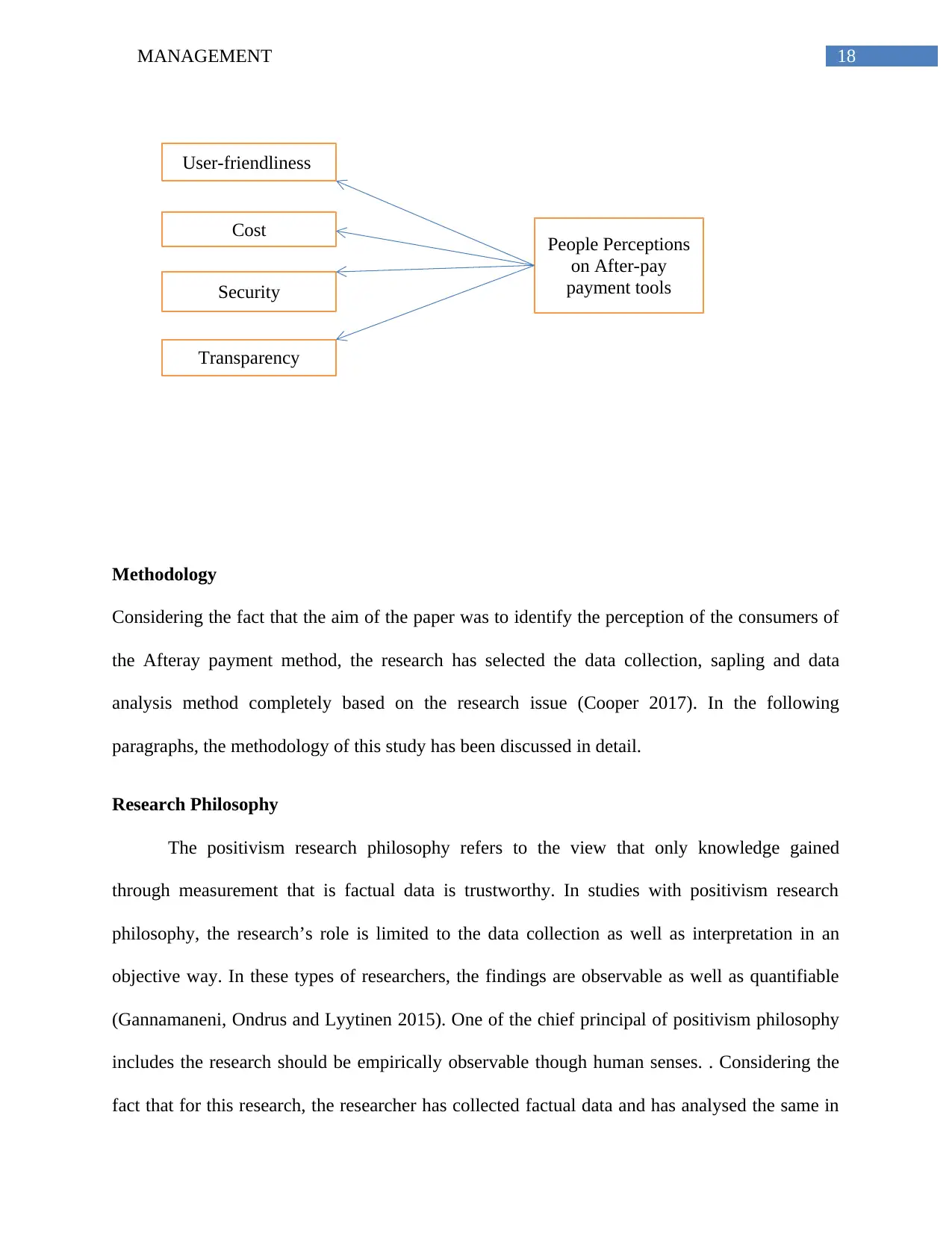
18MANAGEMENT
User-friendliness
Security
Transparency
Cost People Perceptions
on After-pay
payment tools
Methodology
Considering the fact that the aim of the paper was to identify the perception of the consumers of
the Afteray payment method, the research has selected the data collection, sapling and data
analysis method completely based on the research issue (Cooper 2017). In the following
paragraphs, the methodology of this study has been discussed in detail.
Research Philosophy
The positivism research philosophy refers to the view that only knowledge gained
through measurement that is factual data is trustworthy. In studies with positivism research
philosophy, the research’s role is limited to the data collection as well as interpretation in an
objective way. In these types of researchers, the findings are observable as well as quantifiable
(Gannamaneni, Ondrus and Lyytinen 2015). One of the chief principal of positivism philosophy
includes the research should be empirically observable though human senses. . Considering the
fact that for this research, the researcher has collected factual data and has analysed the same in
User-friendliness
Security
Transparency
Cost People Perceptions
on After-pay
payment tools
Methodology
Considering the fact that the aim of the paper was to identify the perception of the consumers of
the Afteray payment method, the research has selected the data collection, sapling and data
analysis method completely based on the research issue (Cooper 2017). In the following
paragraphs, the methodology of this study has been discussed in detail.
Research Philosophy
The positivism research philosophy refers to the view that only knowledge gained
through measurement that is factual data is trustworthy. In studies with positivism research
philosophy, the research’s role is limited to the data collection as well as interpretation in an
objective way. In these types of researchers, the findings are observable as well as quantifiable
(Gannamaneni, Ondrus and Lyytinen 2015). One of the chief principal of positivism philosophy
includes the research should be empirically observable though human senses. . Considering the
fact that for this research, the researcher has collected factual data and has analysed the same in
Paraphrase This Document
Need a fresh take? Get an instant paraphrase of this document with our AI Paraphraser
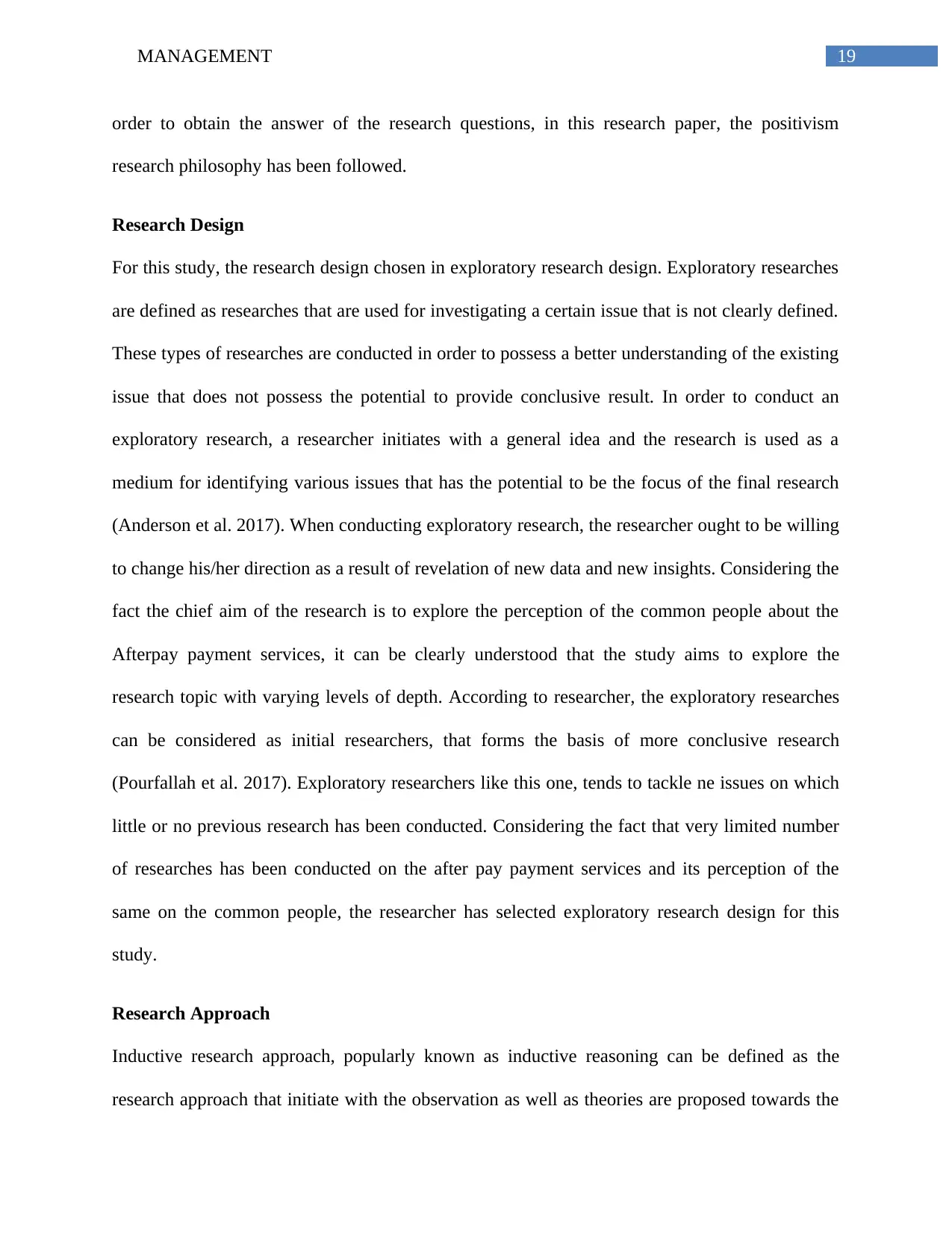
19MANAGEMENT
order to obtain the answer of the research questions, in this research paper, the positivism
research philosophy has been followed.
Research Design
For this study, the research design chosen in exploratory research design. Exploratory researches
are defined as researches that are used for investigating a certain issue that is not clearly defined.
These types of researches are conducted in order to possess a better understanding of the existing
issue that does not possess the potential to provide conclusive result. In order to conduct an
exploratory research, a researcher initiates with a general idea and the research is used as a
medium for identifying various issues that has the potential to be the focus of the final research
(Anderson et al. 2017). When conducting exploratory research, the researcher ought to be willing
to change his/her direction as a result of revelation of new data and new insights. Considering the
fact the chief aim of the research is to explore the perception of the common people about the
Afterpay payment services, it can be clearly understood that the study aims to explore the
research topic with varying levels of depth. According to researcher, the exploratory researches
can be considered as initial researchers, that forms the basis of more conclusive research
(Pourfallah et al. 2017). Exploratory researchers like this one, tends to tackle ne issues on which
little or no previous research has been conducted. Considering the fact that very limited number
of researches has been conducted on the after pay payment services and its perception of the
same on the common people, the researcher has selected exploratory research design for this
study.
Research Approach
Inductive research approach, popularly known as inductive reasoning can be defined as the
research approach that initiate with the observation as well as theories are proposed towards the
order to obtain the answer of the research questions, in this research paper, the positivism
research philosophy has been followed.
Research Design
For this study, the research design chosen in exploratory research design. Exploratory researches
are defined as researches that are used for investigating a certain issue that is not clearly defined.
These types of researches are conducted in order to possess a better understanding of the existing
issue that does not possess the potential to provide conclusive result. In order to conduct an
exploratory research, a researcher initiates with a general idea and the research is used as a
medium for identifying various issues that has the potential to be the focus of the final research
(Anderson et al. 2017). When conducting exploratory research, the researcher ought to be willing
to change his/her direction as a result of revelation of new data and new insights. Considering the
fact the chief aim of the research is to explore the perception of the common people about the
Afterpay payment services, it can be clearly understood that the study aims to explore the
research topic with varying levels of depth. According to researcher, the exploratory researches
can be considered as initial researchers, that forms the basis of more conclusive research
(Pourfallah et al. 2017). Exploratory researchers like this one, tends to tackle ne issues on which
little or no previous research has been conducted. Considering the fact that very limited number
of researches has been conducted on the after pay payment services and its perception of the
same on the common people, the researcher has selected exploratory research design for this
study.
Research Approach
Inductive research approach, popularly known as inductive reasoning can be defined as the
research approach that initiate with the observation as well as theories are proposed towards the
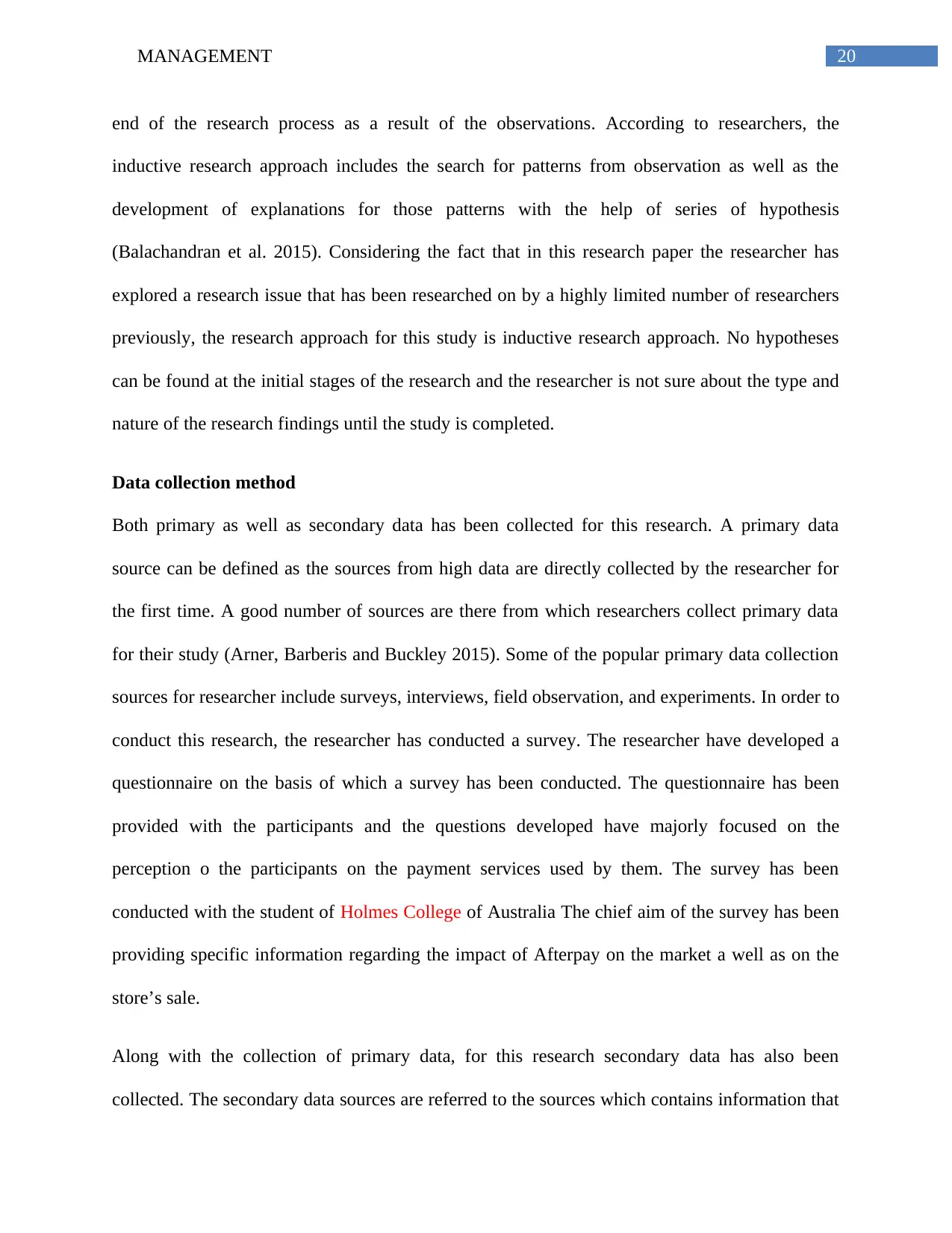
20MANAGEMENT
end of the research process as a result of the observations. According to researchers, the
inductive research approach includes the search for patterns from observation as well as the
development of explanations for those patterns with the help of series of hypothesis
(Balachandran et al. 2015). Considering the fact that in this research paper the researcher has
explored a research issue that has been researched on by a highly limited number of researchers
previously, the research approach for this study is inductive research approach. No hypotheses
can be found at the initial stages of the research and the researcher is not sure about the type and
nature of the research findings until the study is completed.
Data collection method
Both primary as well as secondary data has been collected for this research. A primary data
source can be defined as the sources from high data are directly collected by the researcher for
the first time. A good number of sources are there from which researchers collect primary data
for their study (Arner, Barberis and Buckley 2015). Some of the popular primary data collection
sources for researcher include surveys, interviews, field observation, and experiments. In order to
conduct this research, the researcher has conducted a survey. The researcher have developed a
questionnaire on the basis of which a survey has been conducted. The questionnaire has been
provided with the participants and the questions developed have majorly focused on the
perception o the participants on the payment services used by them. The survey has been
conducted with the student of Holmes College of Australia The chief aim of the survey has been
providing specific information regarding the impact of Afterpay on the market a well as on the
store’s sale.
Along with the collection of primary data, for this research secondary data has also been
collected. The secondary data sources are referred to the sources which contains information that
end of the research process as a result of the observations. According to researchers, the
inductive research approach includes the search for patterns from observation as well as the
development of explanations for those patterns with the help of series of hypothesis
(Balachandran et al. 2015). Considering the fact that in this research paper the researcher has
explored a research issue that has been researched on by a highly limited number of researchers
previously, the research approach for this study is inductive research approach. No hypotheses
can be found at the initial stages of the research and the researcher is not sure about the type and
nature of the research findings until the study is completed.
Data collection method
Both primary as well as secondary data has been collected for this research. A primary data
source can be defined as the sources from high data are directly collected by the researcher for
the first time. A good number of sources are there from which researchers collect primary data
for their study (Arner, Barberis and Buckley 2015). Some of the popular primary data collection
sources for researcher include surveys, interviews, field observation, and experiments. In order to
conduct this research, the researcher has conducted a survey. The researcher have developed a
questionnaire on the basis of which a survey has been conducted. The questionnaire has been
provided with the participants and the questions developed have majorly focused on the
perception o the participants on the payment services used by them. The survey has been
conducted with the student of Holmes College of Australia The chief aim of the survey has been
providing specific information regarding the impact of Afterpay on the market a well as on the
store’s sale.
Along with the collection of primary data, for this research secondary data has also been
collected. The secondary data sources are referred to the sources which contains information that
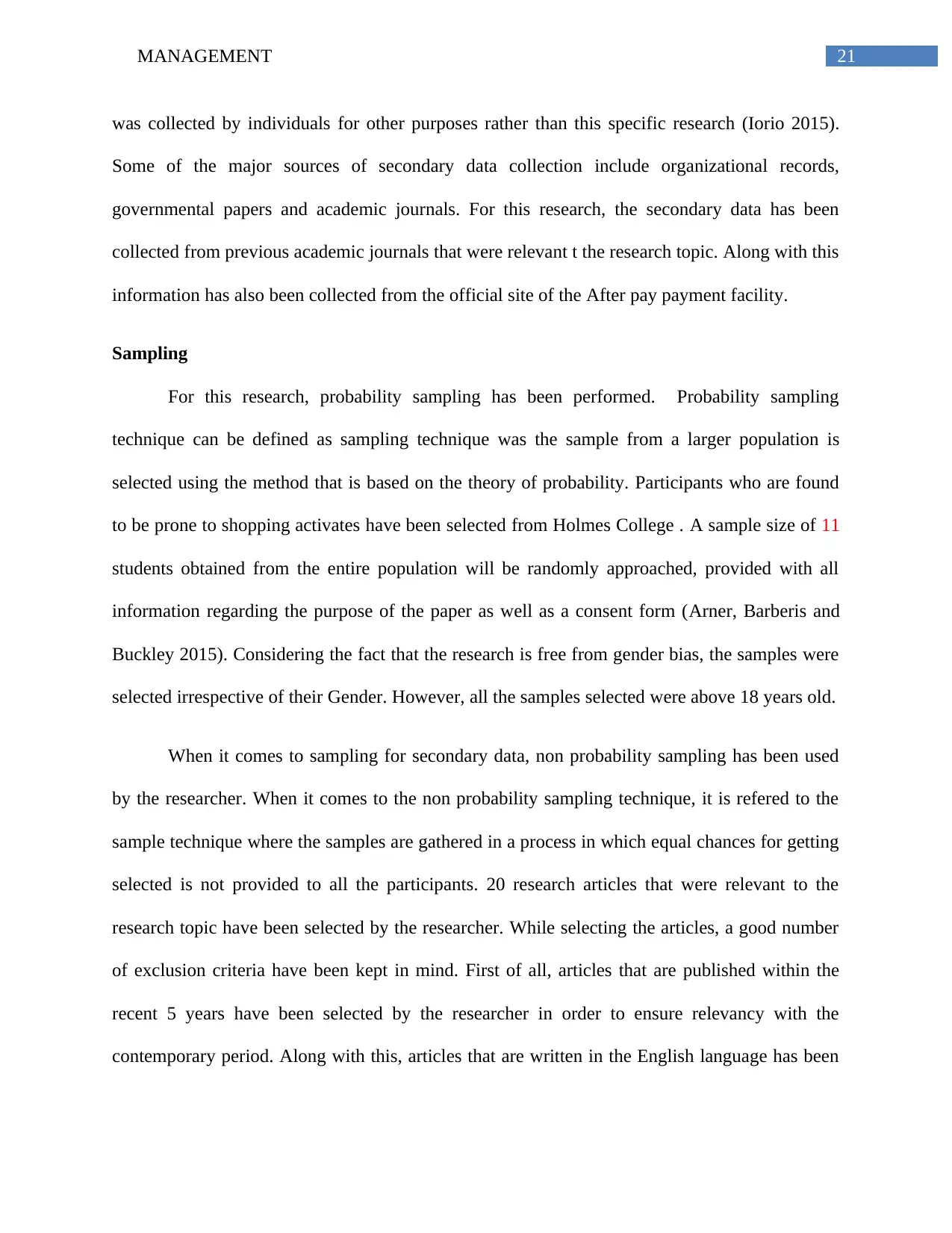
21MANAGEMENT
was collected by individuals for other purposes rather than this specific research (Iorio 2015).
Some of the major sources of secondary data collection include organizational records,
governmental papers and academic journals. For this research, the secondary data has been
collected from previous academic journals that were relevant t the research topic. Along with this
information has also been collected from the official site of the After pay payment facility.
Sampling
For this research, probability sampling has been performed. Probability sampling
technique can be defined as sampling technique was the sample from a larger population is
selected using the method that is based on the theory of probability. Participants who are found
to be prone to shopping activates have been selected from Holmes College . A sample size of 11
students obtained from the entire population will be randomly approached, provided with all
information regarding the purpose of the paper as well as a consent form (Arner, Barberis and
Buckley 2015). Considering the fact that the research is free from gender bias, the samples were
selected irrespective of their Gender. However, all the samples selected were above 18 years old.
When it comes to sampling for secondary data, non probability sampling has been used
by the researcher. When it comes to the non probability sampling technique, it is refered to the
sample technique where the samples are gathered in a process in which equal chances for getting
selected is not provided to all the participants. 20 research articles that were relevant to the
research topic have been selected by the researcher. While selecting the articles, a good number
of exclusion criteria have been kept in mind. First of all, articles that are published within the
recent 5 years have been selected by the researcher in order to ensure relevancy with the
contemporary period. Along with this, articles that are written in the English language has been
was collected by individuals for other purposes rather than this specific research (Iorio 2015).
Some of the major sources of secondary data collection include organizational records,
governmental papers and academic journals. For this research, the secondary data has been
collected from previous academic journals that were relevant t the research topic. Along with this
information has also been collected from the official site of the After pay payment facility.
Sampling
For this research, probability sampling has been performed. Probability sampling
technique can be defined as sampling technique was the sample from a larger population is
selected using the method that is based on the theory of probability. Participants who are found
to be prone to shopping activates have been selected from Holmes College . A sample size of 11
students obtained from the entire population will be randomly approached, provided with all
information regarding the purpose of the paper as well as a consent form (Arner, Barberis and
Buckley 2015). Considering the fact that the research is free from gender bias, the samples were
selected irrespective of their Gender. However, all the samples selected were above 18 years old.
When it comes to sampling for secondary data, non probability sampling has been used
by the researcher. When it comes to the non probability sampling technique, it is refered to the
sample technique where the samples are gathered in a process in which equal chances for getting
selected is not provided to all the participants. 20 research articles that were relevant to the
research topic have been selected by the researcher. While selecting the articles, a good number
of exclusion criteria have been kept in mind. First of all, articles that are published within the
recent 5 years have been selected by the researcher in order to ensure relevancy with the
contemporary period. Along with this, articles that are written in the English language has been
Secure Best Marks with AI Grader
Need help grading? Try our AI Grader for instant feedback on your assignments.
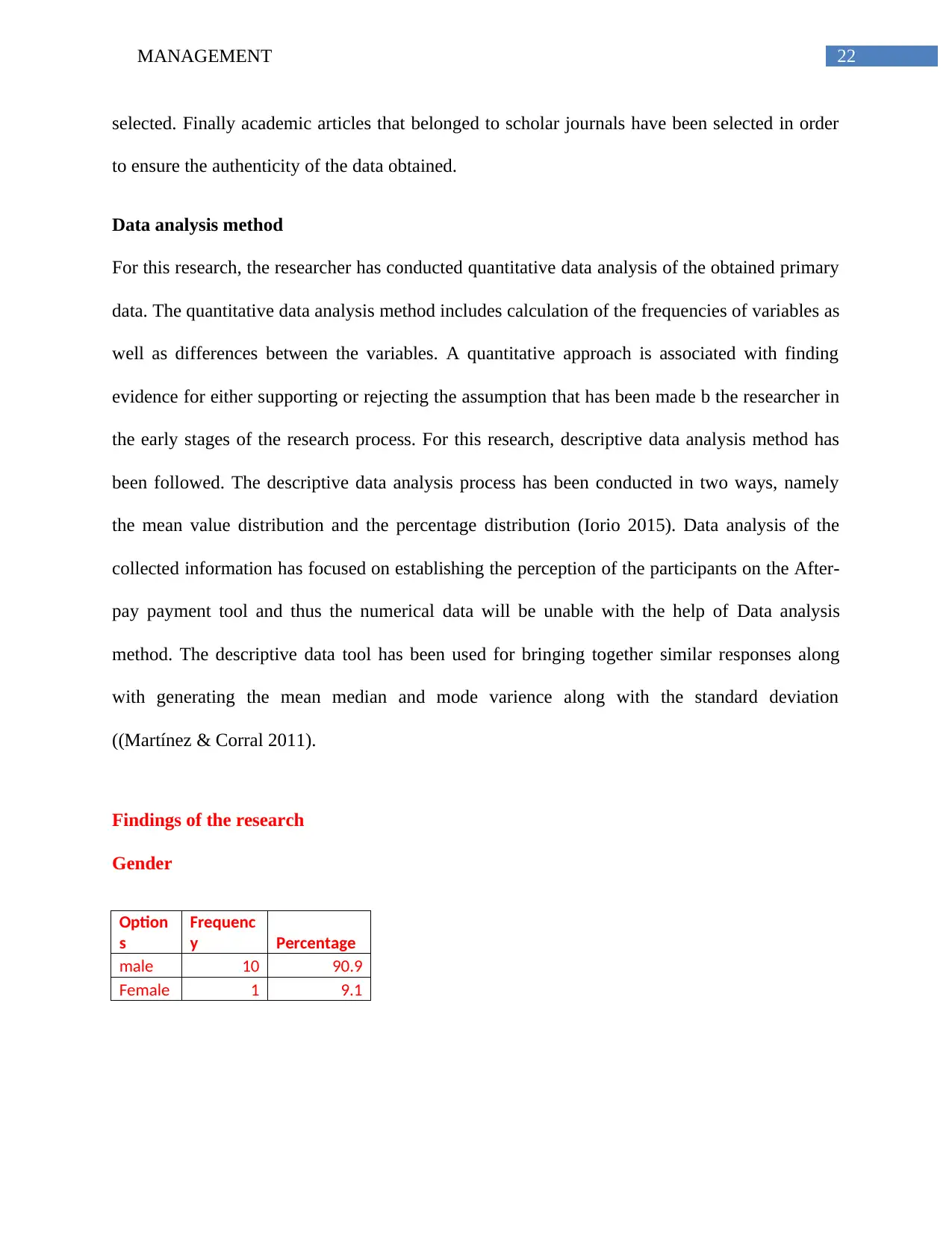
22MANAGEMENT
selected. Finally academic articles that belonged to scholar journals have been selected in order
to ensure the authenticity of the data obtained.
Data analysis method
For this research, the researcher has conducted quantitative data analysis of the obtained primary
data. The quantitative data analysis method includes calculation of the frequencies of variables as
well as differences between the variables. A quantitative approach is associated with finding
evidence for either supporting or rejecting the assumption that has been made b the researcher in
the early stages of the research process. For this research, descriptive data analysis method has
been followed. The descriptive data analysis process has been conducted in two ways, namely
the mean value distribution and the percentage distribution (Iorio 2015). Data analysis of the
collected information has focused on establishing the perception of the participants on the After-
pay payment tool and thus the numerical data will be unable with the help of Data analysis
method. The descriptive data tool has been used for bringing together similar responses along
with generating the mean median and mode varience along with the standard deviation
((Martínez & Corral 2011).
Findings of the research
Gender
Option
s
Frequenc
y Percentage
male 10 90.9
Female 1 9.1
selected. Finally academic articles that belonged to scholar journals have been selected in order
to ensure the authenticity of the data obtained.
Data analysis method
For this research, the researcher has conducted quantitative data analysis of the obtained primary
data. The quantitative data analysis method includes calculation of the frequencies of variables as
well as differences between the variables. A quantitative approach is associated with finding
evidence for either supporting or rejecting the assumption that has been made b the researcher in
the early stages of the research process. For this research, descriptive data analysis method has
been followed. The descriptive data analysis process has been conducted in two ways, namely
the mean value distribution and the percentage distribution (Iorio 2015). Data analysis of the
collected information has focused on establishing the perception of the participants on the After-
pay payment tool and thus the numerical data will be unable with the help of Data analysis
method. The descriptive data tool has been used for bringing together similar responses along
with generating the mean median and mode varience along with the standard deviation
((Martínez & Corral 2011).
Findings of the research
Gender
Option
s
Frequenc
y Percentage
male 10 90.9
Female 1 9.1
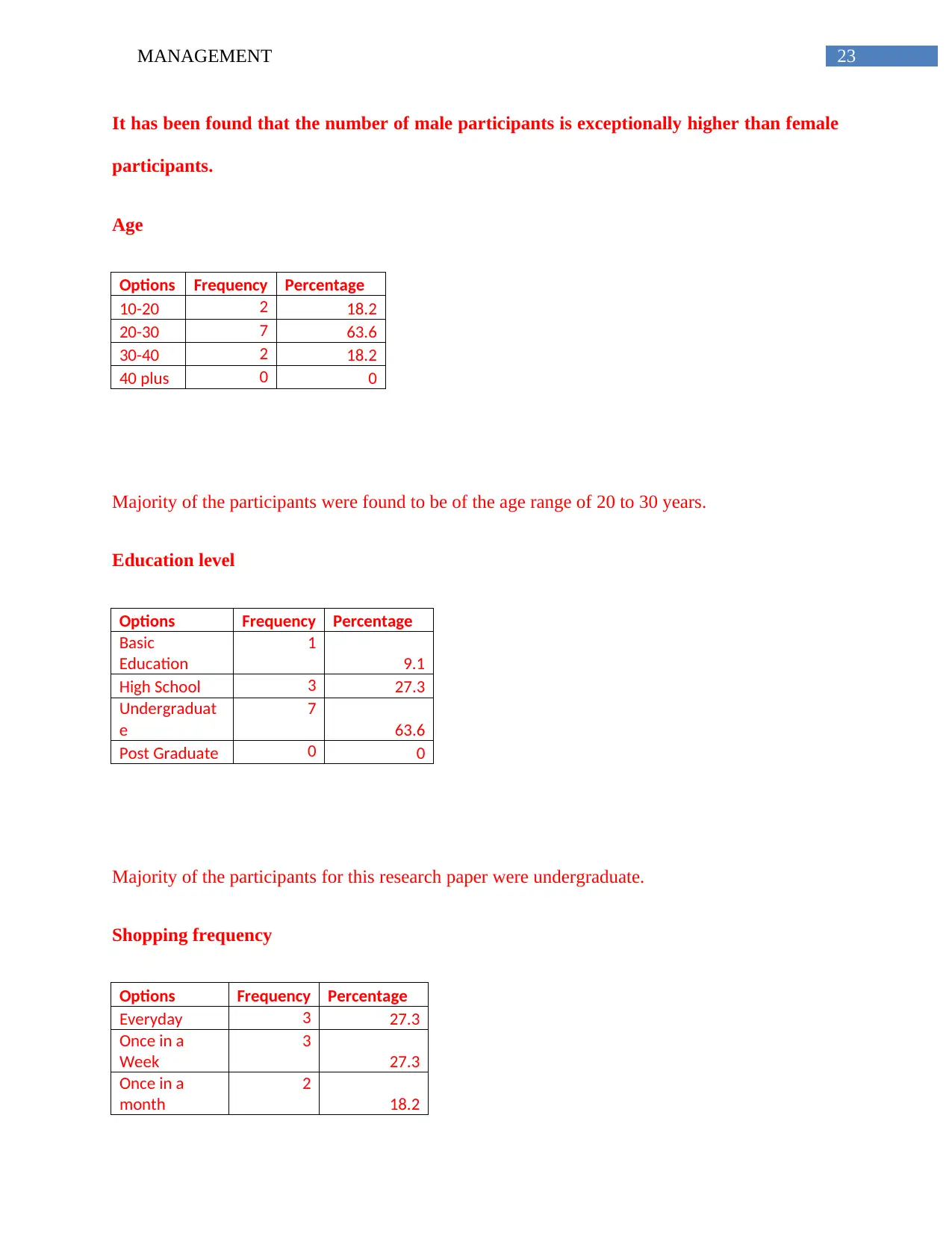
23MANAGEMENT
It has been found that the number of male participants is exceptionally higher than female
participants.
Age
Options Frequency Percentage
10-20 2 18.2
20-30 7 63.6
30-40 2 18.2
40 plus 0 0
Majority of the participants were found to be of the age range of 20 to 30 years.
Education level
Options Frequency Percentage
Basic
Education
1
9.1
High School 3 27.3
Undergraduat
e
7
63.6
Post Graduate 0 0
Majority of the participants for this research paper were undergraduate.
Shopping frequency
Options Frequency Percentage
Everyday 3 27.3
Once in a
Week
3
27.3
Once in a
month
2
18.2
It has been found that the number of male participants is exceptionally higher than female
participants.
Age
Options Frequency Percentage
10-20 2 18.2
20-30 7 63.6
30-40 2 18.2
40 plus 0 0
Majority of the participants were found to be of the age range of 20 to 30 years.
Education level
Options Frequency Percentage
Basic
Education
1
9.1
High School 3 27.3
Undergraduat
e
7
63.6
Post Graduate 0 0
Majority of the participants for this research paper were undergraduate.
Shopping frequency
Options Frequency Percentage
Everyday 3 27.3
Once in a
Week
3
27.3
Once in a
month
2
18.2
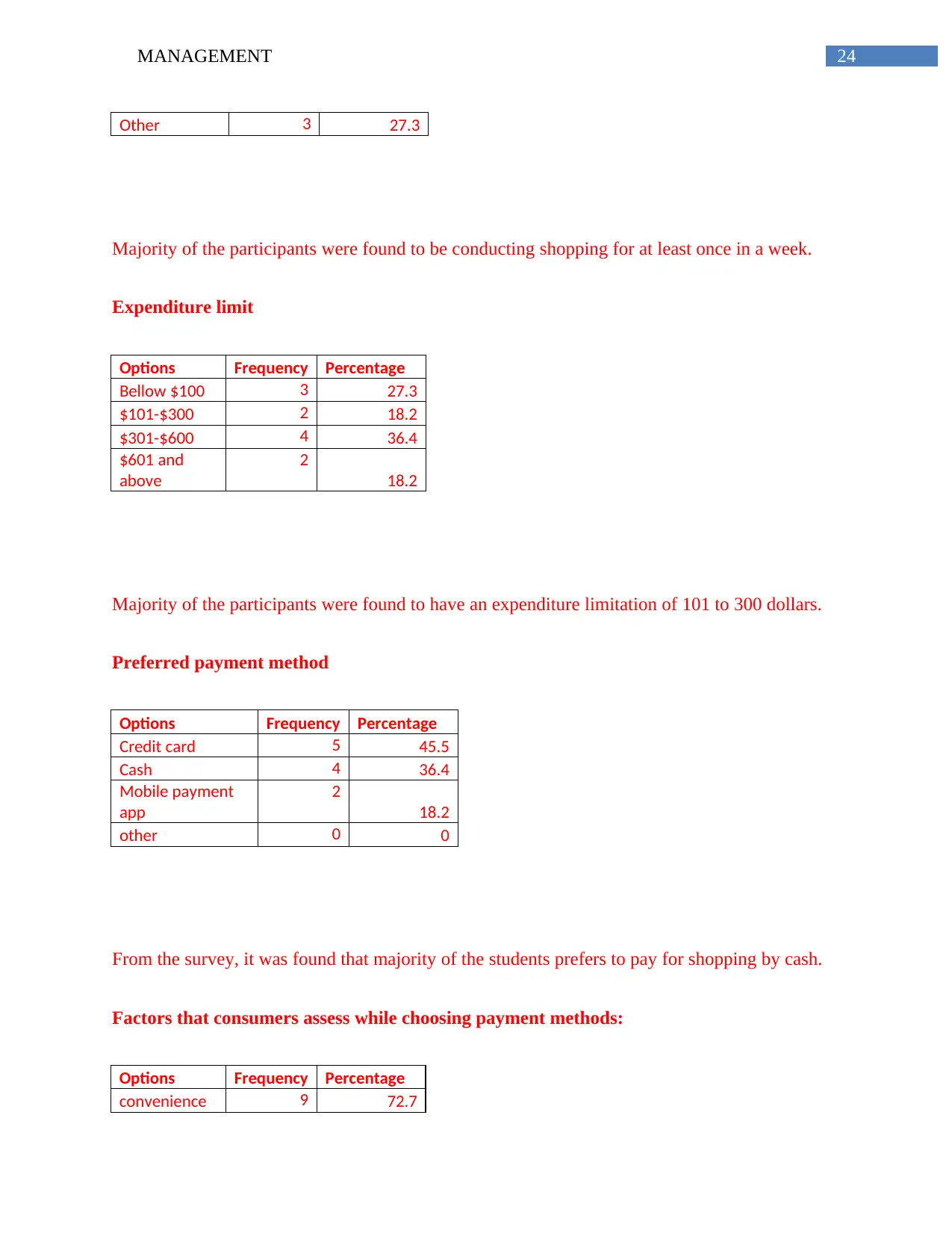
24MANAGEMENT
Other 3 27.3
Majority of the participants were found to be conducting shopping for at least once in a week.
Expenditure limit
Options Frequency Percentage
Bellow $100 3 27.3
$101-$300 2 18.2
$301-$600 4 36.4
$601 and
above
2
18.2
Majority of the participants were found to have an expenditure limitation of 101 to 300 dollars.
Preferred payment method
Options Frequency Percentage
Credit card 5 45.5
Cash 4 36.4
Mobile payment
app
2
18.2
other 0 0
From the survey, it was found that majority of the students prefers to pay for shopping by cash.
Factors that consumers assess while choosing payment methods:
Options Frequency Percentage
convenience 9 72.7
Other 3 27.3
Majority of the participants were found to be conducting shopping for at least once in a week.
Expenditure limit
Options Frequency Percentage
Bellow $100 3 27.3
$101-$300 2 18.2
$301-$600 4 36.4
$601 and
above
2
18.2
Majority of the participants were found to have an expenditure limitation of 101 to 300 dollars.
Preferred payment method
Options Frequency Percentage
Credit card 5 45.5
Cash 4 36.4
Mobile payment
app
2
18.2
other 0 0
From the survey, it was found that majority of the students prefers to pay for shopping by cash.
Factors that consumers assess while choosing payment methods:
Options Frequency Percentage
convenience 9 72.7
Paraphrase This Document
Need a fresh take? Get an instant paraphrase of this document with our AI Paraphraser
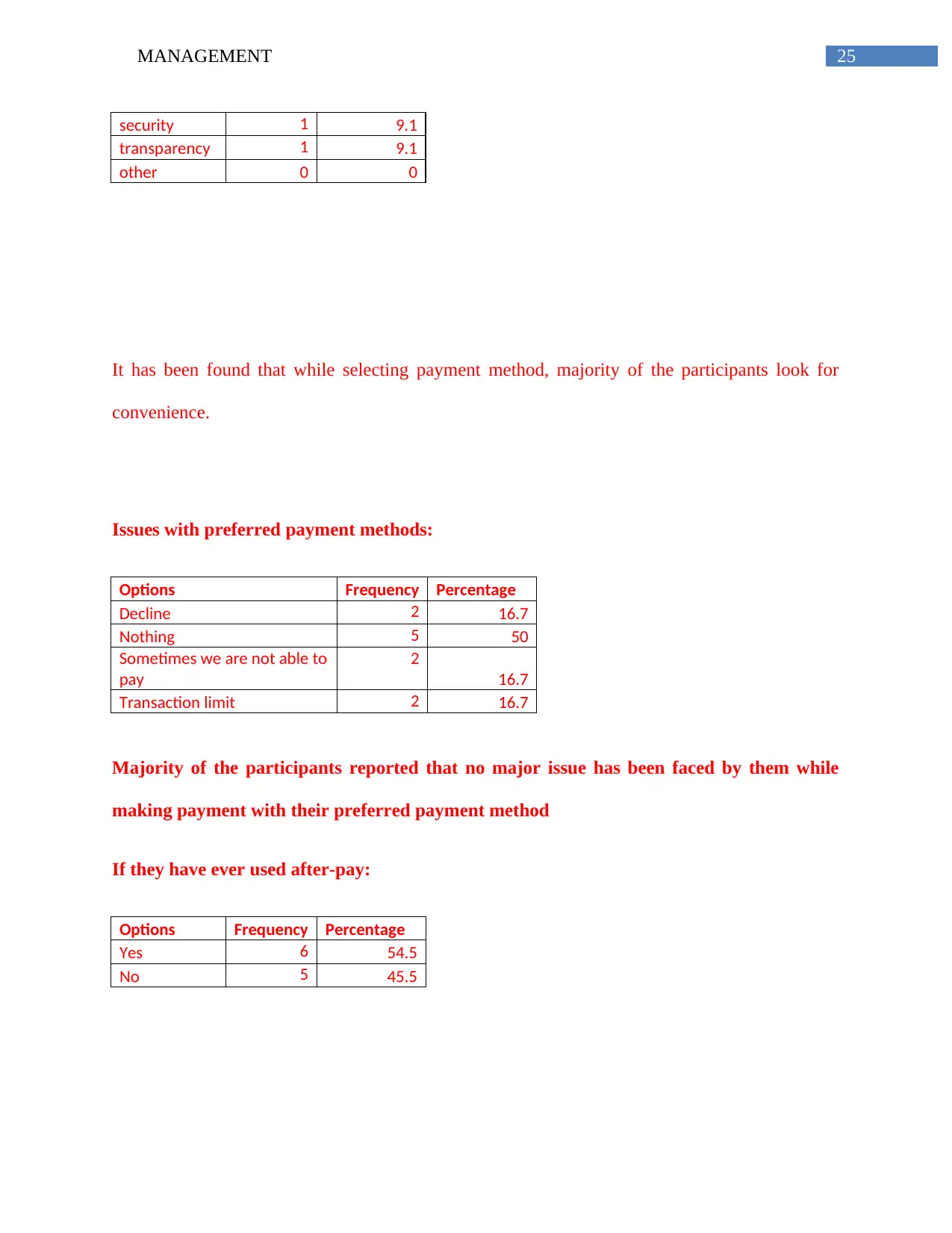
25MANAGEMENT
security 1 9.1
transparency 1 9.1
other 0 0
It has been found that while selecting payment method, majority of the participants look for
convenience.
Issues with preferred payment methods:
Options Frequency Percentage
Decline 2 16.7
Nothing 5 50
Sometimes we are not able to
pay
2
16.7
Transaction limit 2 16.7
Majority of the participants reported that no major issue has been faced by them while
making payment with their preferred payment method
If they have ever used after-pay:
Options Frequency Percentage
Yes 6 54.5
No 5 45.5
security 1 9.1
transparency 1 9.1
other 0 0
It has been found that while selecting payment method, majority of the participants look for
convenience.
Issues with preferred payment methods:
Options Frequency Percentage
Decline 2 16.7
Nothing 5 50
Sometimes we are not able to
pay
2
16.7
Transaction limit 2 16.7
Majority of the participants reported that no major issue has been faced by them while
making payment with their preferred payment method
If they have ever used after-pay:
Options Frequency Percentage
Yes 6 54.5
No 5 45.5
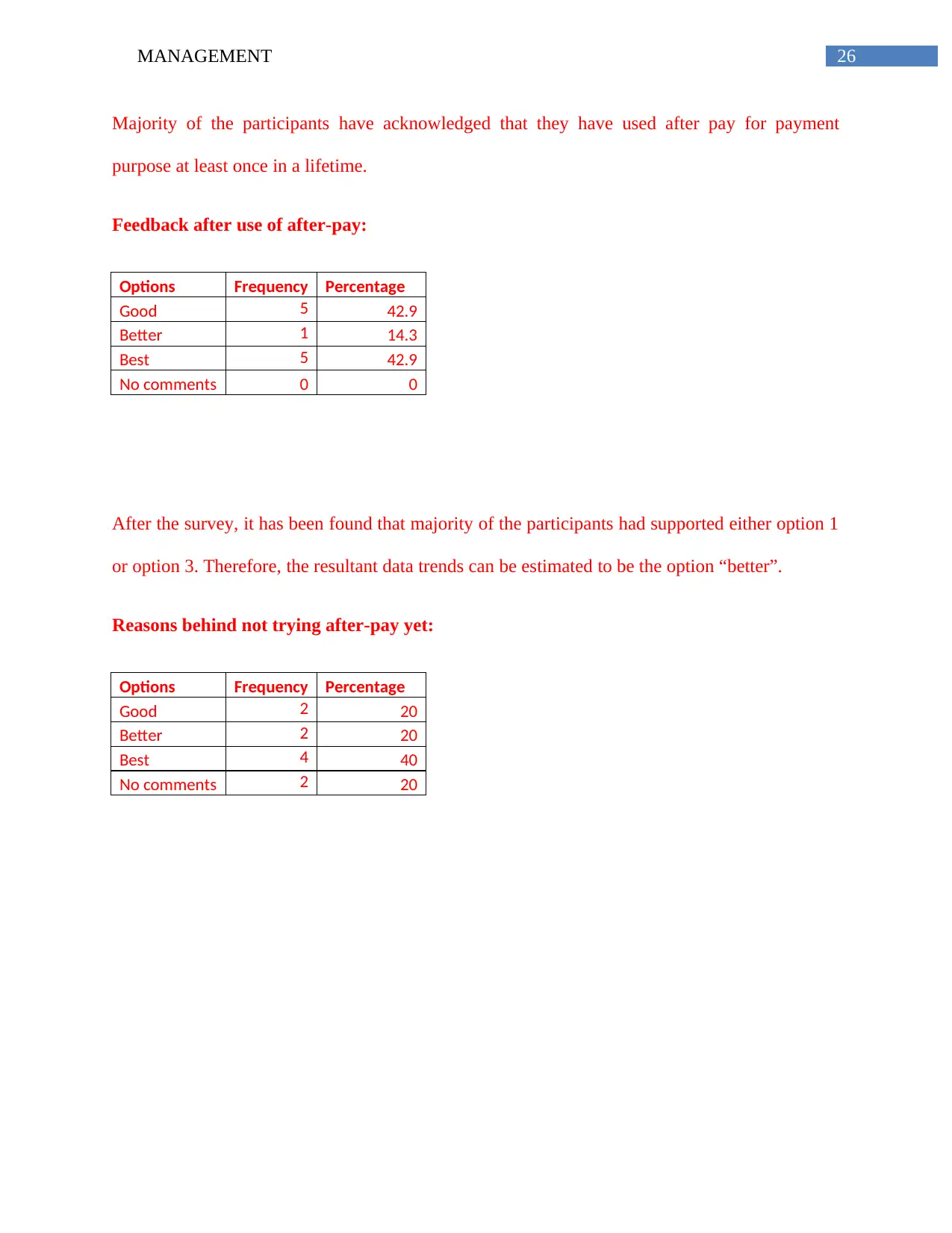
26MANAGEMENT
Majority of the participants have acknowledged that they have used after pay for payment
purpose at least once in a lifetime.
Feedback after use of after-pay:
Options Frequency Percentage
Good 5 42.9
Better 1 14.3
Best 5 42.9
No comments 0 0
After the survey, it has been found that majority of the participants had supported either option 1
or option 3. Therefore, the resultant data trends can be estimated to be the option “better”.
Reasons behind not trying after-pay yet:
Options Frequency Percentage
Good 2 20
Better 2 20
Best 4 40
No comments 2 20
Majority of the participants have acknowledged that they have used after pay for payment
purpose at least once in a lifetime.
Feedback after use of after-pay:
Options Frequency Percentage
Good 5 42.9
Better 1 14.3
Best 5 42.9
No comments 0 0
After the survey, it has been found that majority of the participants had supported either option 1
or option 3. Therefore, the resultant data trends can be estimated to be the option “better”.
Reasons behind not trying after-pay yet:
Options Frequency Percentage
Good 2 20
Better 2 20
Best 4 40
No comments 2 20
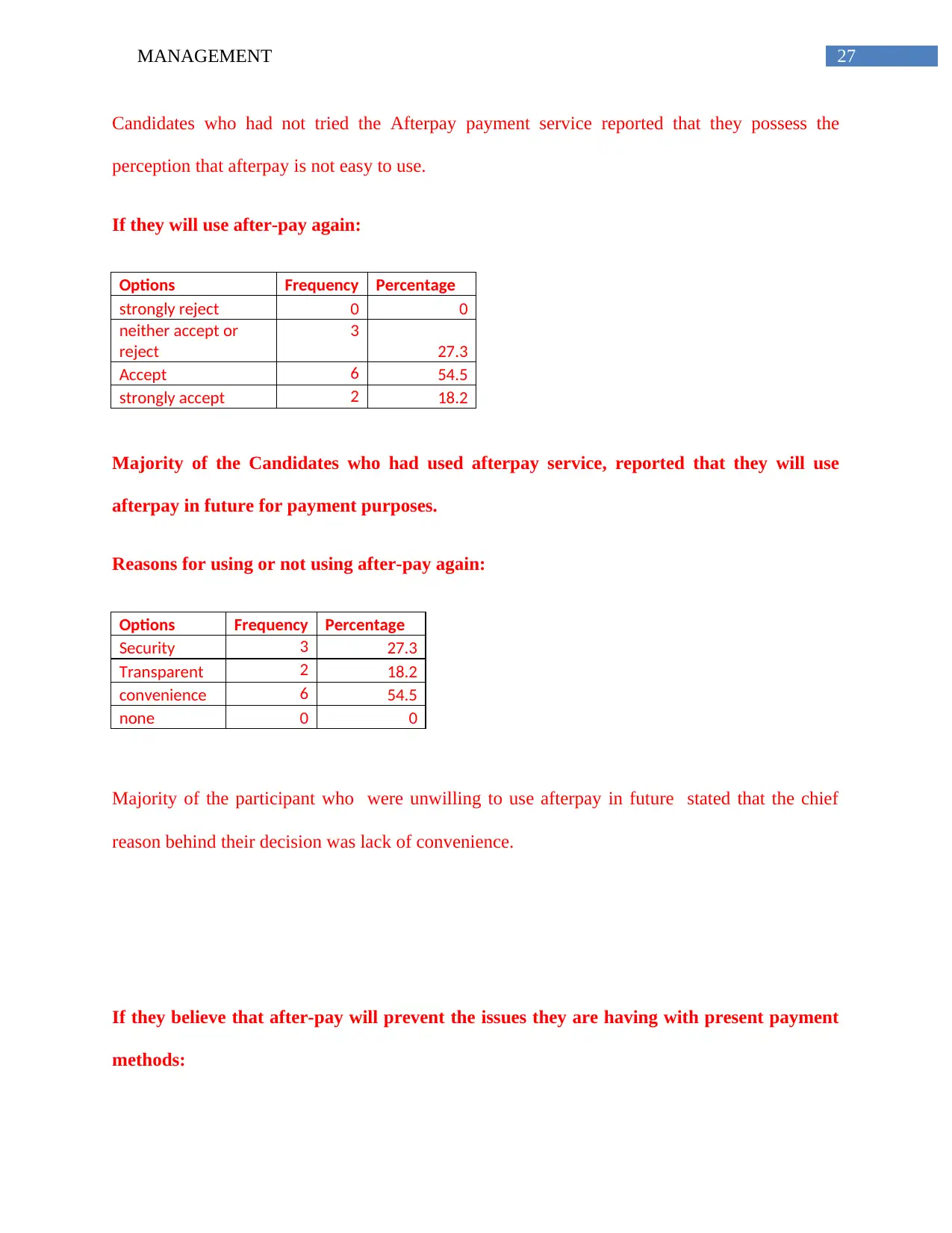
27MANAGEMENT
Candidates who had not tried the Afterpay payment service reported that they possess the
perception that afterpay is not easy to use.
If they will use after-pay again:
Options Frequency Percentage
strongly reject 0 0
neither accept or
reject
3
27.3
Accept 6 54.5
strongly accept 2 18.2
Majority of the Candidates who had used afterpay service, reported that they will use
afterpay in future for payment purposes.
Reasons for using or not using after-pay again:
Options Frequency Percentage
Security 3 27.3
Transparent 2 18.2
convenience 6 54.5
none 0 0
Majority of the participant who were unwilling to use afterpay in future stated that the chief
reason behind their decision was lack of convenience.
If they believe that after-pay will prevent the issues they are having with present payment
methods:
Candidates who had not tried the Afterpay payment service reported that they possess the
perception that afterpay is not easy to use.
If they will use after-pay again:
Options Frequency Percentage
strongly reject 0 0
neither accept or
reject
3
27.3
Accept 6 54.5
strongly accept 2 18.2
Majority of the Candidates who had used afterpay service, reported that they will use
afterpay in future for payment purposes.
Reasons for using or not using after-pay again:
Options Frequency Percentage
Security 3 27.3
Transparent 2 18.2
convenience 6 54.5
none 0 0
Majority of the participant who were unwilling to use afterpay in future stated that the chief
reason behind their decision was lack of convenience.
If they believe that after-pay will prevent the issues they are having with present payment
methods:
Secure Best Marks with AI Grader
Need help grading? Try our AI Grader for instant feedback on your assignments.
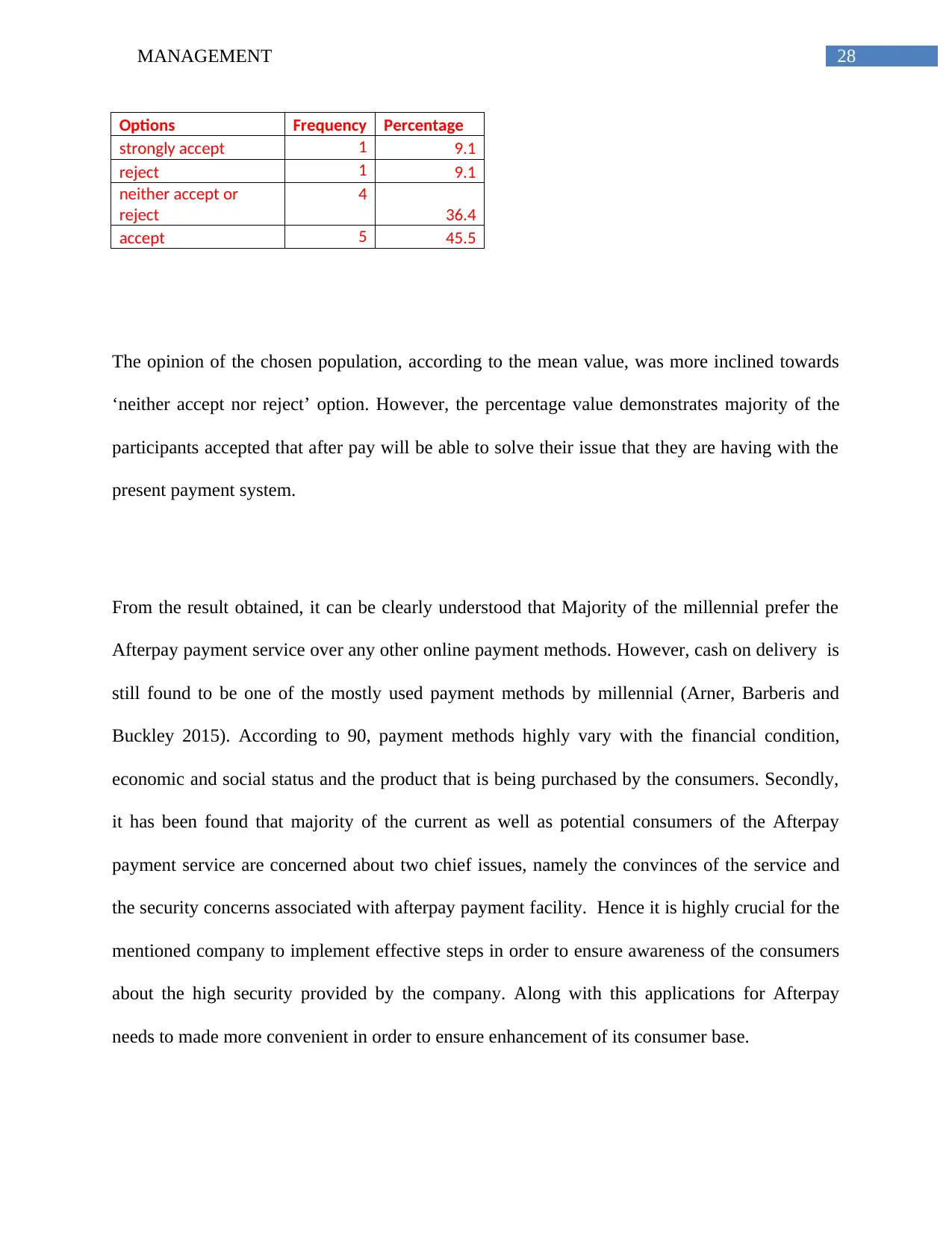
28MANAGEMENT
Options Frequency Percentage
strongly accept 1 9.1
reject 1 9.1
neither accept or
reject
4
36.4
accept 5 45.5
The opinion of the chosen population, according to the mean value, was more inclined towards
‘neither accept nor reject’ option. However, the percentage value demonstrates majority of the
participants accepted that after pay will be able to solve their issue that they are having with the
present payment system.
From the result obtained, it can be clearly understood that Majority of the millennial prefer the
Afterpay payment service over any other online payment methods. However, cash on delivery is
still found to be one of the mostly used payment methods by millennial (Arner, Barberis and
Buckley 2015). According to 90, payment methods highly vary with the financial condition,
economic and social status and the product that is being purchased by the consumers. Secondly,
it has been found that majority of the current as well as potential consumers of the Afterpay
payment service are concerned about two chief issues, namely the convinces of the service and
the security concerns associated with afterpay payment facility. Hence it is highly crucial for the
mentioned company to implement effective steps in order to ensure awareness of the consumers
about the high security provided by the company. Along with this applications for Afterpay
needs to made more convenient in order to ensure enhancement of its consumer base.
Options Frequency Percentage
strongly accept 1 9.1
reject 1 9.1
neither accept or
reject
4
36.4
accept 5 45.5
The opinion of the chosen population, according to the mean value, was more inclined towards
‘neither accept nor reject’ option. However, the percentage value demonstrates majority of the
participants accepted that after pay will be able to solve their issue that they are having with the
present payment system.
From the result obtained, it can be clearly understood that Majority of the millennial prefer the
Afterpay payment service over any other online payment methods. However, cash on delivery is
still found to be one of the mostly used payment methods by millennial (Arner, Barberis and
Buckley 2015). According to 90, payment methods highly vary with the financial condition,
economic and social status and the product that is being purchased by the consumers. Secondly,
it has been found that majority of the current as well as potential consumers of the Afterpay
payment service are concerned about two chief issues, namely the convinces of the service and
the security concerns associated with afterpay payment facility. Hence it is highly crucial for the
mentioned company to implement effective steps in order to ensure awareness of the consumers
about the high security provided by the company. Along with this applications for Afterpay
needs to made more convenient in order to ensure enhancement of its consumer base.
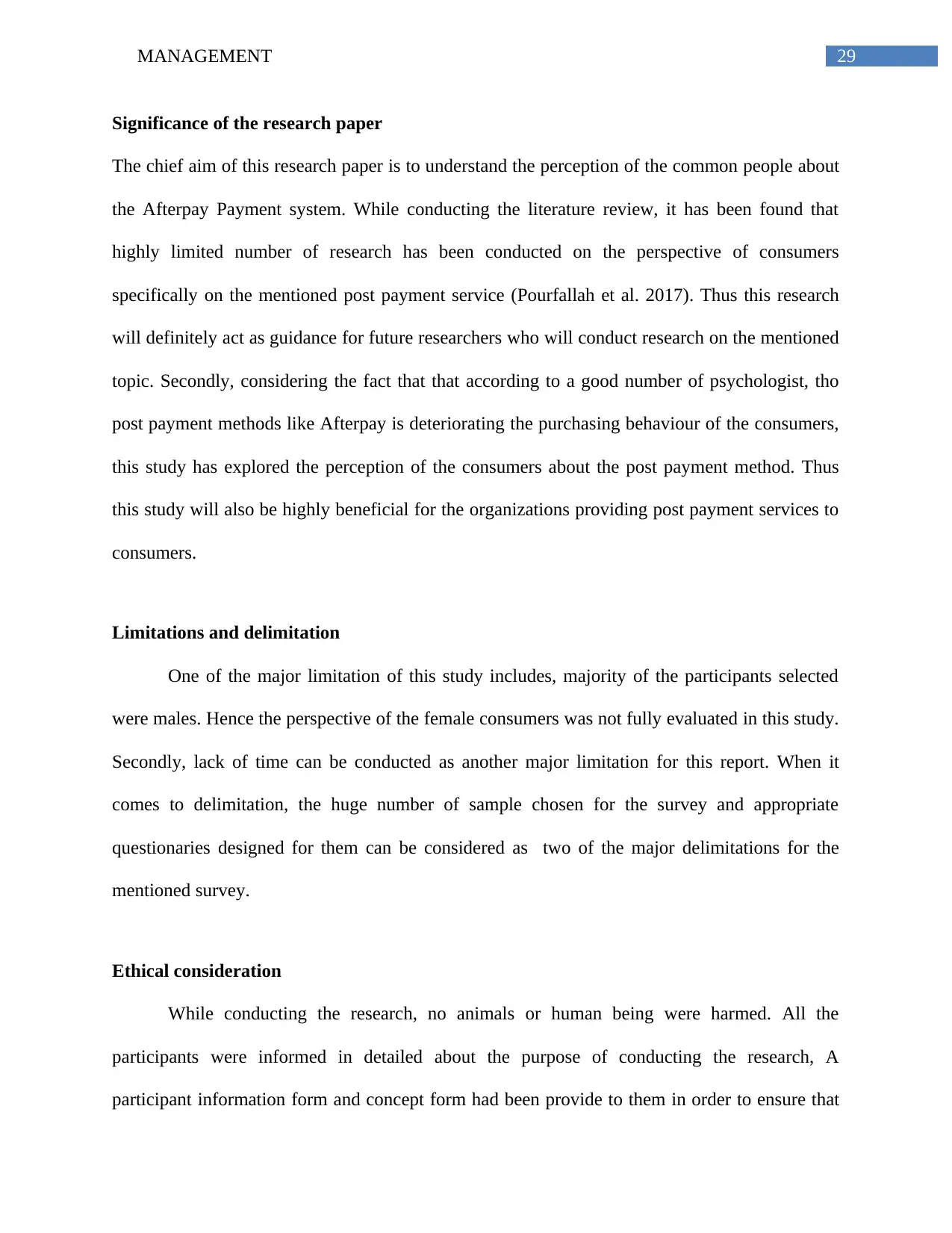
29MANAGEMENT
Significance of the research paper
The chief aim of this research paper is to understand the perception of the common people about
the Afterpay Payment system. While conducting the literature review, it has been found that
highly limited number of research has been conducted on the perspective of consumers
specifically on the mentioned post payment service (Pourfallah et al. 2017). Thus this research
will definitely act as guidance for future researchers who will conduct research on the mentioned
topic. Secondly, considering the fact that that according to a good number of psychologist, tho
post payment methods like Afterpay is deteriorating the purchasing behaviour of the consumers,
this study has explored the perception of the consumers about the post payment method. Thus
this study will also be highly beneficial for the organizations providing post payment services to
consumers.
Limitations and delimitation
One of the major limitation of this study includes, majority of the participants selected
were males. Hence the perspective of the female consumers was not fully evaluated in this study.
Secondly, lack of time can be conducted as another major limitation for this report. When it
comes to delimitation, the huge number of sample chosen for the survey and appropriate
questionaries designed for them can be considered as two of the major delimitations for the
mentioned survey.
Ethical consideration
While conducting the research, no animals or human being were harmed. All the
participants were informed in detailed about the purpose of conducting the research, A
participant information form and concept form had been provide to them in order to ensure that
Significance of the research paper
The chief aim of this research paper is to understand the perception of the common people about
the Afterpay Payment system. While conducting the literature review, it has been found that
highly limited number of research has been conducted on the perspective of consumers
specifically on the mentioned post payment service (Pourfallah et al. 2017). Thus this research
will definitely act as guidance for future researchers who will conduct research on the mentioned
topic. Secondly, considering the fact that that according to a good number of psychologist, tho
post payment methods like Afterpay is deteriorating the purchasing behaviour of the consumers,
this study has explored the perception of the consumers about the post payment method. Thus
this study will also be highly beneficial for the organizations providing post payment services to
consumers.
Limitations and delimitation
One of the major limitation of this study includes, majority of the participants selected
were males. Hence the perspective of the female consumers was not fully evaluated in this study.
Secondly, lack of time can be conducted as another major limitation for this report. When it
comes to delimitation, the huge number of sample chosen for the survey and appropriate
questionaries designed for them can be considered as two of the major delimitations for the
mentioned survey.
Ethical consideration
While conducting the research, no animals or human being were harmed. All the
participants were informed in detailed about the purpose of conducting the research, A
participant information form and concept form had been provide to them in order to ensure that

30MANAGEMENT
participants are participating in the research completely by their own will. All the participants
were informed that they can leave the survey or avoid answering any question that they would
feel was intruding theory confidentially. The confidentially of the participants and the data
obtained is strictly secured by the researcher.
participants are participating in the research completely by their own will. All the participants
were informed that they can leave the survey or avoid answering any question that they would
feel was intruding theory confidentially. The confidentially of the participants and the data
obtained is strictly secured by the researcher.
Paraphrase This Document
Need a fresh take? Get an instant paraphrase of this document with our AI Paraphraser
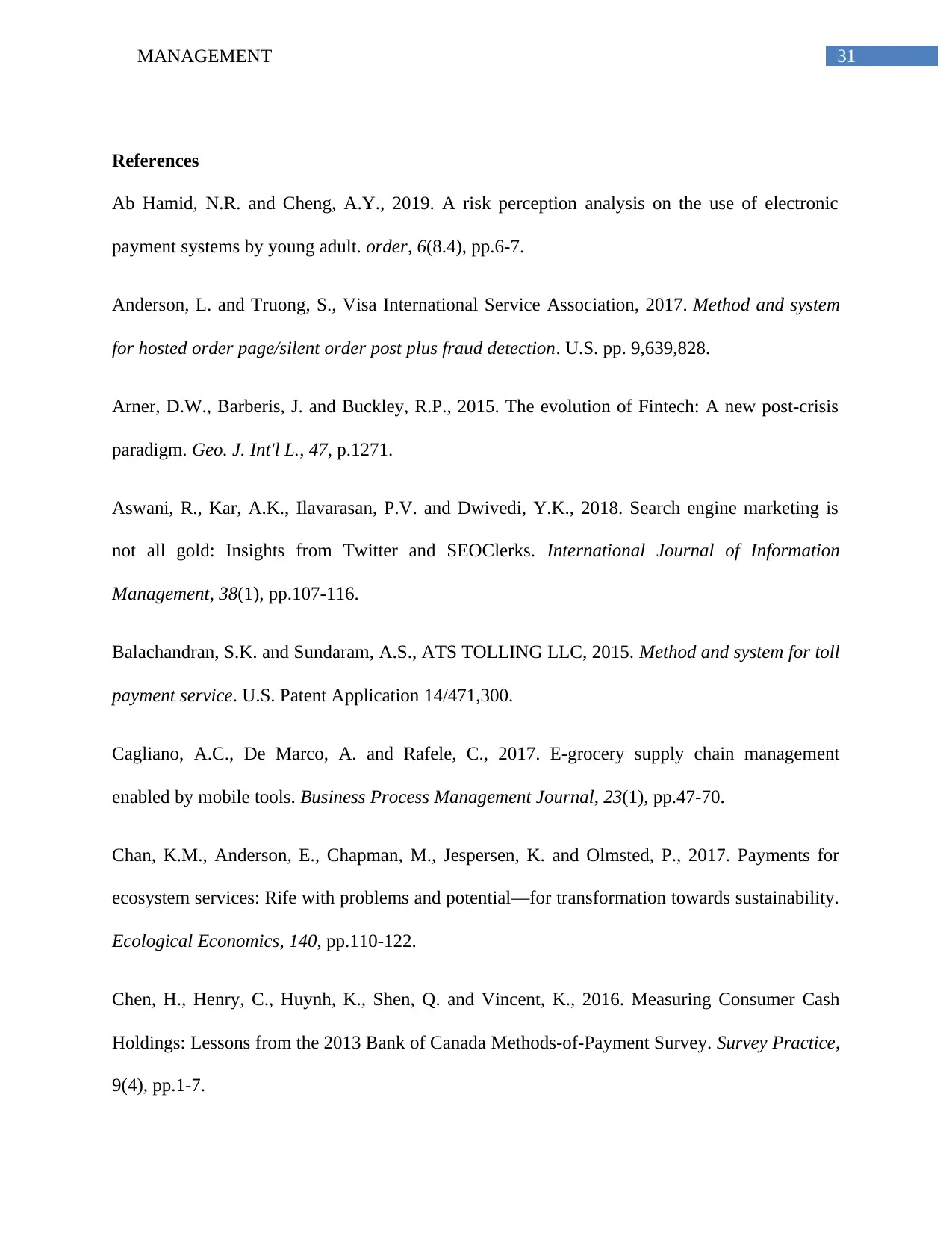
31MANAGEMENT
References
Ab Hamid, N.R. and Cheng, A.Y., 2019. A risk perception analysis on the use of electronic
payment systems by young adult. order, 6(8.4), pp.6-7.
Anderson, L. and Truong, S., Visa International Service Association, 2017. Method and system
for hosted order page/silent order post plus fraud detection. U.S. pp. 9,639,828.
Arner, D.W., Barberis, J. and Buckley, R.P., 2015. The evolution of Fintech: A new post-crisis
paradigm. Geo. J. Int'l L., 47, p.1271.
Aswani, R., Kar, A.K., Ilavarasan, P.V. and Dwivedi, Y.K., 2018. Search engine marketing is
not all gold: Insights from Twitter and SEOClerks. International Journal of Information
Management, 38(1), pp.107-116.
Balachandran, S.K. and Sundaram, A.S., ATS TOLLING LLC, 2015. Method and system for toll
payment service. U.S. Patent Application 14/471,300.
Cagliano, A.C., De Marco, A. and Rafele, C., 2017. E-grocery supply chain management
enabled by mobile tools. Business Process Management Journal, 23(1), pp.47-70.
Chan, K.M., Anderson, E., Chapman, M., Jespersen, K. and Olmsted, P., 2017. Payments for
ecosystem services: Rife with problems and potential—for transformation towards sustainability.
Ecological Economics, 140, pp.110-122.
Chen, H., Henry, C., Huynh, K., Shen, Q. and Vincent, K., 2016. Measuring Consumer Cash
Holdings: Lessons from the 2013 Bank of Canada Methods-of-Payment Survey. Survey Practice,
9(4), pp.1-7.
References
Ab Hamid, N.R. and Cheng, A.Y., 2019. A risk perception analysis on the use of electronic
payment systems by young adult. order, 6(8.4), pp.6-7.
Anderson, L. and Truong, S., Visa International Service Association, 2017. Method and system
for hosted order page/silent order post plus fraud detection. U.S. pp. 9,639,828.
Arner, D.W., Barberis, J. and Buckley, R.P., 2015. The evolution of Fintech: A new post-crisis
paradigm. Geo. J. Int'l L., 47, p.1271.
Aswani, R., Kar, A.K., Ilavarasan, P.V. and Dwivedi, Y.K., 2018. Search engine marketing is
not all gold: Insights from Twitter and SEOClerks. International Journal of Information
Management, 38(1), pp.107-116.
Balachandran, S.K. and Sundaram, A.S., ATS TOLLING LLC, 2015. Method and system for toll
payment service. U.S. Patent Application 14/471,300.
Cagliano, A.C., De Marco, A. and Rafele, C., 2017. E-grocery supply chain management
enabled by mobile tools. Business Process Management Journal, 23(1), pp.47-70.
Chan, K.M., Anderson, E., Chapman, M., Jespersen, K. and Olmsted, P., 2017. Payments for
ecosystem services: Rife with problems and potential—for transformation towards sustainability.
Ecological Economics, 140, pp.110-122.
Chen, H., Henry, C., Huynh, K., Shen, Q. and Vincent, K., 2016. Measuring Consumer Cash
Holdings: Lessons from the 2013 Bank of Canada Methods-of-Payment Survey. Survey Practice,
9(4), pp.1-7.
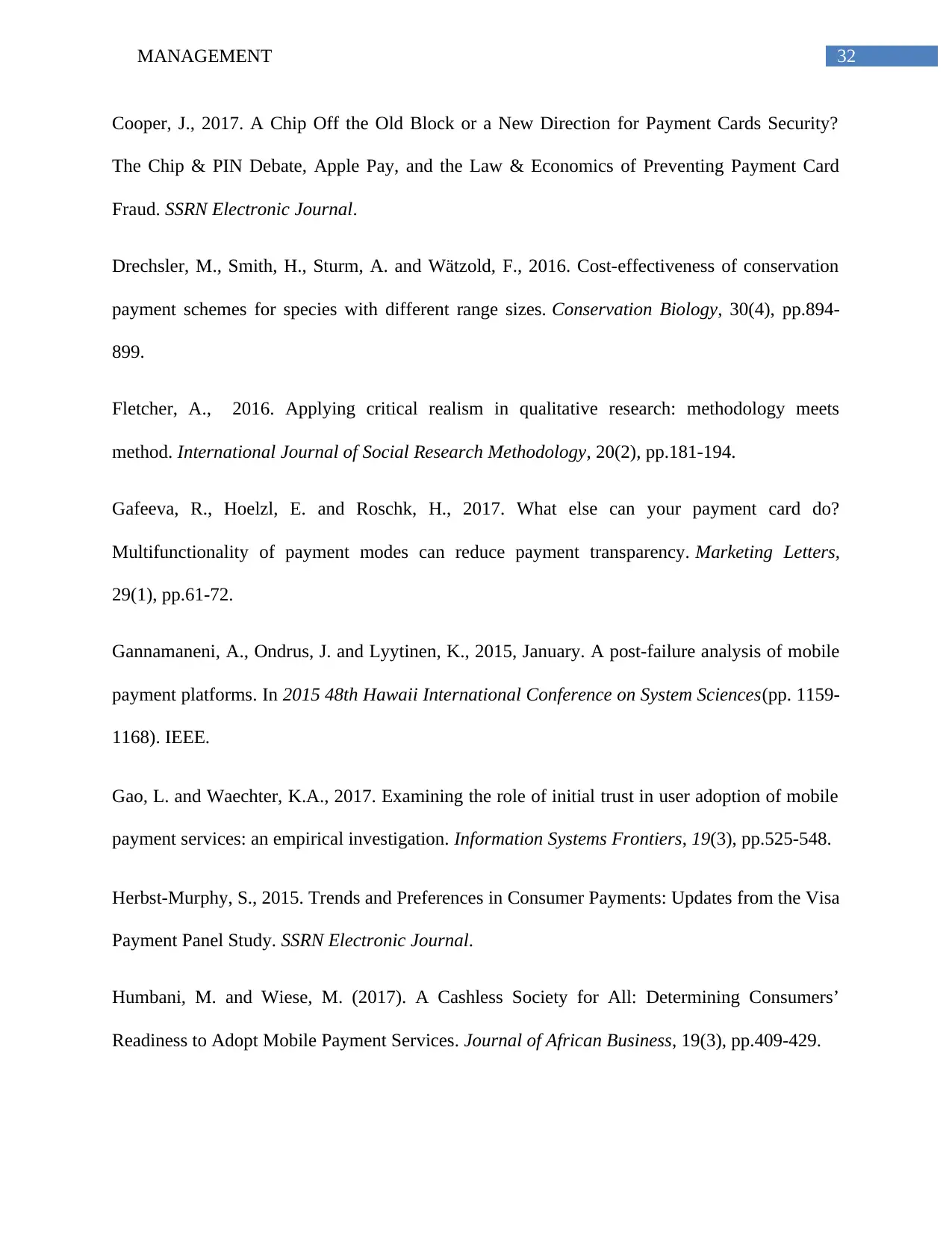
32MANAGEMENT
Cooper, J., 2017. A Chip Off the Old Block or a New Direction for Payment Cards Security?
The Chip & PIN Debate, Apple Pay, and the Law & Economics of Preventing Payment Card
Fraud. SSRN Electronic Journal.
Drechsler, M., Smith, H., Sturm, A. and Wätzold, F., 2016. Cost-effectiveness of conservation
payment schemes for species with different range sizes. Conservation Biology, 30(4), pp.894-
899.
Fletcher, A., 2016. Applying critical realism in qualitative research: methodology meets
method. International Journal of Social Research Methodology, 20(2), pp.181-194.
Gafeeva, R., Hoelzl, E. and Roschk, H., 2017. What else can your payment card do?
Multifunctionality of payment modes can reduce payment transparency. Marketing Letters,
29(1), pp.61-72.
Gannamaneni, A., Ondrus, J. and Lyytinen, K., 2015, January. A post-failure analysis of mobile
payment platforms. In 2015 48th Hawaii International Conference on System Sciences(pp. 1159-
1168). IEEE.
Gao, L. and Waechter, K.A., 2017. Examining the role of initial trust in user adoption of mobile
payment services: an empirical investigation. Information Systems Frontiers, 19(3), pp.525-548.
Herbst-Murphy, S., 2015. Trends and Preferences in Consumer Payments: Updates from the Visa
Payment Panel Study. SSRN Electronic Journal.
Humbani, M. and Wiese, M. (2017). A Cashless Society for All: Determining Consumers’
Readiness to Adopt Mobile Payment Services. Journal of African Business, 19(3), pp.409-429.
Cooper, J., 2017. A Chip Off the Old Block or a New Direction for Payment Cards Security?
The Chip & PIN Debate, Apple Pay, and the Law & Economics of Preventing Payment Card
Fraud. SSRN Electronic Journal.
Drechsler, M., Smith, H., Sturm, A. and Wätzold, F., 2016. Cost-effectiveness of conservation
payment schemes for species with different range sizes. Conservation Biology, 30(4), pp.894-
899.
Fletcher, A., 2016. Applying critical realism in qualitative research: methodology meets
method. International Journal of Social Research Methodology, 20(2), pp.181-194.
Gafeeva, R., Hoelzl, E. and Roschk, H., 2017. What else can your payment card do?
Multifunctionality of payment modes can reduce payment transparency. Marketing Letters,
29(1), pp.61-72.
Gannamaneni, A., Ondrus, J. and Lyytinen, K., 2015, January. A post-failure analysis of mobile
payment platforms. In 2015 48th Hawaii International Conference on System Sciences(pp. 1159-
1168). IEEE.
Gao, L. and Waechter, K.A., 2017. Examining the role of initial trust in user adoption of mobile
payment services: an empirical investigation. Information Systems Frontiers, 19(3), pp.525-548.
Herbst-Murphy, S., 2015. Trends and Preferences in Consumer Payments: Updates from the Visa
Payment Panel Study. SSRN Electronic Journal.
Humbani, M. and Wiese, M. (2017). A Cashless Society for All: Determining Consumers’
Readiness to Adopt Mobile Payment Services. Journal of African Business, 19(3), pp.409-429.
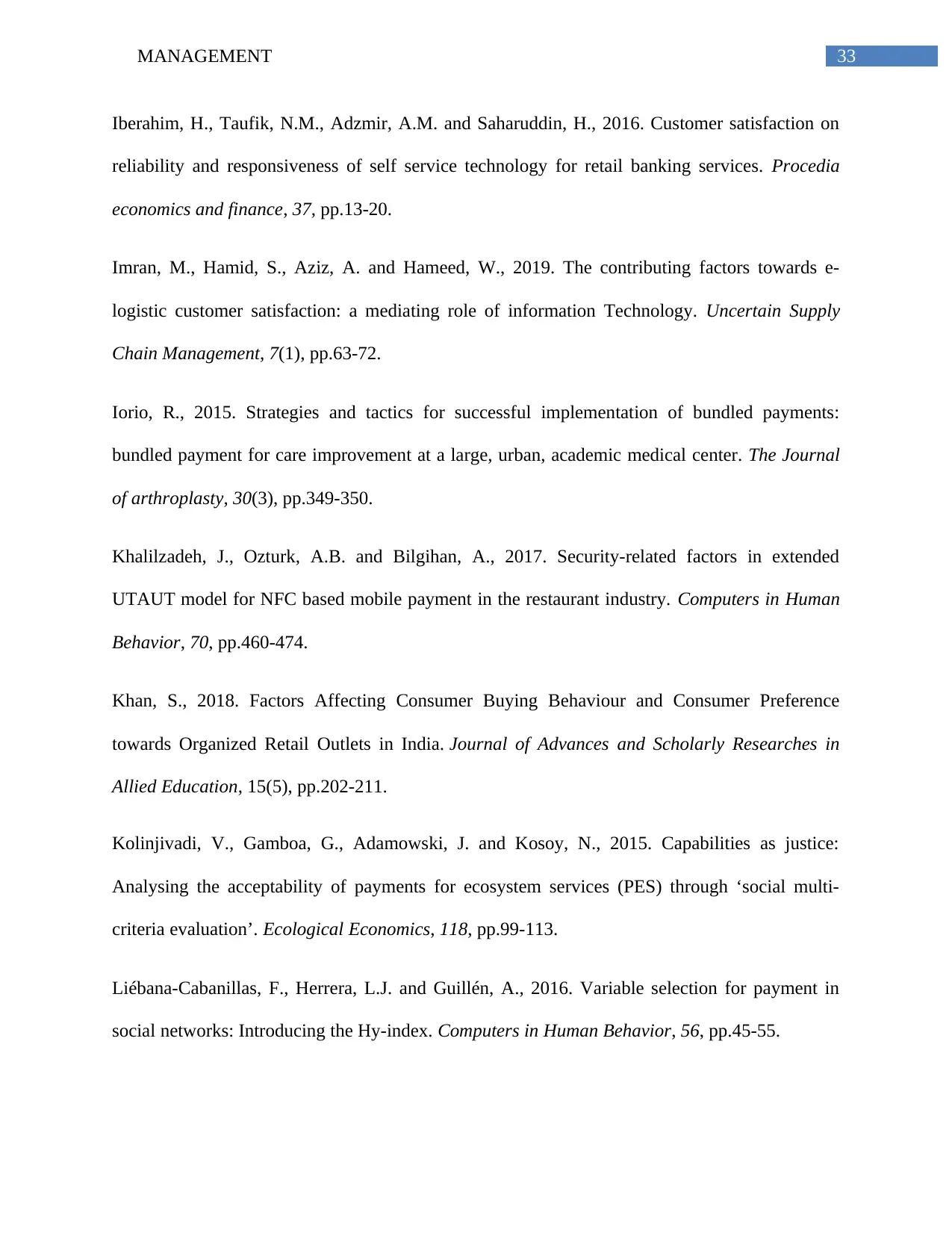
33MANAGEMENT
Iberahim, H., Taufik, N.M., Adzmir, A.M. and Saharuddin, H., 2016. Customer satisfaction on
reliability and responsiveness of self service technology for retail banking services. Procedia
economics and finance, 37, pp.13-20.
Imran, M., Hamid, S., Aziz, A. and Hameed, W., 2019. The contributing factors towards e-
logistic customer satisfaction: a mediating role of information Technology. Uncertain Supply
Chain Management, 7(1), pp.63-72.
Iorio, R., 2015. Strategies and tactics for successful implementation of bundled payments:
bundled payment for care improvement at a large, urban, academic medical center. The Journal
of arthroplasty, 30(3), pp.349-350.
Khalilzadeh, J., Ozturk, A.B. and Bilgihan, A., 2017. Security-related factors in extended
UTAUT model for NFC based mobile payment in the restaurant industry. Computers in Human
Behavior, 70, pp.460-474.
Khan, S., 2018. Factors Affecting Consumer Buying Behaviour and Consumer Preference
towards Organized Retail Outlets in India. Journal of Advances and Scholarly Researches in
Allied Education, 15(5), pp.202-211.
Kolinjivadi, V., Gamboa, G., Adamowski, J. and Kosoy, N., 2015. Capabilities as justice:
Analysing the acceptability of payments for ecosystem services (PES) through ‘social multi-
criteria evaluation’. Ecological Economics, 118, pp.99-113.
Liébana-Cabanillas, F., Herrera, L.J. and Guillén, A., 2016. Variable selection for payment in
social networks: Introducing the Hy-index. Computers in Human Behavior, 56, pp.45-55.
Iberahim, H., Taufik, N.M., Adzmir, A.M. and Saharuddin, H., 2016. Customer satisfaction on
reliability and responsiveness of self service technology for retail banking services. Procedia
economics and finance, 37, pp.13-20.
Imran, M., Hamid, S., Aziz, A. and Hameed, W., 2019. The contributing factors towards e-
logistic customer satisfaction: a mediating role of information Technology. Uncertain Supply
Chain Management, 7(1), pp.63-72.
Iorio, R., 2015. Strategies and tactics for successful implementation of bundled payments:
bundled payment for care improvement at a large, urban, academic medical center. The Journal
of arthroplasty, 30(3), pp.349-350.
Khalilzadeh, J., Ozturk, A.B. and Bilgihan, A., 2017. Security-related factors in extended
UTAUT model for NFC based mobile payment in the restaurant industry. Computers in Human
Behavior, 70, pp.460-474.
Khan, S., 2018. Factors Affecting Consumer Buying Behaviour and Consumer Preference
towards Organized Retail Outlets in India. Journal of Advances and Scholarly Researches in
Allied Education, 15(5), pp.202-211.
Kolinjivadi, V., Gamboa, G., Adamowski, J. and Kosoy, N., 2015. Capabilities as justice:
Analysing the acceptability of payments for ecosystem services (PES) through ‘social multi-
criteria evaluation’. Ecological Economics, 118, pp.99-113.
Liébana-Cabanillas, F., Herrera, L.J. and Guillén, A., 2016. Variable selection for payment in
social networks: Introducing the Hy-index. Computers in Human Behavior, 56, pp.45-55.
Secure Best Marks with AI Grader
Need help grading? Try our AI Grader for instant feedback on your assignments.
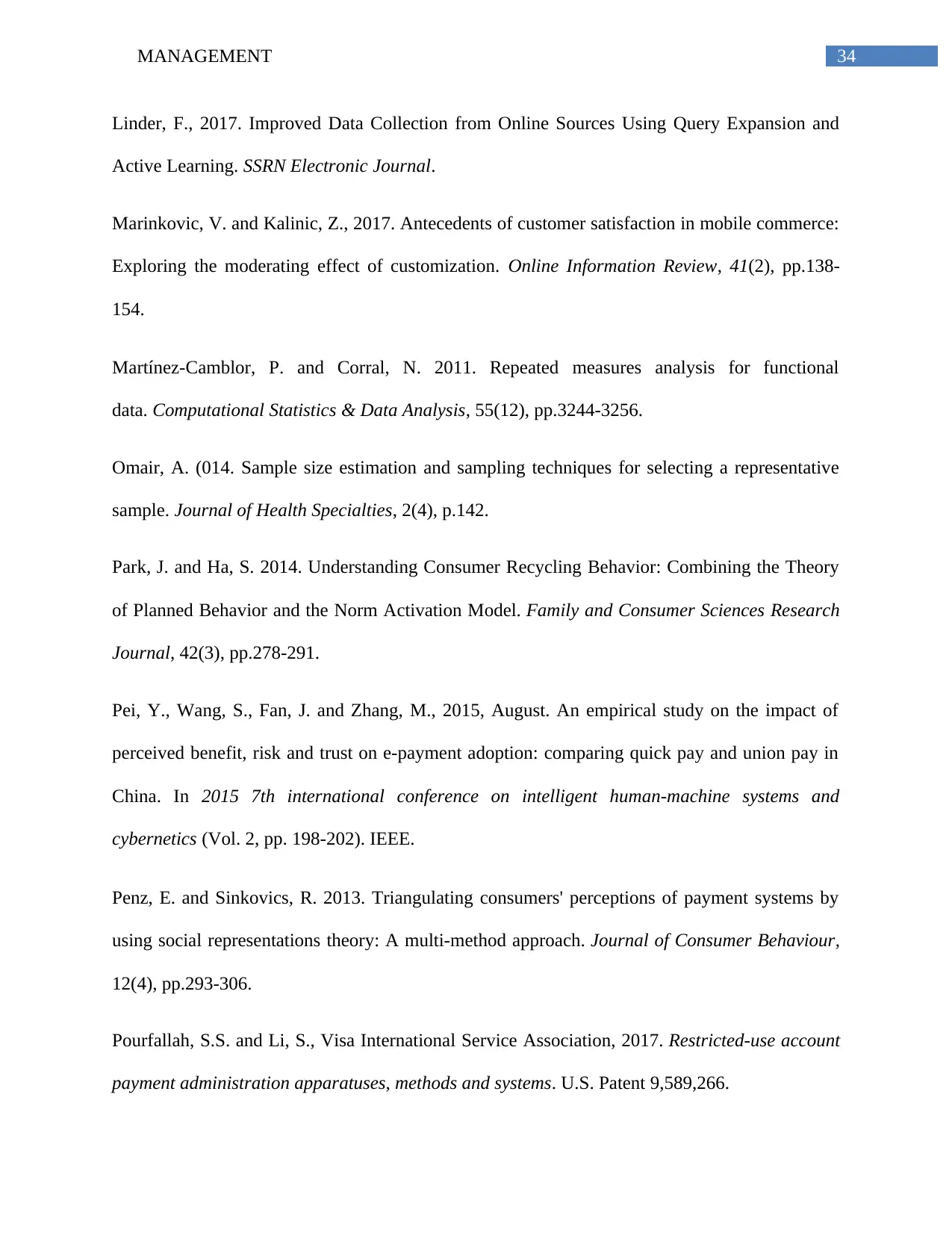
34MANAGEMENT
Linder, F., 2017. Improved Data Collection from Online Sources Using Query Expansion and
Active Learning. SSRN Electronic Journal.
Marinkovic, V. and Kalinic, Z., 2017. Antecedents of customer satisfaction in mobile commerce:
Exploring the moderating effect of customization. Online Information Review, 41(2), pp.138-
154.
Martínez-Camblor, P. and Corral, N. 2011. Repeated measures analysis for functional
data. Computational Statistics & Data Analysis, 55(12), pp.3244-3256.
Omair, A. (014. Sample size estimation and sampling techniques for selecting a representative
sample. Journal of Health Specialties, 2(4), p.142.
Park, J. and Ha, S. 2014. Understanding Consumer Recycling Behavior: Combining the Theory
of Planned Behavior and the Norm Activation Model. Family and Consumer Sciences Research
Journal, 42(3), pp.278-291.
Pei, Y., Wang, S., Fan, J. and Zhang, M., 2015, August. An empirical study on the impact of
perceived benefit, risk and trust on e-payment adoption: comparing quick pay and union pay in
China. In 2015 7th international conference on intelligent human-machine systems and
cybernetics (Vol. 2, pp. 198-202). IEEE.
Penz, E. and Sinkovics, R. 2013. Triangulating consumers' perceptions of payment systems by
using social representations theory: A multi-method approach. Journal of Consumer Behaviour,
12(4), pp.293-306.
Pourfallah, S.S. and Li, S., Visa International Service Association, 2017. Restricted-use account
payment administration apparatuses, methods and systems. U.S. Patent 9,589,266.
Linder, F., 2017. Improved Data Collection from Online Sources Using Query Expansion and
Active Learning. SSRN Electronic Journal.
Marinkovic, V. and Kalinic, Z., 2017. Antecedents of customer satisfaction in mobile commerce:
Exploring the moderating effect of customization. Online Information Review, 41(2), pp.138-
154.
Martínez-Camblor, P. and Corral, N. 2011. Repeated measures analysis for functional
data. Computational Statistics & Data Analysis, 55(12), pp.3244-3256.
Omair, A. (014. Sample size estimation and sampling techniques for selecting a representative
sample. Journal of Health Specialties, 2(4), p.142.
Park, J. and Ha, S. 2014. Understanding Consumer Recycling Behavior: Combining the Theory
of Planned Behavior and the Norm Activation Model. Family and Consumer Sciences Research
Journal, 42(3), pp.278-291.
Pei, Y., Wang, S., Fan, J. and Zhang, M., 2015, August. An empirical study on the impact of
perceived benefit, risk and trust on e-payment adoption: comparing quick pay and union pay in
China. In 2015 7th international conference on intelligent human-machine systems and
cybernetics (Vol. 2, pp. 198-202). IEEE.
Penz, E. and Sinkovics, R. 2013. Triangulating consumers' perceptions of payment systems by
using social representations theory: A multi-method approach. Journal of Consumer Behaviour,
12(4), pp.293-306.
Pourfallah, S.S. and Li, S., Visa International Service Association, 2017. Restricted-use account
payment administration apparatuses, methods and systems. U.S. Patent 9,589,266.
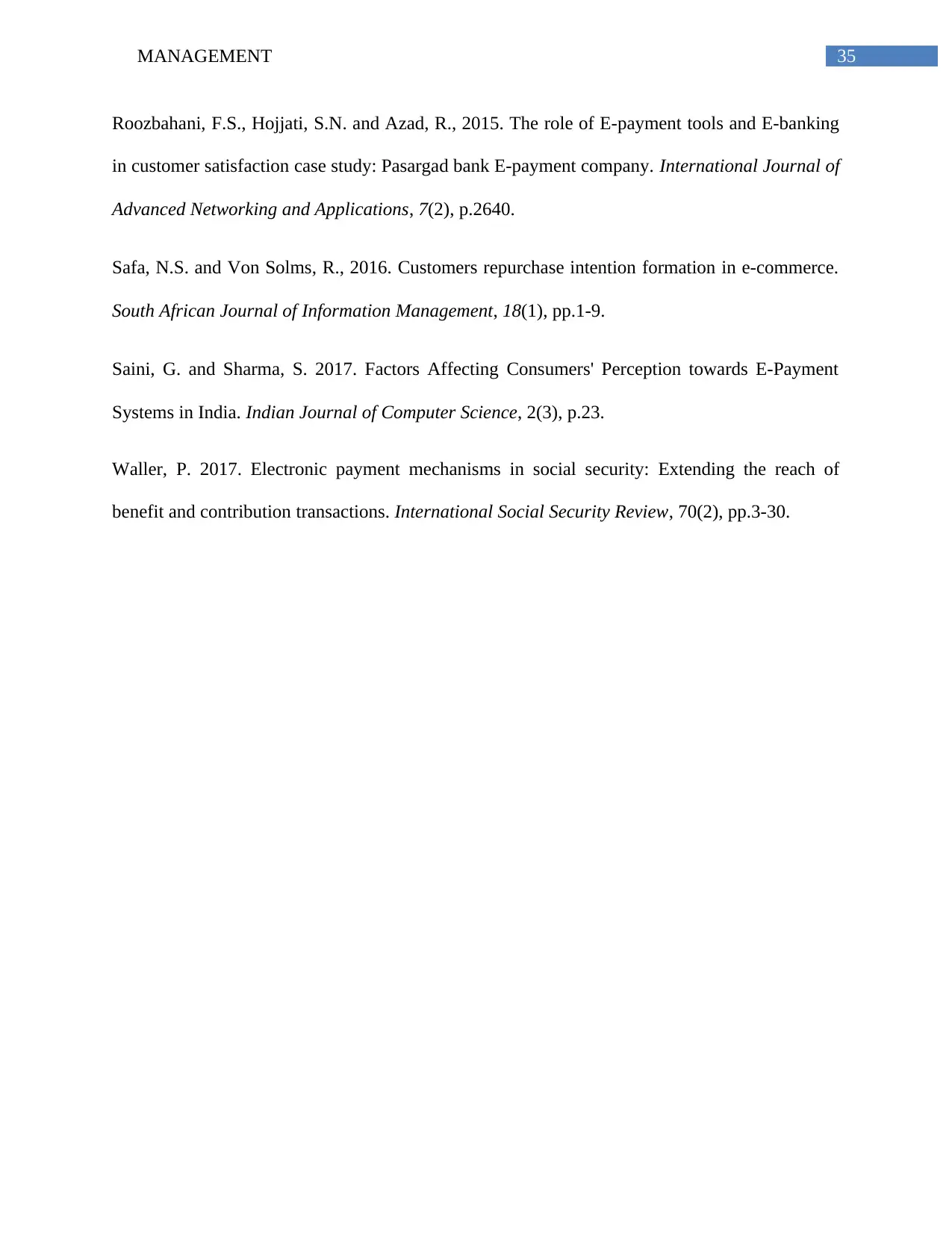
35MANAGEMENT
Roozbahani, F.S., Hojjati, S.N. and Azad, R., 2015. The role of E-payment tools and E-banking
in customer satisfaction case study: Pasargad bank E-payment company. International Journal of
Advanced Networking and Applications, 7(2), p.2640.
Safa, N.S. and Von Solms, R., 2016. Customers repurchase intention formation in e-commerce.
South African Journal of Information Management, 18(1), pp.1-9.
Saini, G. and Sharma, S. 2017. Factors Affecting Consumers' Perception towards E-Payment
Systems in India. Indian Journal of Computer Science, 2(3), p.23.
Waller, P. 2017. Electronic payment mechanisms in social security: Extending the reach of
benefit and contribution transactions. International Social Security Review, 70(2), pp.3-30.
Roozbahani, F.S., Hojjati, S.N. and Azad, R., 2015. The role of E-payment tools and E-banking
in customer satisfaction case study: Pasargad bank E-payment company. International Journal of
Advanced Networking and Applications, 7(2), p.2640.
Safa, N.S. and Von Solms, R., 2016. Customers repurchase intention formation in e-commerce.
South African Journal of Information Management, 18(1), pp.1-9.
Saini, G. and Sharma, S. 2017. Factors Affecting Consumers' Perception towards E-Payment
Systems in India. Indian Journal of Computer Science, 2(3), p.23.
Waller, P. 2017. Electronic payment mechanisms in social security: Extending the reach of
benefit and contribution transactions. International Social Security Review, 70(2), pp.3-30.
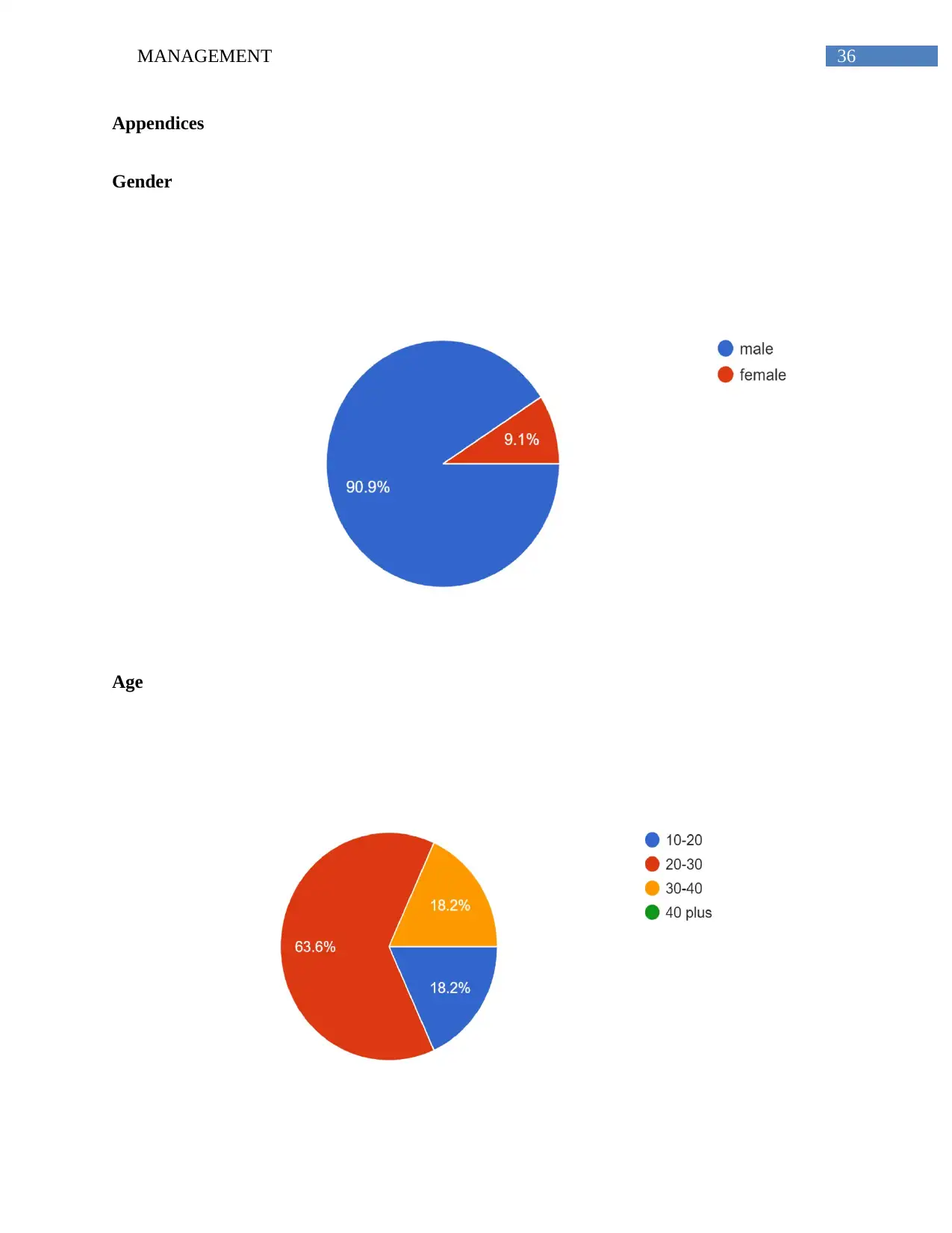
36MANAGEMENT
Appendices
Gender
Age
Appendices
Gender
Age
Paraphrase This Document
Need a fresh take? Get an instant paraphrase of this document with our AI Paraphraser
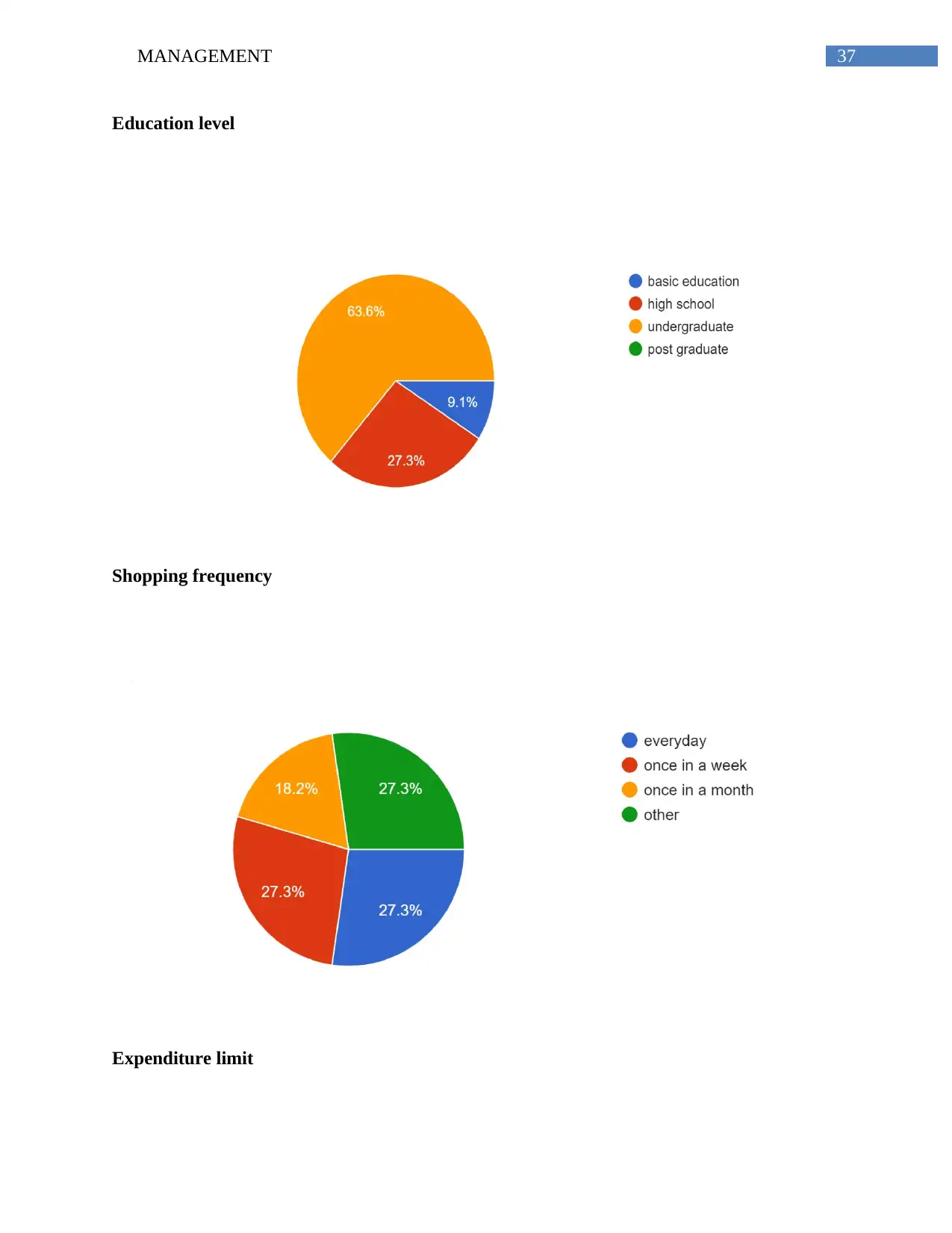
37MANAGEMENT
Education level
Shopping frequency
Expenditure limit
Education level
Shopping frequency
Expenditure limit
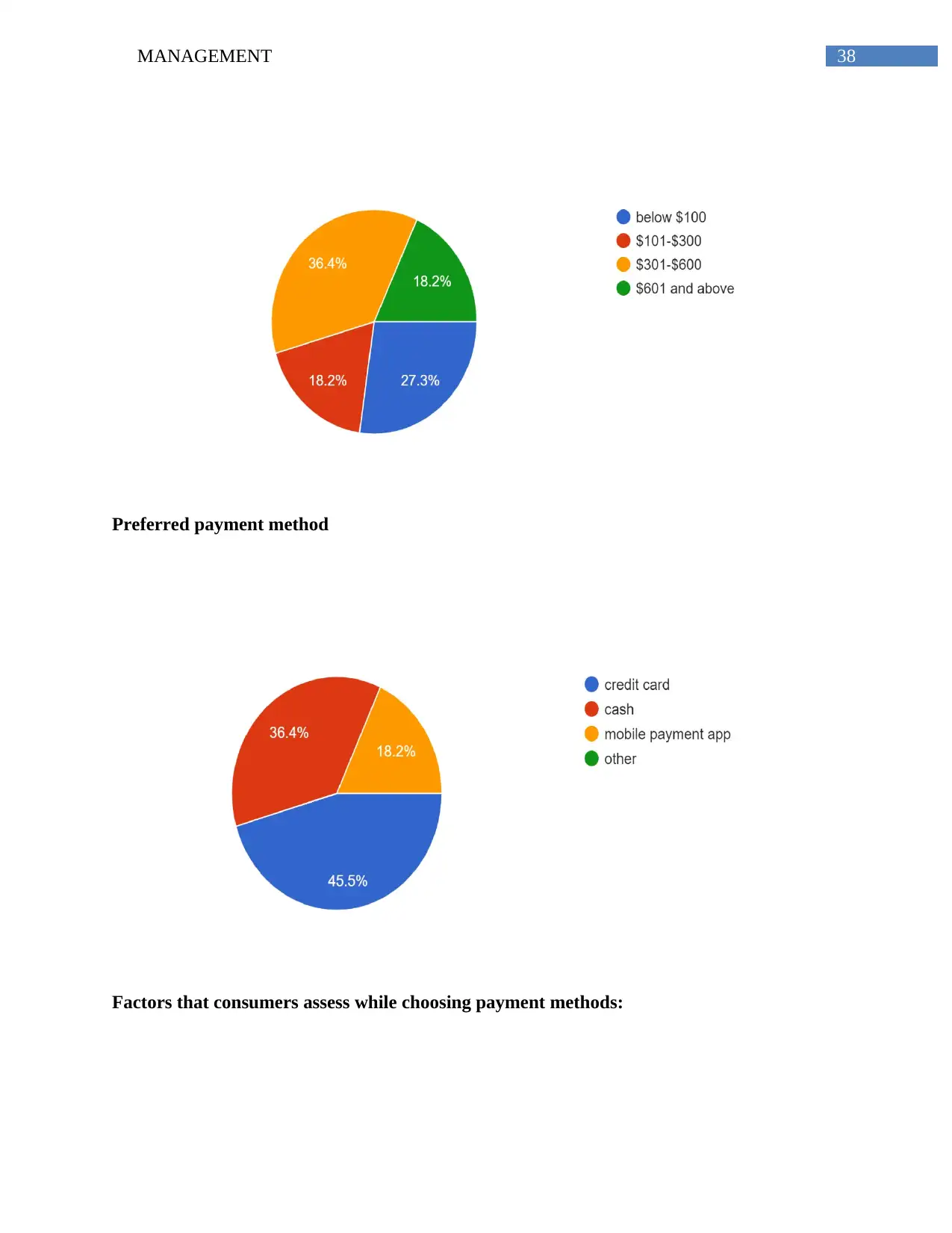
38MANAGEMENT
Preferred payment method
Factors that consumers assess while choosing payment methods:
Preferred payment method
Factors that consumers assess while choosing payment methods:
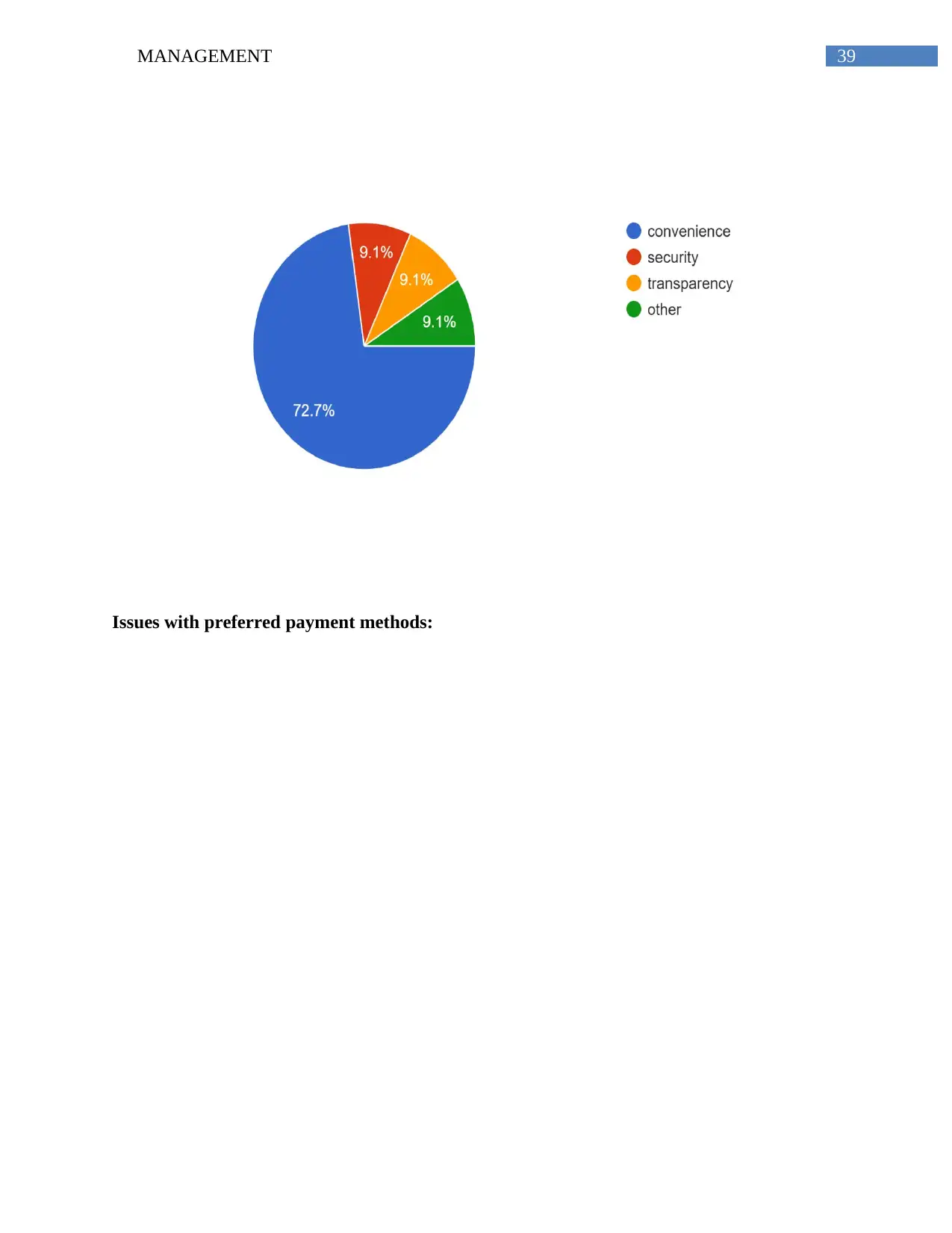
39MANAGEMENT
Issues with preferred payment methods:
Issues with preferred payment methods:
Secure Best Marks with AI Grader
Need help grading? Try our AI Grader for instant feedback on your assignments.
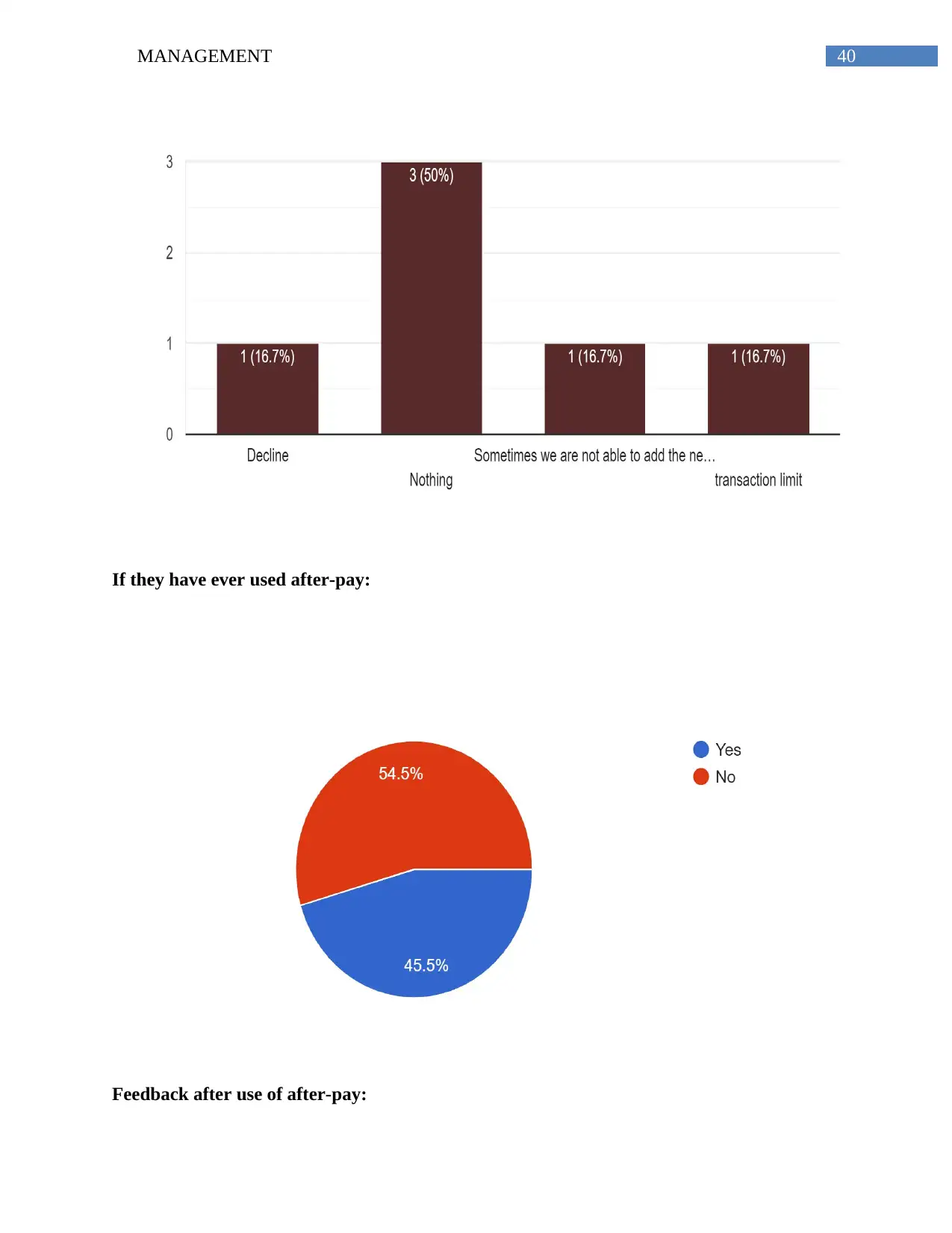
40MANAGEMENT
If they have ever used after-pay:
Feedback after use of after-pay:
If they have ever used after-pay:
Feedback after use of after-pay:
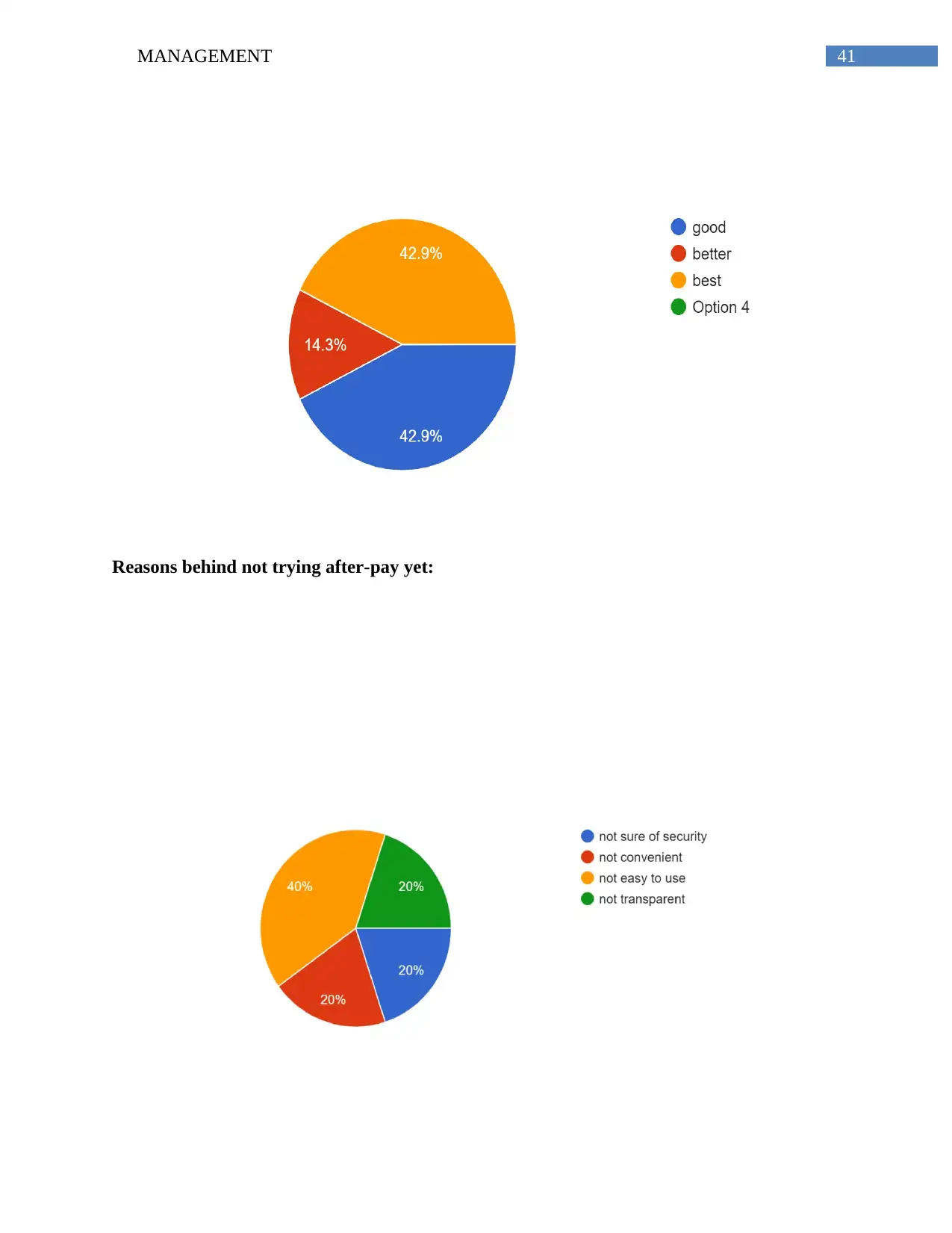
41MANAGEMENT
Reasons behind not trying after-pay yet:
Reasons behind not trying after-pay yet:
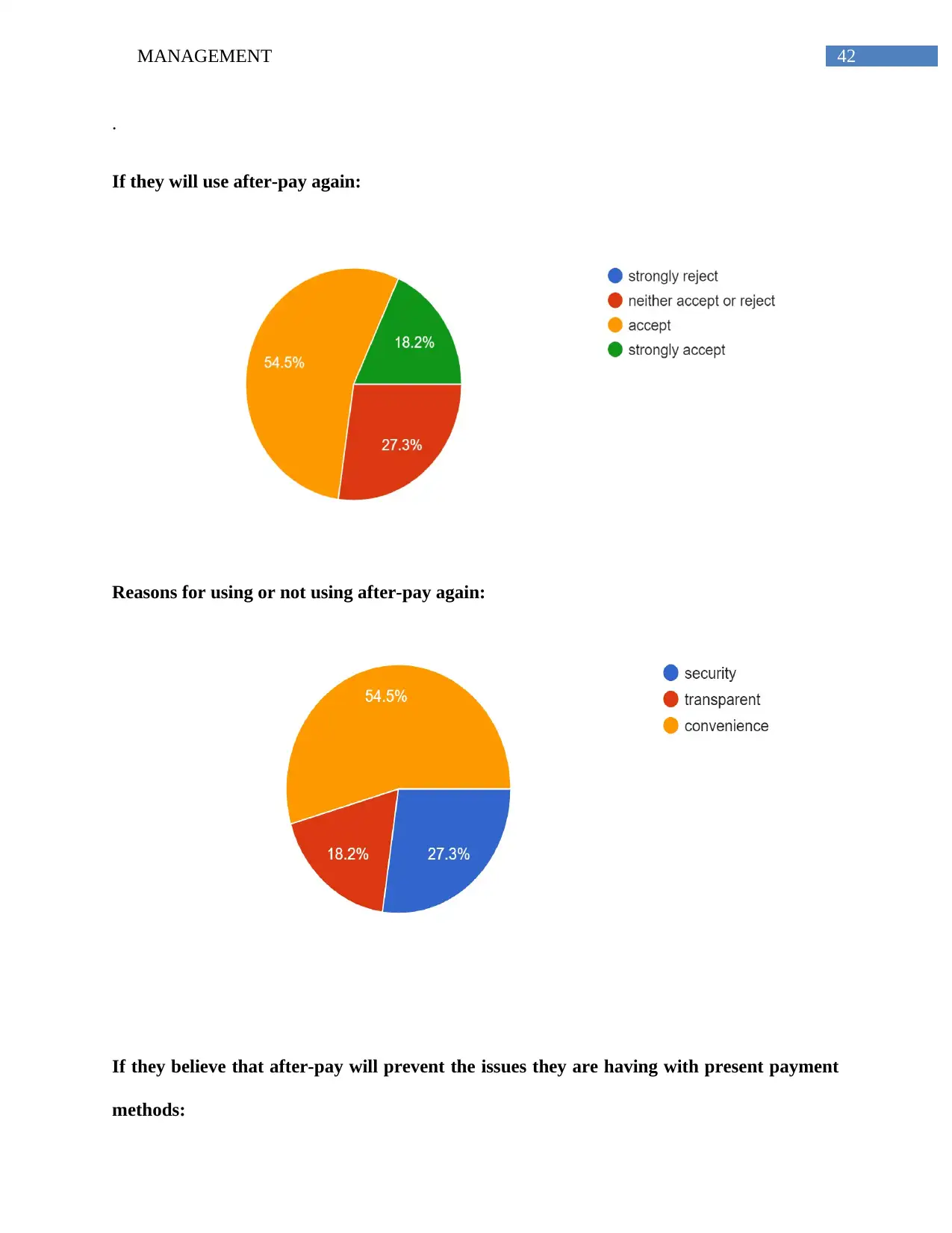
42MANAGEMENT
.
If they will use after-pay again:
Reasons for using or not using after-pay again:
If they believe that after-pay will prevent the issues they are having with present payment
methods:
.
If they will use after-pay again:
Reasons for using or not using after-pay again:
If they believe that after-pay will prevent the issues they are having with present payment
methods:
Paraphrase This Document
Need a fresh take? Get an instant paraphrase of this document with our AI Paraphraser
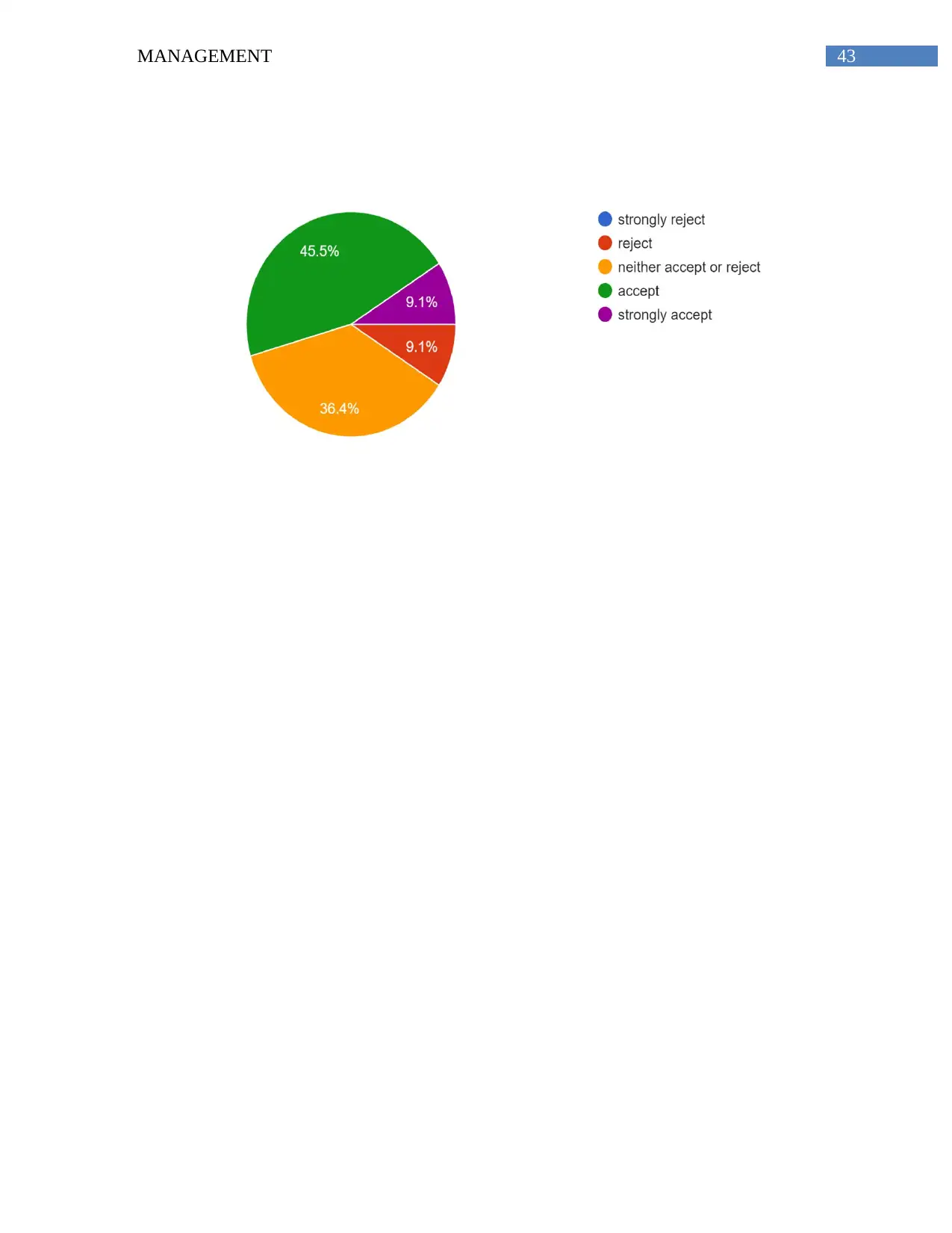
43MANAGEMENT
1 out of 44
Related Documents
Your All-in-One AI-Powered Toolkit for Academic Success.
+13062052269
info@desklib.com
Available 24*7 on WhatsApp / Email
![[object Object]](/_next/static/media/star-bottom.7253800d.svg)
Unlock your academic potential
© 2024 | Zucol Services PVT LTD | All rights reserved.





